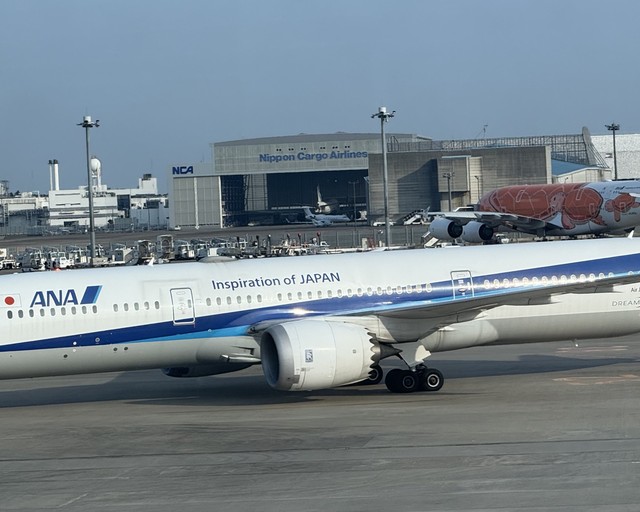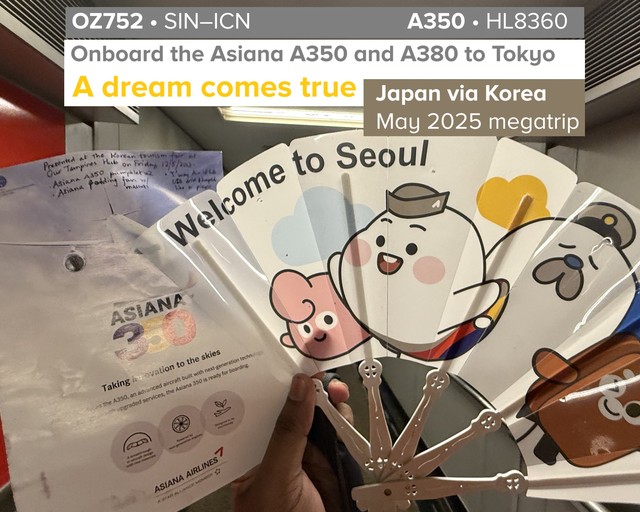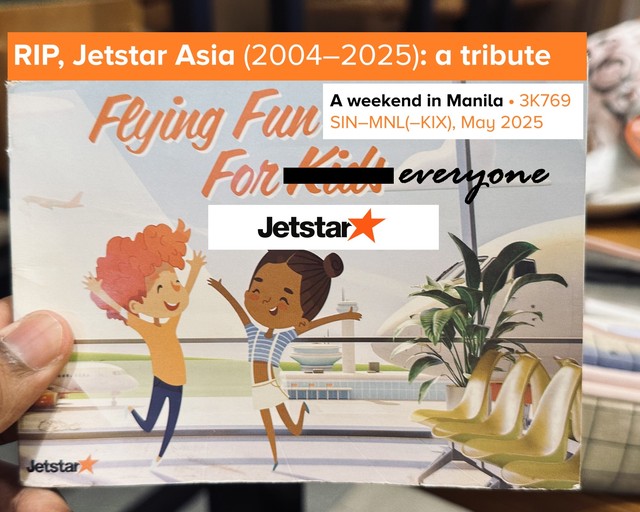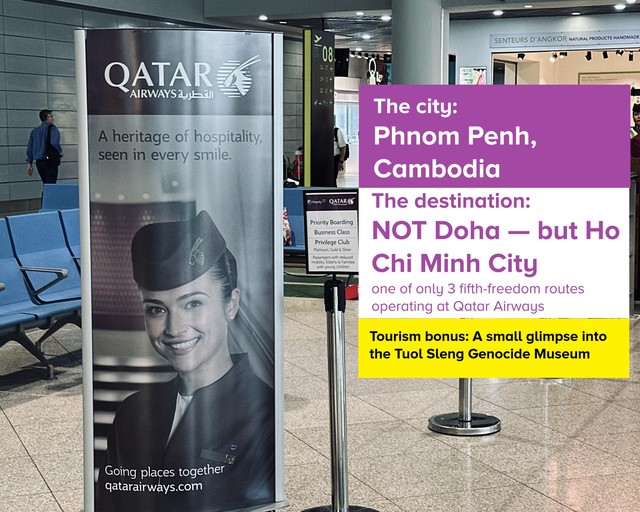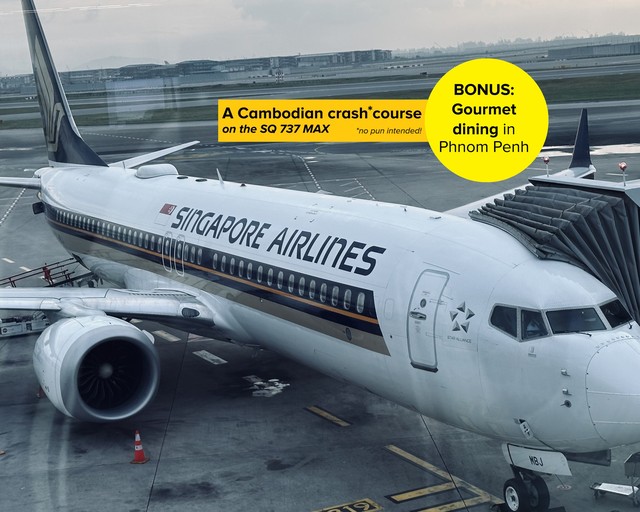Okay, I didn’t really intend to publish this report, because it’s my least favourite aircraft anyway, and besides, it won’t add a lot of (or any value) to my credibility, but… I think it’ll be unfair to the connecting 777-300ER flight if I weren’t to cover it, plus I think the somewhat unconventional style of this report is at least a little different from usual… so here goes.
This trip report contains two legs: the 777-200ER from Bengaluru to Bangkok, and the onward 777-300ER to Singapore. However, only the former flight’s seat details have been filled in above.
Old ‘witch’ Phetchabun gets her revenge
I trust this will be the final opporunity I have to rant against the Thai Airways 777-200ER, and this time I’m going to have a different spin on it compared to the previous ones.
This trip report will partly be in the form of a conversation between me and my ‘captor’ for three hours — you guessed it, my bête noire HS-TJW a.k.a. Phetchabun — as you’ll see in my photo captions. This Thai Airways 777-200ER went out of her way to make my experience as miserable as possible, and earned the infamous distinction of being the first registration I had the misfortune of flying three times. Having already served the inbound sector into Bengaluru on 6 August — though that was much more tolerable, if not borderline enjoyable-in-an-ironic-way! — the same aircraft would, much to my horror, also take me out of the South Indian tech capital… exactly when I’d wanted the A350 in its place.
Due to their never-refurbished product, I never liked TG 777-200ERs in the first place, and have ranted unendingly about them on this website after being forced to fly them once, twice and thrice. Not to mention, that was far from my first rendezvous with this beast, having already flown HS-TJW in 2022. Another instance in November 2023 resulted in, sadly, HS-TJR — TG’s oldest aircraft today after A340s, 747s and non-ER 777s were retired — becoming the only HS-registered aircraft that I flew that year.
I booked another BLR trip in August 2024 to try to fly the TG A350, as I’d not got any since first flying them in June 2022. I’d been hoping for some A350s on TG after a pair of Cathay Pacific A350s at the start (plus a visit to the Thai Airways gift shop) — and, as a result, that had been my first day with three flights. But I was instead taught a lesson by this conniving old ‘witch’ of an aircraft, two times in succession — and the subsequent BKK–SIN connecting leg was also a 777, though the slightly newer -300ER, instead of an A350! You can only imagine the pain and hurt (no exaggeration) I’d been feeling. First-world problems…*
Still, I firmly believe that all bad things must come to an end. The days of 777-200ERs in the TG fleet are numbered, and with HS-TJS being put out to pasture in February 2025 and now HS-TJT in April, it will be only a matter of a couple of years before the remaining 3 aging birds — HS-TJR, TJV and TJW, since HS-TJU never returned to the fleet after COVID retirement — head for either the scrapyard or a new owner. TG has nicely been refurbishing its fleet, with A321neos — featuring Thompson Vantage lie-flat business-class seats (the same as Singapore Airlines’ 737 MAXes) — due to enter by late 2025, plus second-hand A330-300s from Virgin Atlantic and A330-200s from American Airlines. There are some airlines in Southeast Asia — cough, Garuda Indonesia, cough — which have been completely crippled by financial and strategy problems, with a drastically reduced fleet and network, but fortunately Thai Airways no longer is one of them.
*It was only later in August 2024 — on a one-night weekend journey (the one with picture postcards) — and then in November on the same BLR–BKK–SIN routing that A350 HS-THN stepped up to break the jinx. In the process, HS-THN matched TJW’s record of being flown thrice, and finally broke my rotten luck of getting only 777-200ERs when departing Indian shores on Thai Airways.
The flights: Brief information
Flights: Thai Airways International TG326 and TG403
Date: Sunday, 11 August 2024
Route: Bengaluru Kempegowda (VOBL/BLR) via Bangkok Suvarnabhumi (VTBS/BKK) to Singapore Changi (WSSS/SIN)
Aircraft: HS-TJW, Boeing 777-200ER, named Phetchabun, and HS-TKU, Boeing 777-300ER, named Acharasobhit
Overall duration: 8 hours across both flights; 12:40am IST (UTC +5:30) to 11:20am SGT (UTC +8)
Notes:
• The first leg was my fourth flight on the infamous, ancient Thai Airways 777-200ER — and my third on HS-TJW, which I’d already flown in June 2022 and the inbound TG325 to BLR on 6 August, unfortunately making this the first aircraft registration on which I had the misfortune to fly three times. I do hope I never have to set foot on this old beast again — especially as these are steadily being retired!
• The second leg was my first on TG’s 777-300ER, and only my second flight on Thai Airways which was on neither the A350 nor the 777-200ER — the first being on the 787-9, with rainbow mood lighting, in December 2022.
Flight routing
- 1
- 2
- 3TG326, TG403 | Bengaluru to Bangkok to Singapore | 11 August 2024 | 777-200ER HS-TJW Part 2; 777-300ER HS-TKU
- 4
Part 1: Almost missing the rendezvous with the old hag, thanks to traffic
Saturday, 10 August, evening. Having already found out that my return flight from Bengaluru to Bangkok would be ONCE AGAIN operated by the 777-200ER — specifically my arch-nemesis HS-TJW — after the same aircraft had operated the inbound TG325 on 6 August (which actually wasn’t as disappointing as I’d thought it would be), I was in a grim mood throughout the day.
But I chose to lighten the glum nature of the situation a bit. I decided to mock my own misery and have a laugh at my own expense, and it started by getting the courage to write my journal entry before — as opposed to after — the flight.
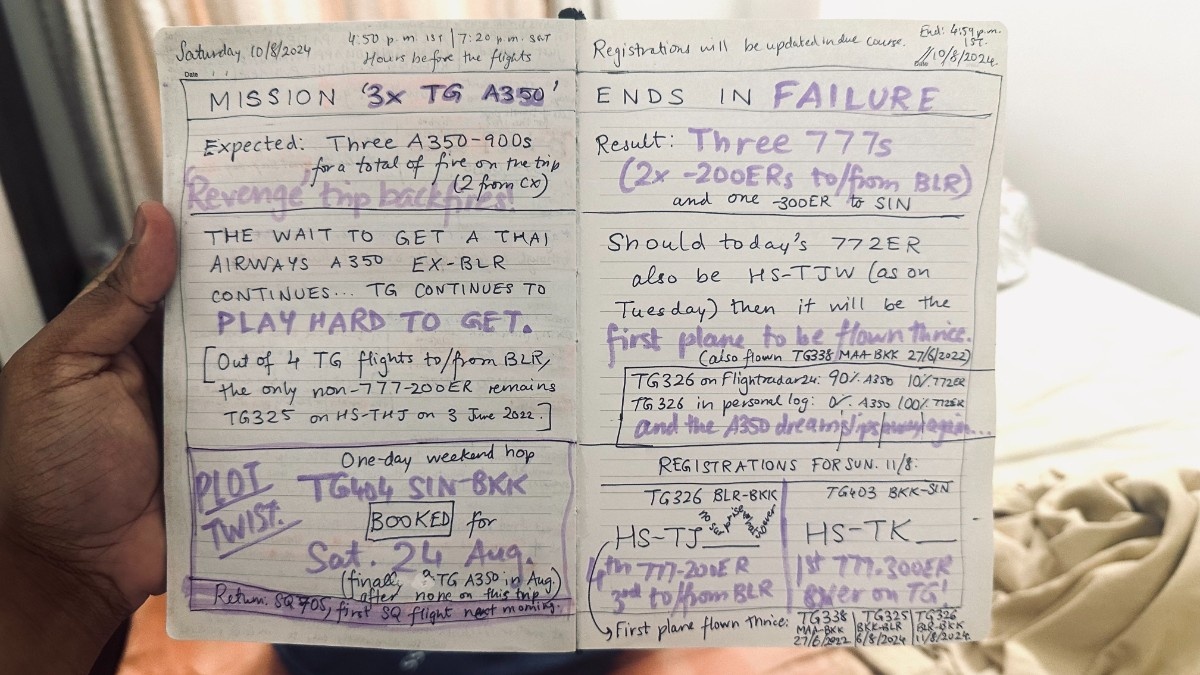
As if to add insult to injury, my phone’s featured photo widget had, in the spirit of schadenfreude, picked some of my choicest planespotting memories: a Vistara A321neo at Changi, an EVA 777-300ER at BKK (which I didn’t fly) and a Cathay A350 at its Hong Kong hub earlier that week — you know, the one with the mechanical delay.
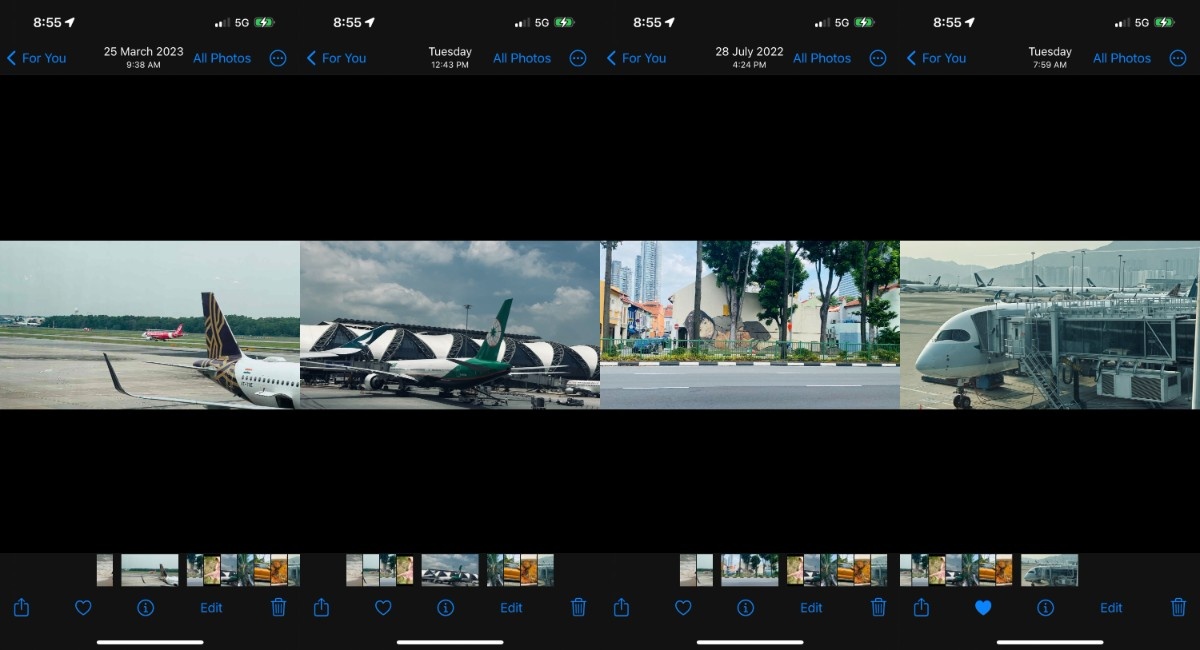
It was only at a quarter past 9 at night that we — my parents included — got into our usual rented-for-the-night Toyota Etios sedan, with a warning from the driver that it would take longer than usual to get to the airport (usually an 1.5-hour, 45-km drive) thanks to the August rains. At 9:20 we left our apartment complex in southern Bengaluru, barely 20 minutes from the prestigious IIM Bangalore campus on Bannerghatta Road — one of THE most coveted business schools in the country…*
*… and I’ve been selected to study there!!! I will leave Singapore, my home of nearly seven years, in early June 2025 and commence my two-year MBA progamme in IIM Bangalore.
Don’t expect many, or even any, trip reports during those months — the work hustle can be insane!
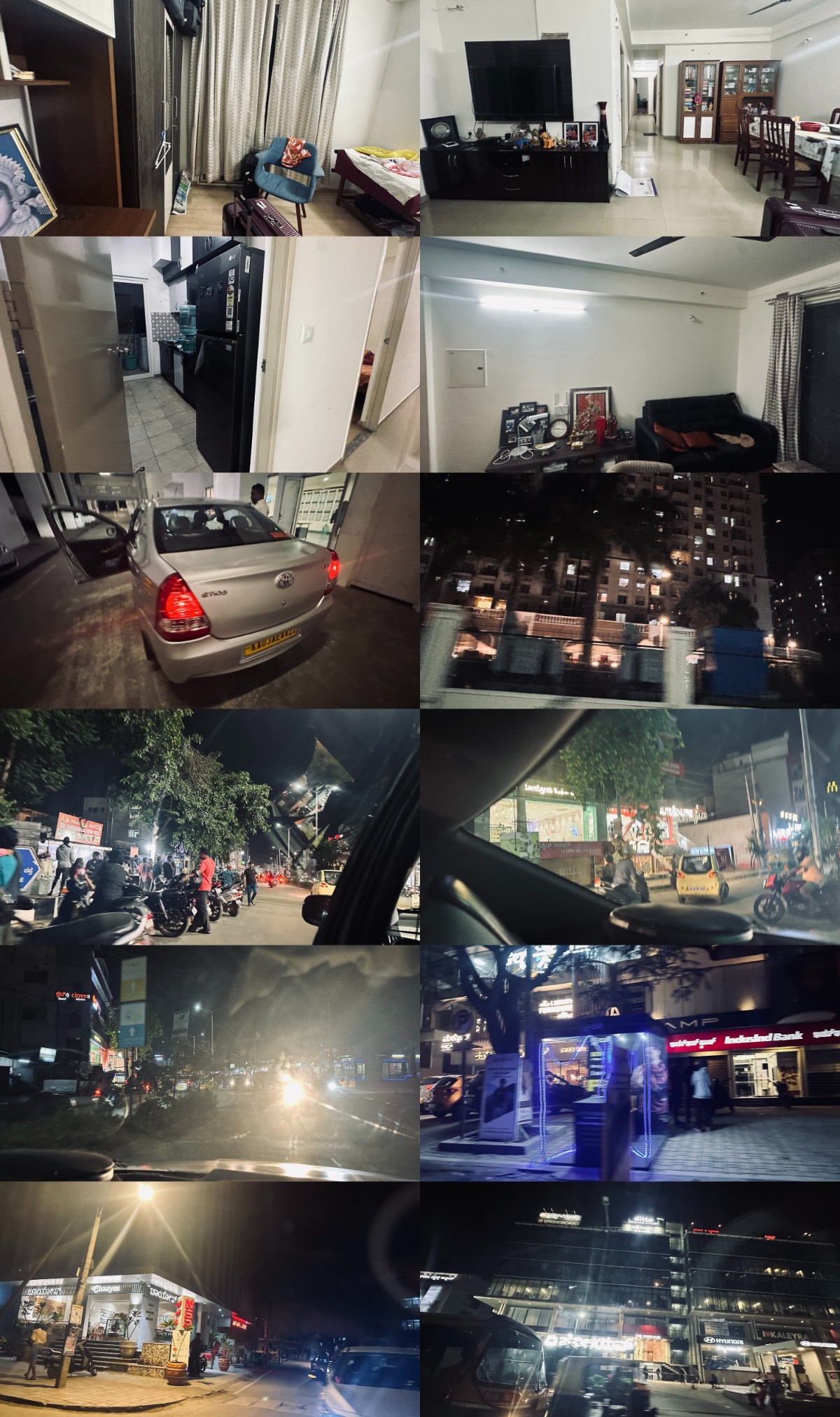
It would be comfortably 30 minutes before reaching the busy Bannerghatta Road stretch, and another 30 before we could come to the centre of the city near Cubbon Park. Traffic continued to slow down to a crawl, but it really hit its worst at the Hebbal flyover junction further north, with vehicles refusing to budge and drivers tooting their horns. It only added to our worries, and I was soon in grave danger of missing the flight.
(Not that I was especially looking forward to flying the godforsaken Thai Airways 777-200ER again, but missing it and rebooking everything would have been so much worse…)
At 11 there was a call from a Thai Airways check-in staff member, and he asked whether I would be able to make it by the bag-drop closing time of 11:30. I answered that I would, and it was only at 11:20, after a 2-hour ordeal, that I was finally able to get my bags down from the car, sprint to the entry queue, show my passport and boarding pass to the security staff — as is the norm for Indian airports — and dash to the TG counters.
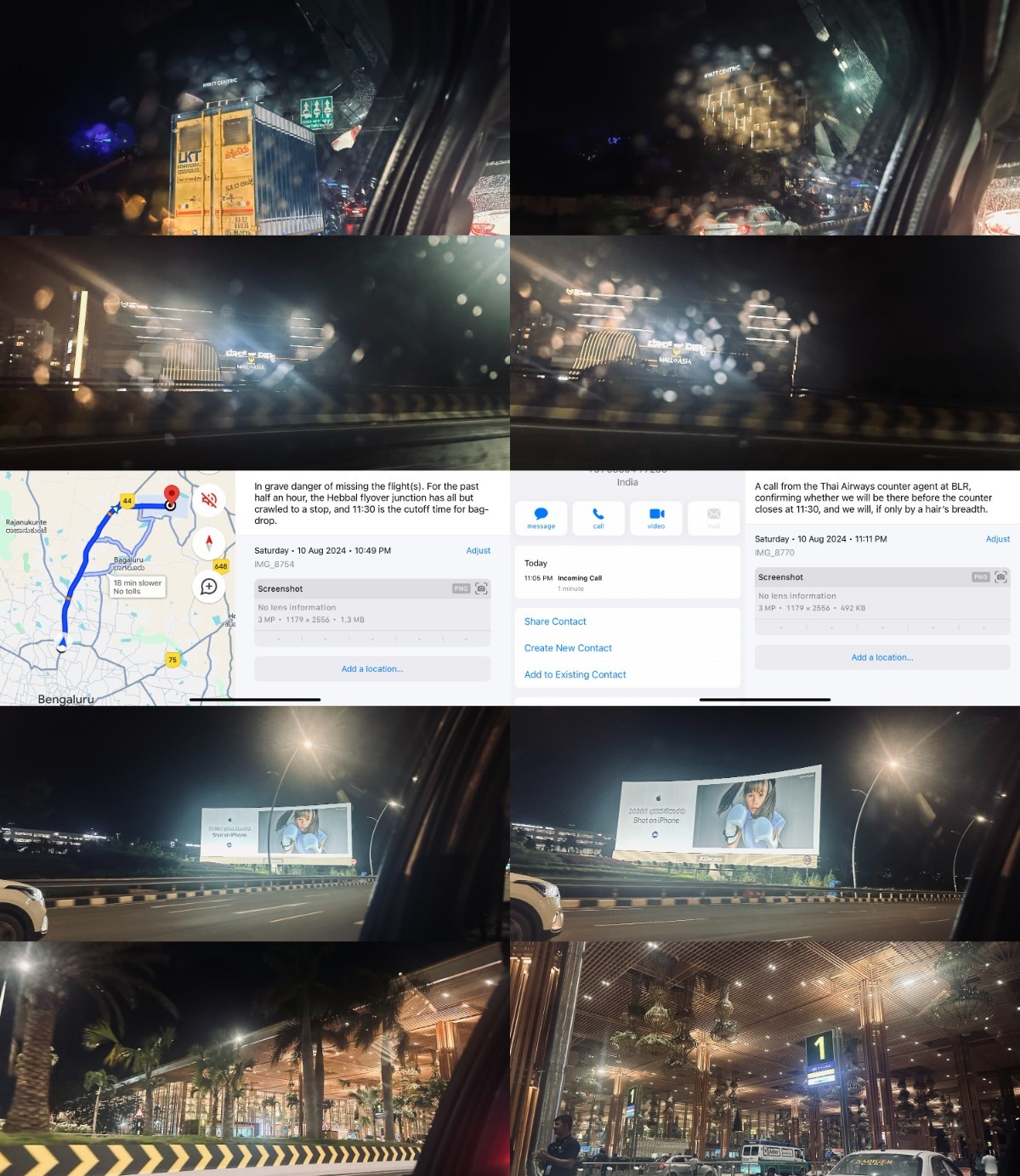
There was barely any time to look around, but once check-in was completed quickly — and it had to be, given that boarding would soon start! — I had a glance at the other international airlines’ check-in counters.
There was quite the variety, with JAL being the standout in terms of diversity. It remains the only Northeast Asian airline (other than Cathay Pacific) to serve South India, with rival ANA having terminated its short-lived service to my former home: the terrible government-run Chennai Airport an hour’s flight away. Other than this, there were Air France–KLM and Lufthansa (perhaps also Ethiopian), but oddly there was nothing from the Gulf — or at least I didn’t manage to spot them, since the likes of Qatar Airways have only a single daily departure in the dead of night.
Anyway, I had little time to worry about such niceties, and instead power-walked to the immigration counters and central security check, gritting my teeth as one bag was flagged by the Indian security forces’ inspectors for some little reason or the other. Obviously this wasn’t shaping up to be a proudly memorable flight!
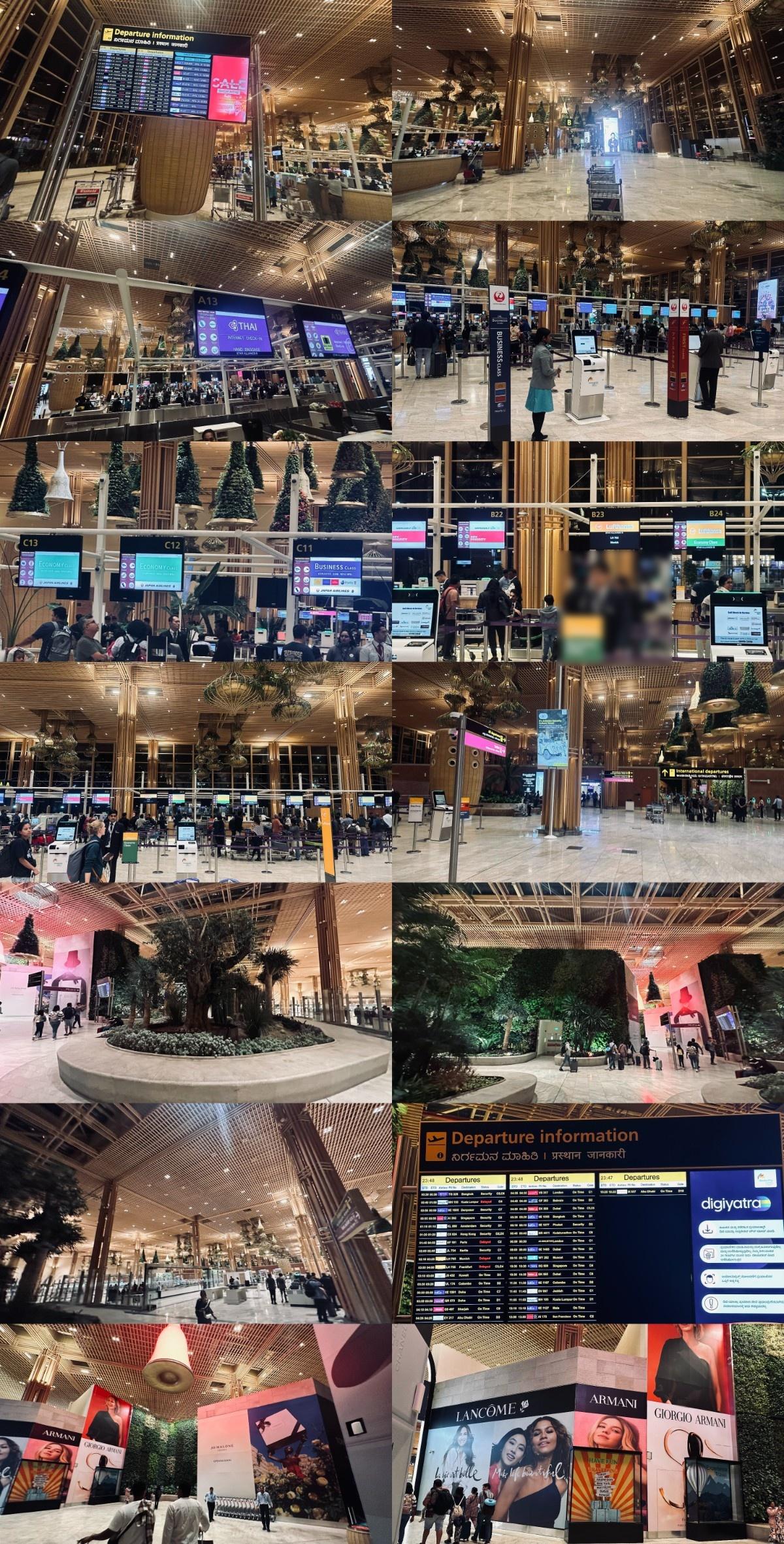
Bengaluru’s Terminal 2 forces you to pass through a Dufry duty-free maze on both departure and arrival, but I paid no heed to the brands of chocolate, cosmetics and liquor and practically stomped off to the departure atrium.
There being not much by way of proper restaurants, the best I could do was to head to the Relay bookstore and plonk down the expensive-for-Indian-standards sum of roughly ₹500 INR (≈US$6) for some bottled juices.
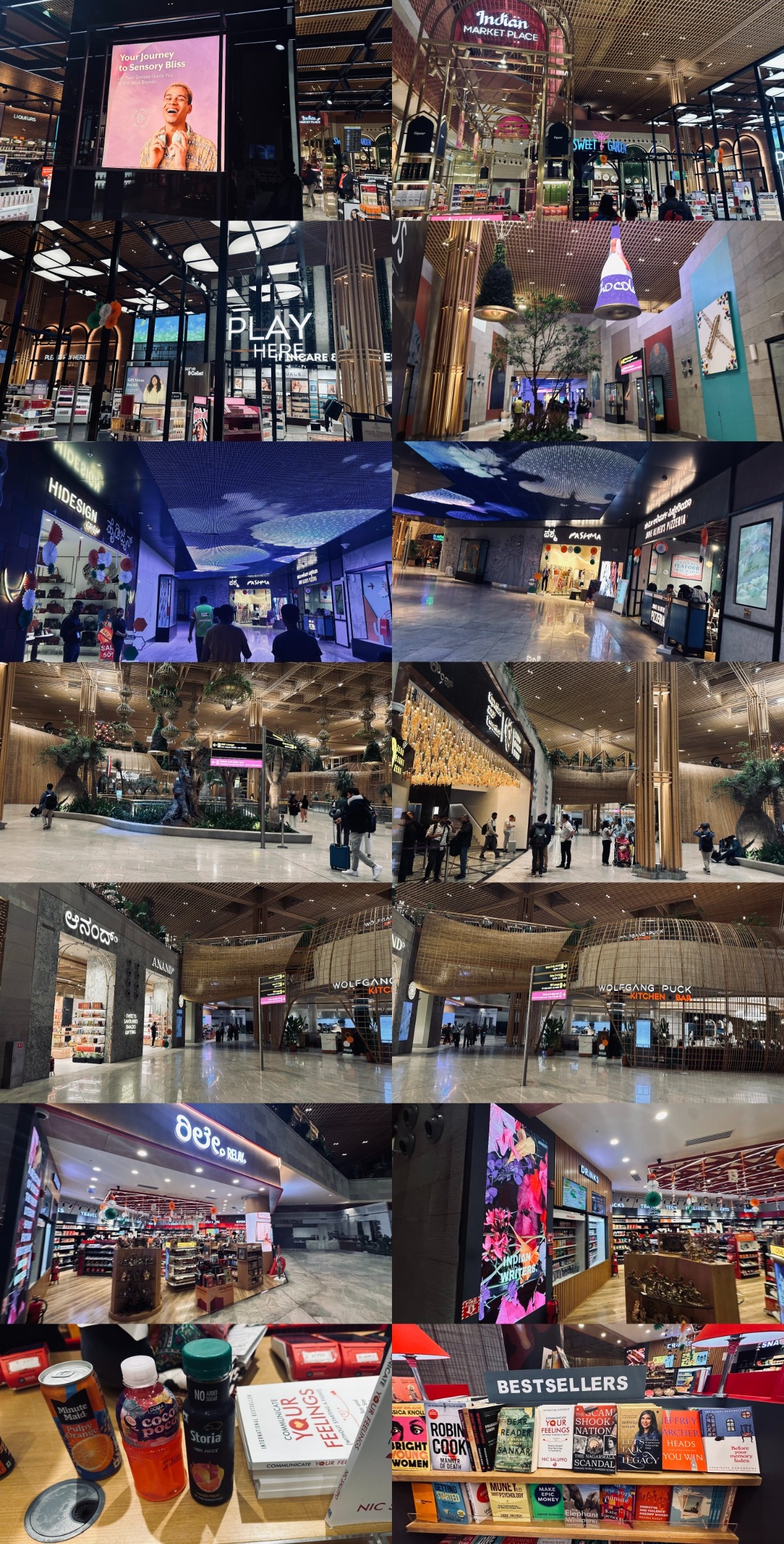
The talks between ‘captor’ and ‘captured’ begin
There was no doubt that HS-TJW (Phetchabun) was practically lying in wait to ensnare me tonight, and that she, and no one else, had the right to take me back from Bengaluru in the same way that she had deposited me here four nights earlier — cruelly crushing my hopes of getting any TG A350 on this trip. I’d need to wait until November for that to manifest itself…
If you’ve read Butter, the bestselling Japanese novel by Asako Yuzuki — which I’m reading now in 2025 — you can infer that the character of Manako Kajii herself is not unlike Phetchabun: stubborn, loathed by all, but obsessed with herself and with wielding power.
To add insult to injury, there was another 777-200ER standing next door: KLM’s PH-BQK, named Mount Kilimanjaro, which was technically older (built January 2005) but had a much nicer, refurbished cabin. And it seemed as though Phetchabun was only too happy to rub salt into that wound, as my imaginary conversation with her (as seen in the captions below) showed.
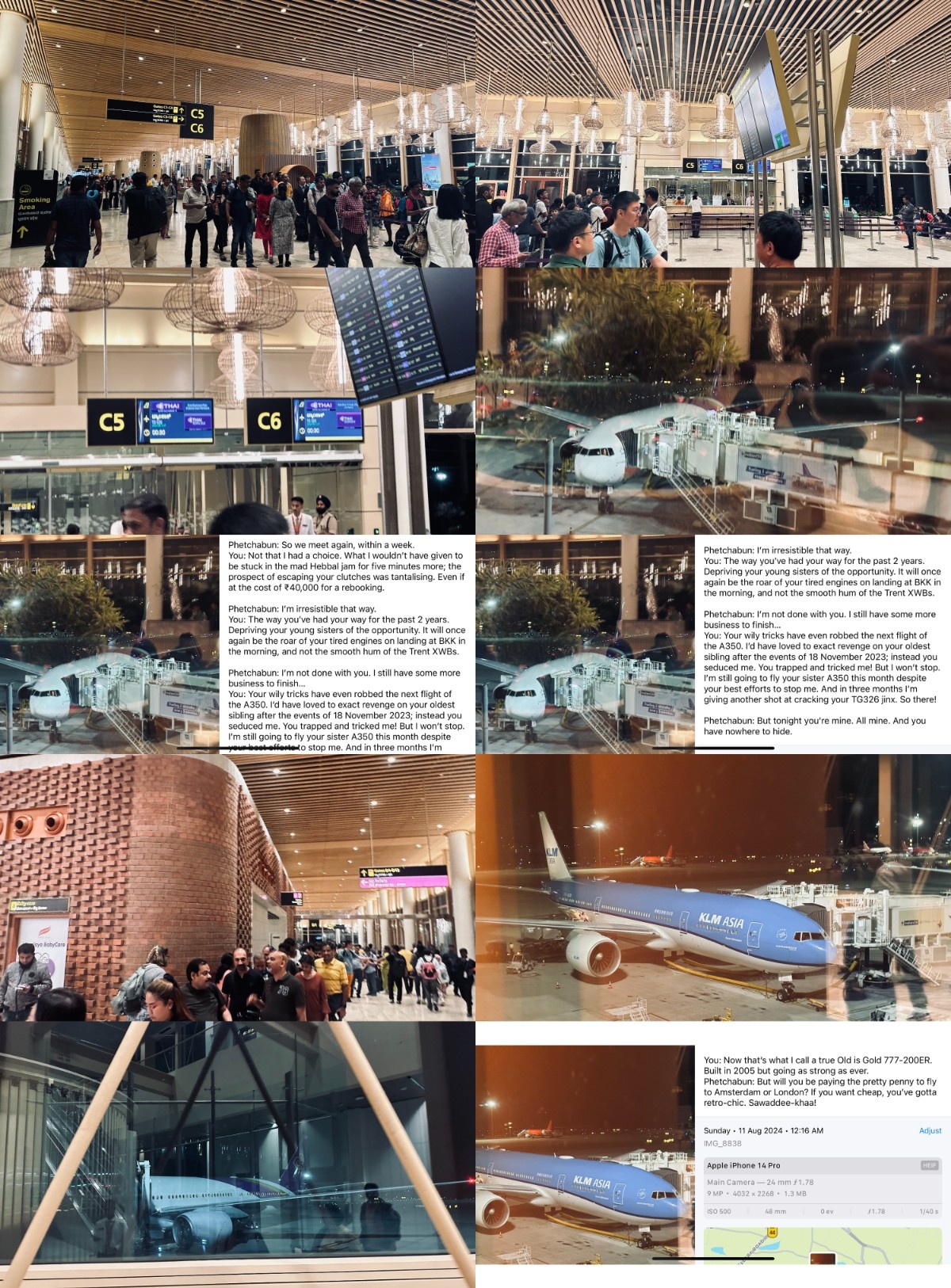
Moreover, the killjoy gate agents checked my boarding pass no fewer than five times, from the gate entry to the jetbridge to the aircraft door… and frankly I was in a sour mood. Meanwhile, several aircraft had landed all around: some exciting — the Oneworld troika of CX, JL and MH among them — and others the same old bland IndiGo A320/1s.
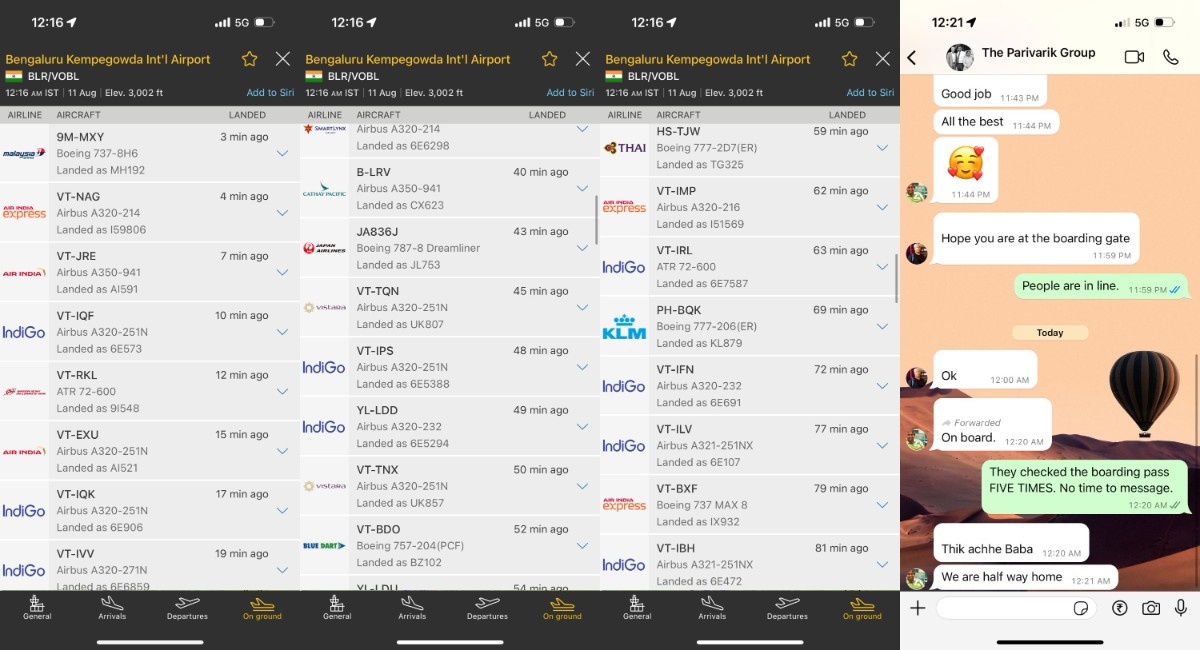
Again I was forced to confront the whole package: the recliner seats in Business, the old grainy 4:3 screens, the (admittedly vibrant) seat covers, the overhead panels… in short, a 3.5-hour game of playing the prisoner. At least it was overnight…
I bet Malaysia Airlines’ 737-800s, like 9M-MXY below — in spite of being refurbished to remove seatback IFE — are still better than this crap, since they at least have streaming IFE and charging ports, plus a beautifully designed magazine (which, well, TG doesn’t have) to boot. That’s to say nothing of the very comfortable Air India A320neos inherited after the merger with Vistara in November 2024, which offer much better catering, streaming IFE and a magazine.
That said, the 777-200ER is now more or less a rarity on the Bengaluru route, as TG325/326 is mostly served by either the A350 or, failing which, the A330-300. For now, though, as the rainforest-y safety video played out on that grainy screen, I had to grit my teeth and grin and bear it.
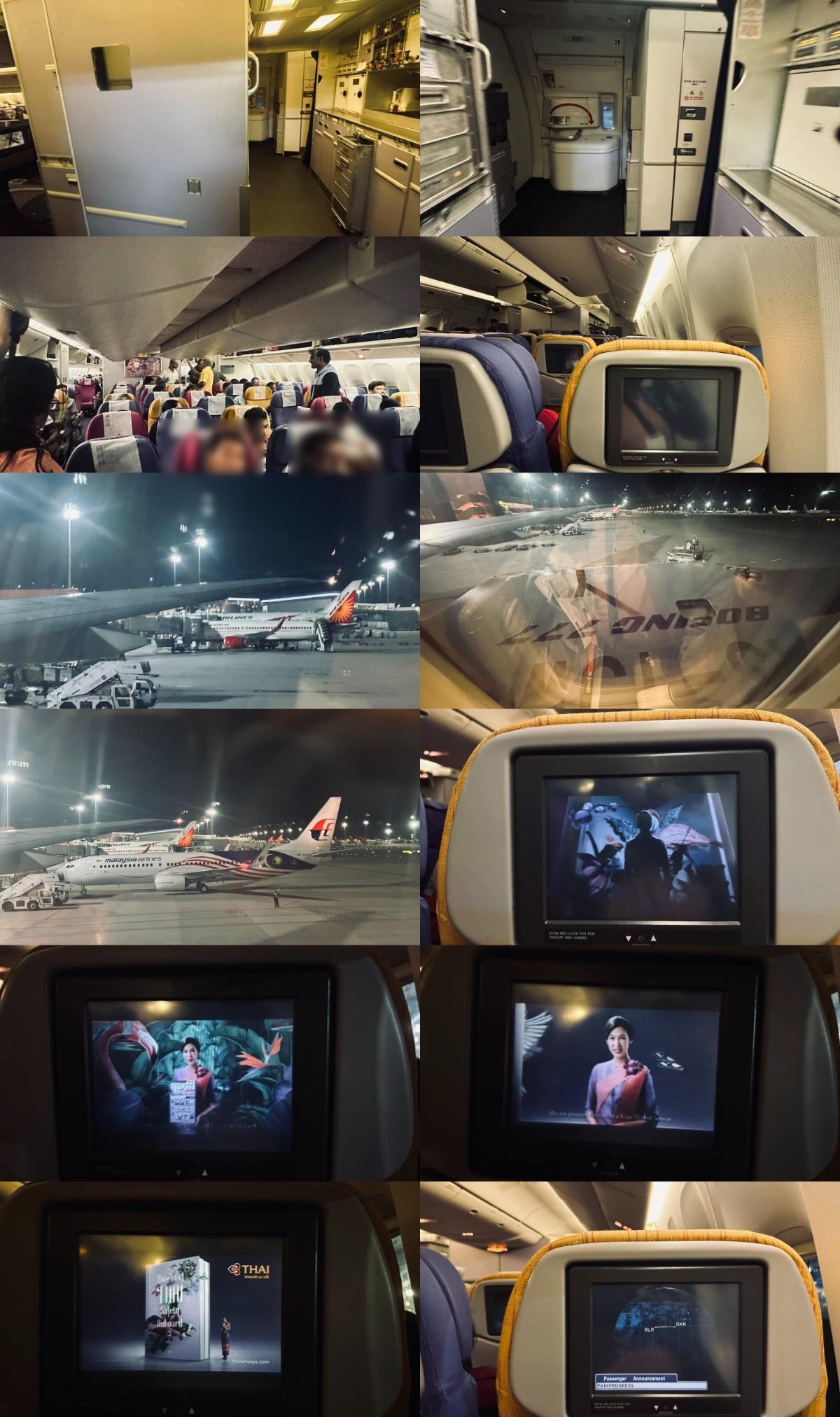
I have changed so much since that life-changing 40-minute flight in June 2024 that I will willingly fly a 737 — yes, even a Batik Malaysia 737 without any IFE (provided the price is low; I did that in February 2025) — over this junk. The days of going out of my way to steer clear of 737s are well and truly over.
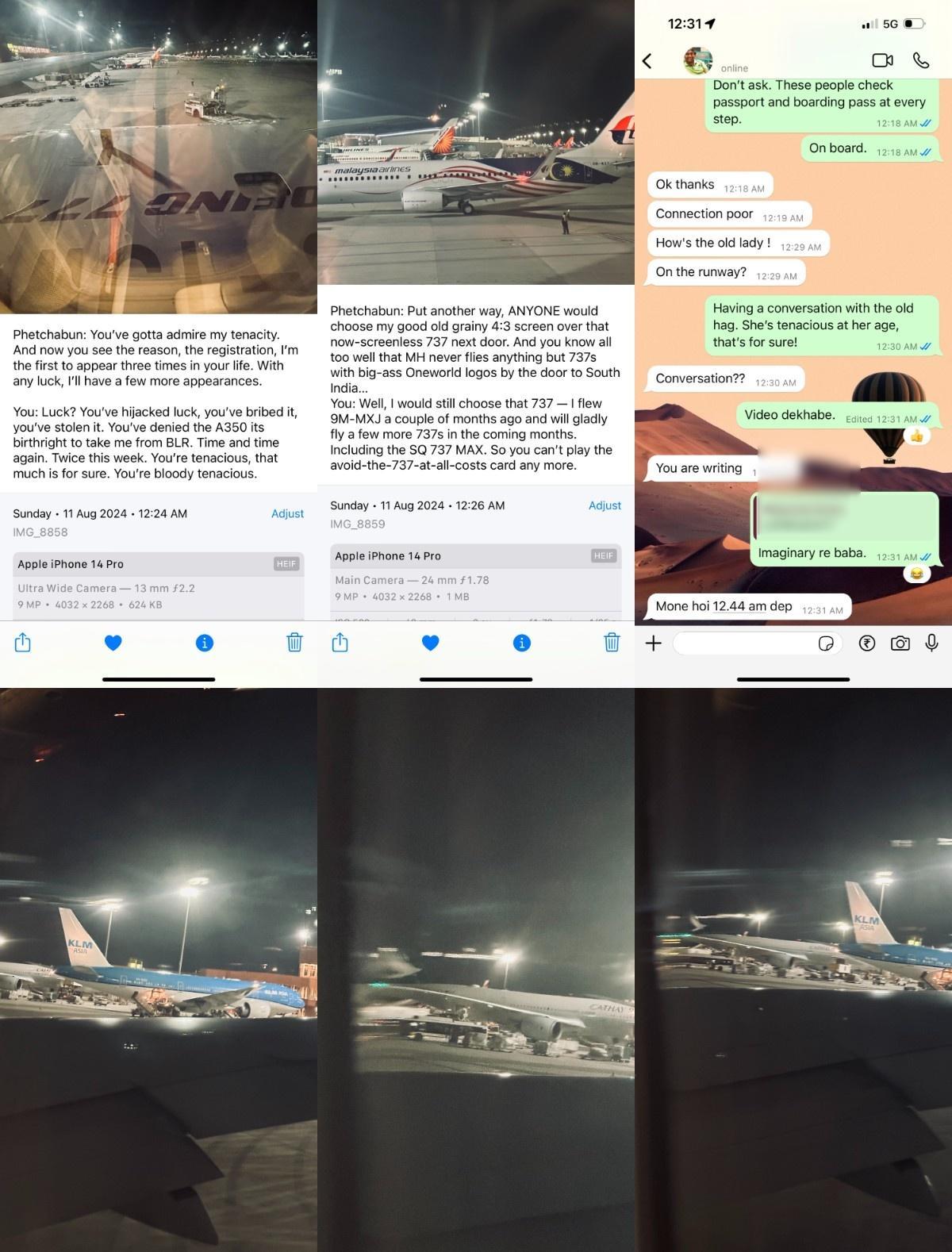
The safety video over, Phetchabun taxied out past the KLM 777-200ER and three A350s: one from Cathay Pacific and a pair from Air India. Incidentally, the first time I flew on CX was here, from BLR, in December 2023, and two months later I got the AI A350 from here as well.
Yes, those were the days in 2024 where AI based two A350s in BLR for domestic flights, but in November 2024 all six AI A350s were relocated to Delhi for their London (Heathrow) and New York (JFK and Newark) operations — though one domestic route, between Delhi and Hyderabad (AI544 and AI840), retained A350 service.*
Meanwhile Phetchabun was hell-bent on preventing me from experiencing the joys of a TG A350 when departing at night… but in the end she failed, and HS-THN, which I’d already flown later in August, stepped up to carry me on both legs from BLR to SIN in November. Take that, old hag!
*Now the AI A350 will (briefly?) return to Bengaluru in May 2025 — for the first time since November 2024 — for a 3x weekly DEL–BLR service, coupled with the existing daily DEL–HYD service which now becomes 4x weekly.
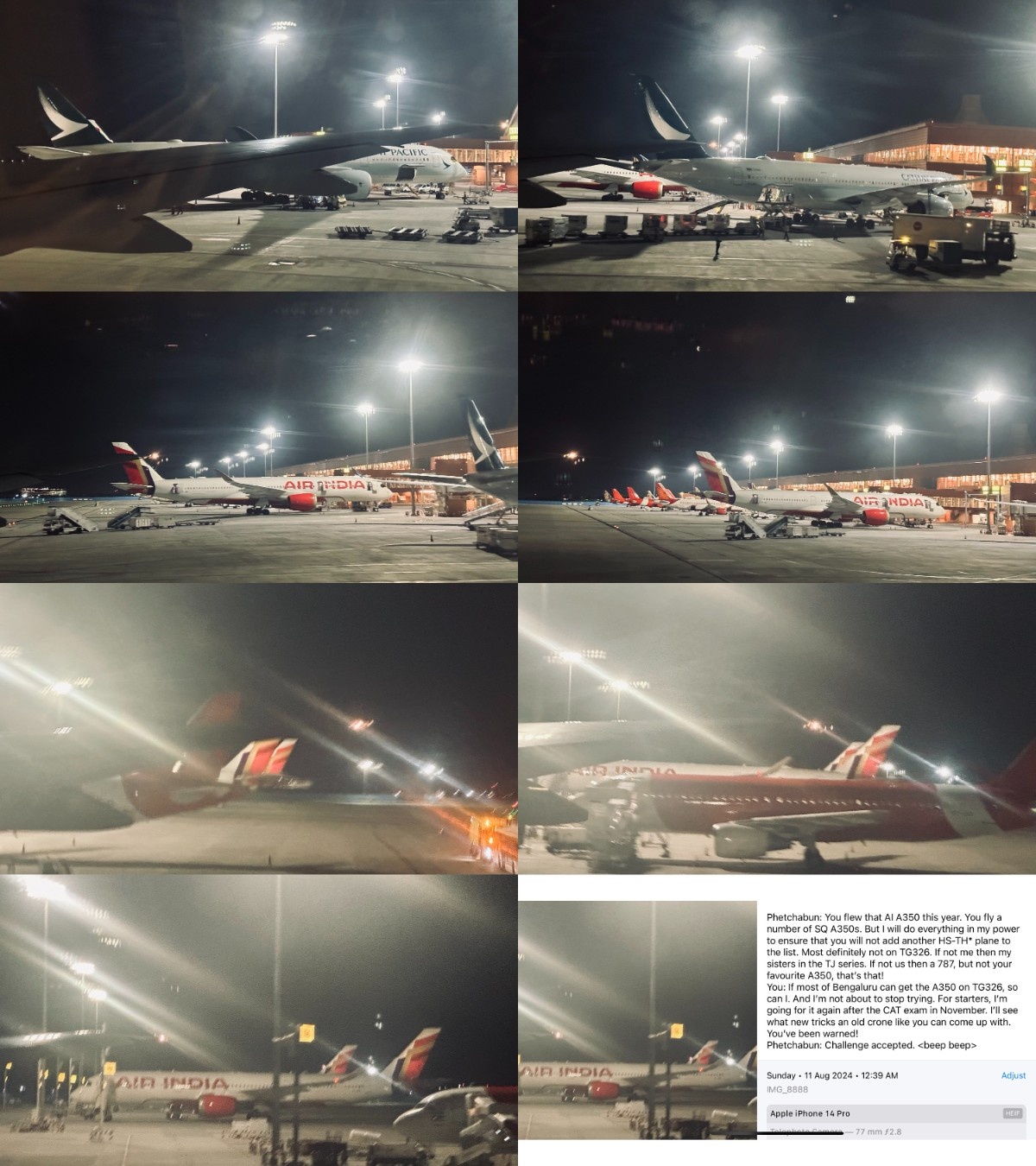
For (hopefully) the final time, the aging Rolls-Royces whirred above the northern Bengaluru night lights for an especially noisy departure, while I had the pleasure (ha, ha) of following the path and altitude/speed/time details on the old blue screen.
My so-called ‘conversation’ continued unabated throughout the takeoff, and I matched, word for word, Phetchabun in my doggedness.
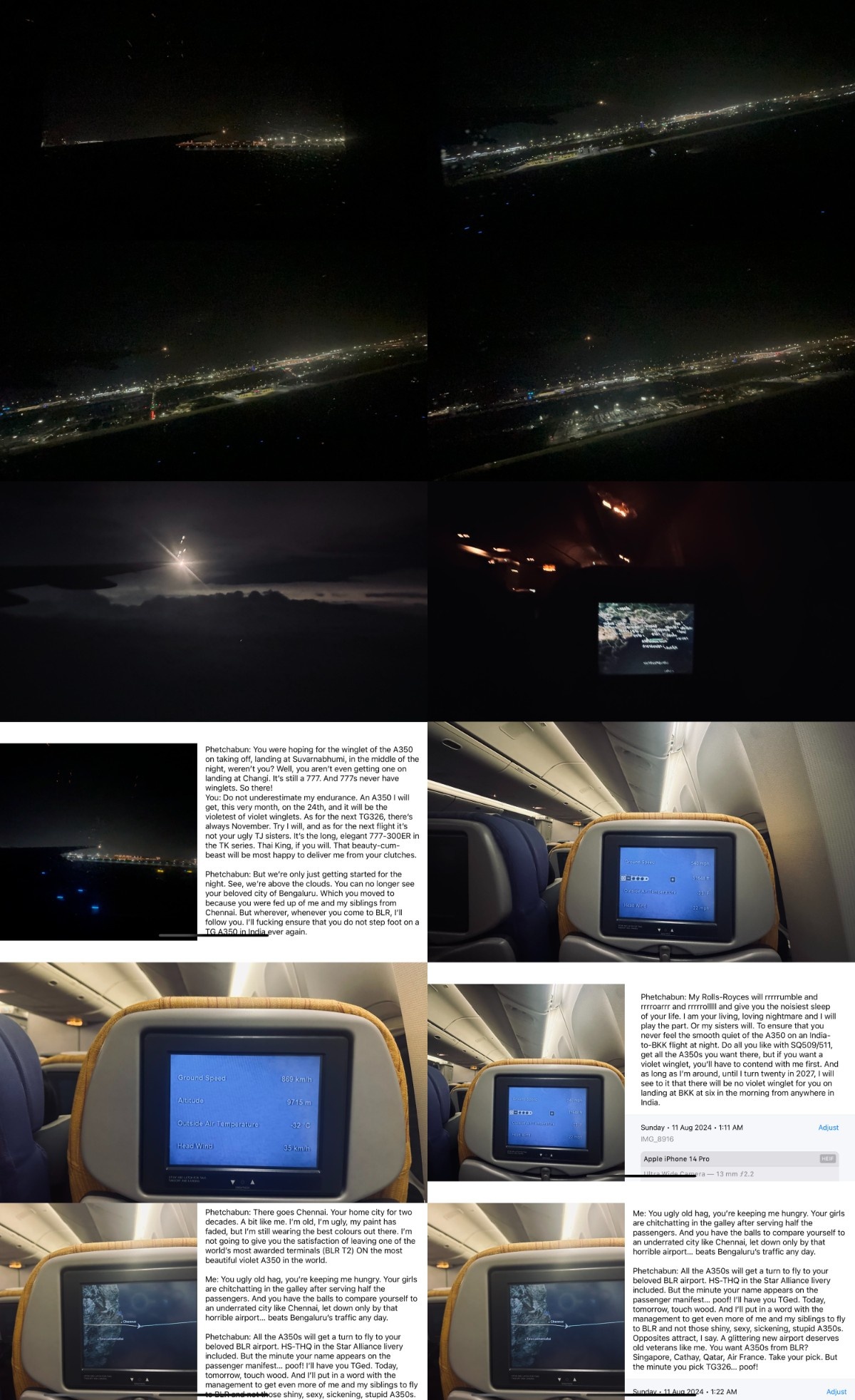
The food is no better, more’s the pity
There’s one thing that I don’t expect anything better from Thai Airways, even if the aircraft were an A350: poor catering on Indian routes. What TG calls an ‘Indian non-veg meal’ (in air quotes) is nothing but a tray of pure vegetarian chana (chickpeas) and potato curry with a piece of tandoori chicken tikka wrapped in aluminium foil… No, this is not by any means passable, and I’ve seen much better catering on TG’s Southeast Asian flights. (The opposite is true for SQ, where the Indian catering ranges from decent to excellent, while Southeast Asian regional flights seldom get anything nice!)
As I noted: ’Never was a fan of chhole masala, and the veg curry screams of capsicum.’ In other words, the main course was an unmitigated disaster. The only saving grace, then, of the meal was the caramel gateau cake served for dessert, which was genuinely delicious — plus the cut fruits if I’m being generous. But then I weighed the alternatives, which included AirAsia’s cramped A320s — though with relatively good, piping-hot Indian meals available for pre-order — and SQ’s A350 with better catering but for a vastly higher price.
In an ideal world, TG would have sent its A350 and I would have written off the meal as a one-off disappointment. Now, however, it only further clouded the already dismal experience. Yes, I deliberately was being masochistic! (And yes, there was no Panasonic Voyager 3D or Thales 3DMaps…)
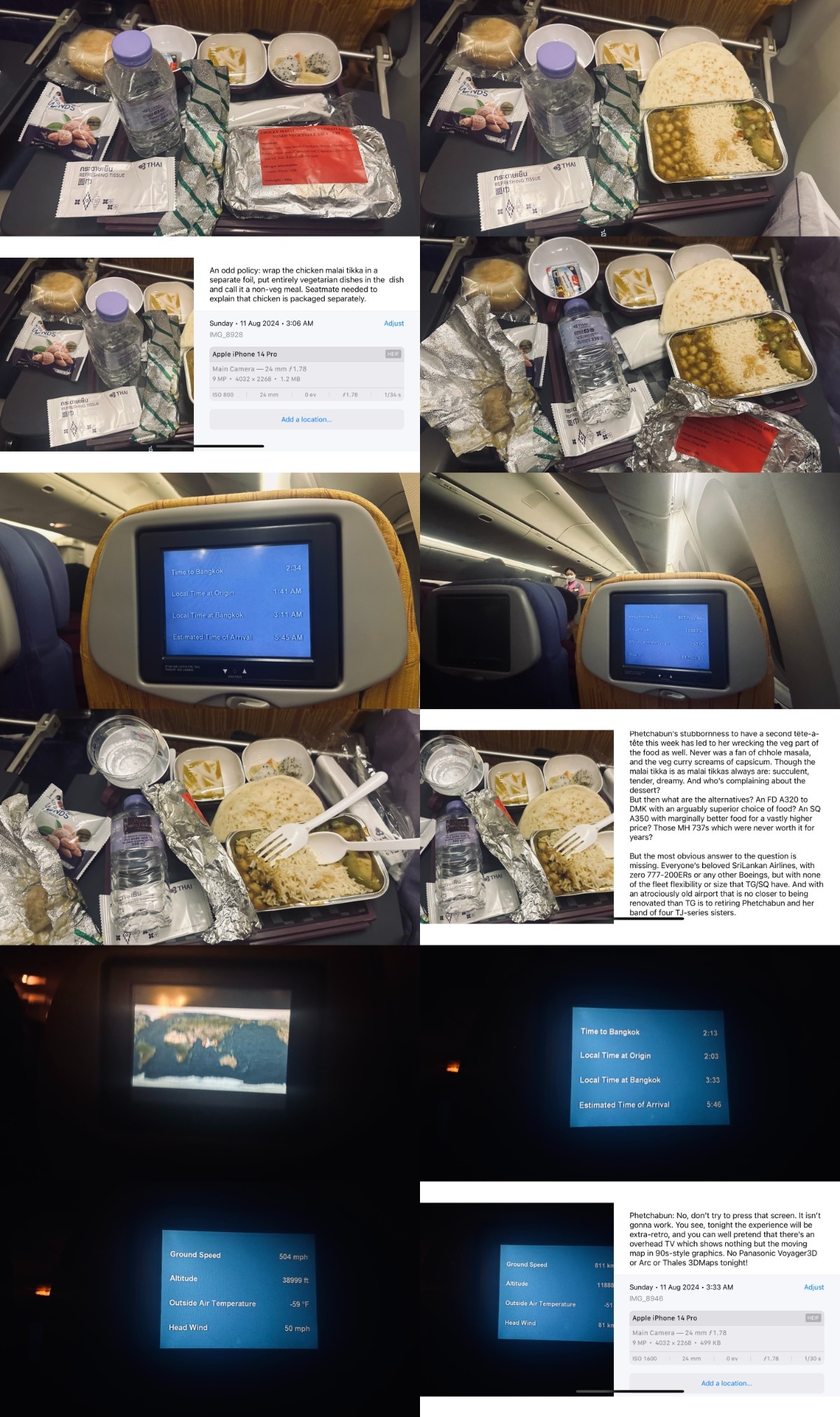
All this while, it had been impossible to switch off the IFE screen, much as I’d wanted to — so I had no choice but to summon the flight stewards, with two (male and female) turning up. One cleared the trash, and the other showed me how to turn off the screen, there being no under-screen or in-remote button for the purpose. This was as ziddi (stubborn) a system as the aircraft itself!
Somehow I managed to settle into a fitful slumber, and the fact that the engines’ noisy rumble penetrated through the little rest I could get was of no help. In any case, some three-and-a-half hours after departure, Phetchabun finally made a descent over the still-sleepy Bangkok skyline with its roads aglow.
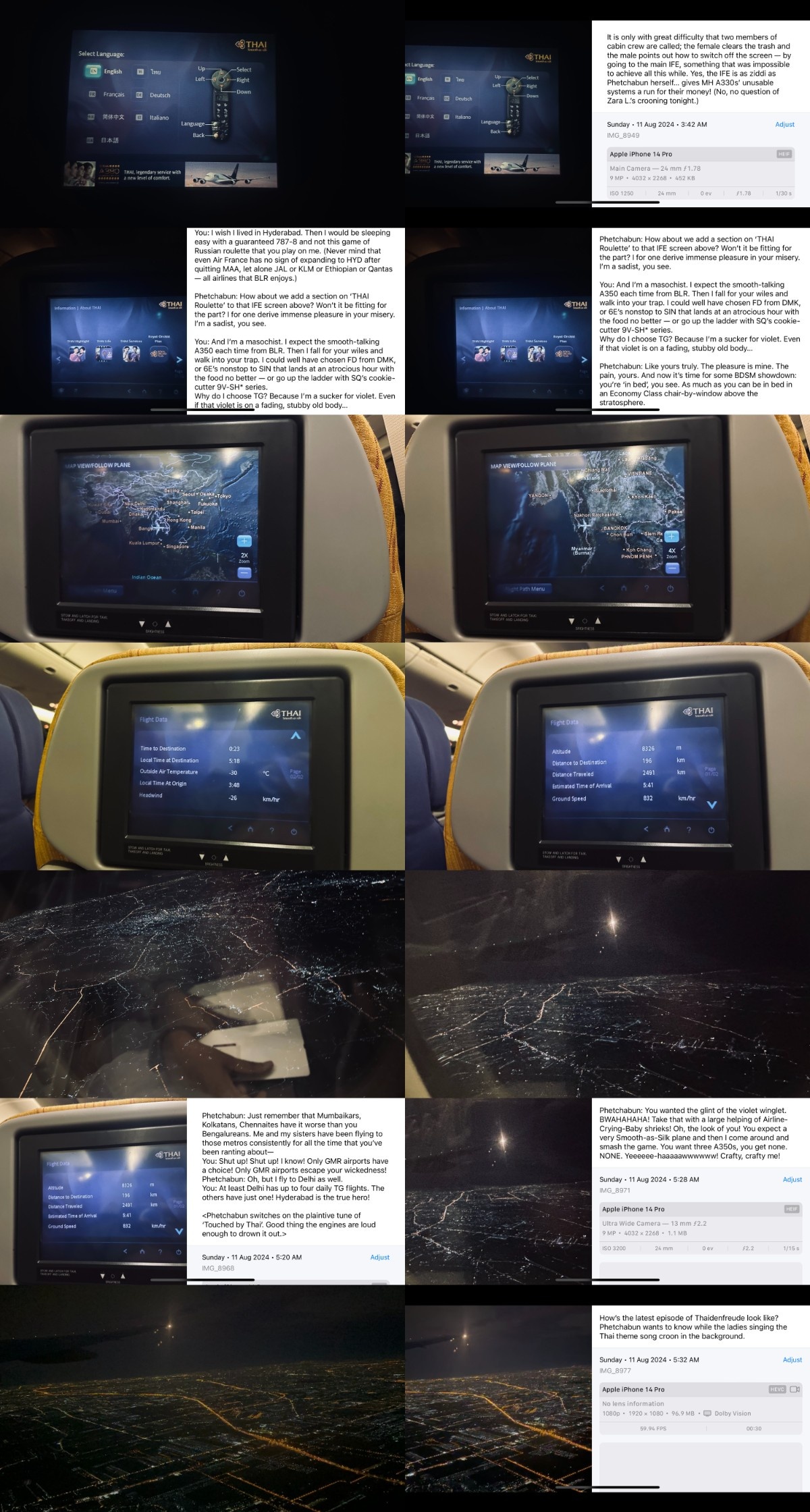
And then, amid the dazzling glow-in-the-dark roads, the TG graveyard — you can faintly see all the A380s and non-ER 777s parked below — came into view. At long last, the ordeal was over, and Phetchabun landed on the Suvarnabhumi runway. She would soon have to release her ‘prisoners’ into the confines of Suvarnabhumi Airport, which was no less jail-like in appearance… or would there be a more pleasant surprise in store? (Oh yes, there would be: the pretty SAT-1 satellite terminal!)
During the taxi to the gate, a Turkish A330-300 (TC-JNT) was plainly visible, having just landed as TK58. In my caption I remarked that TK remained the worldwide championer (yes, that’s a word) of A330s, while Star Alliance partner TG could only bring back three of them (HS-TEN/TEO/TEP) from retirement while keeping these rattling 777-200ERs flying for longer.*
*But, only a few months later, two ex-Virgin Atlantic A330-300s (G-VGBR and G-VNYC) were inducted as HS-TEV and TEW, and some A330-200s — retired by American Airlines during the pandemic — are expected to join as well. Oh, how the tables have turned on Thai Airways’ small A330 fleet!
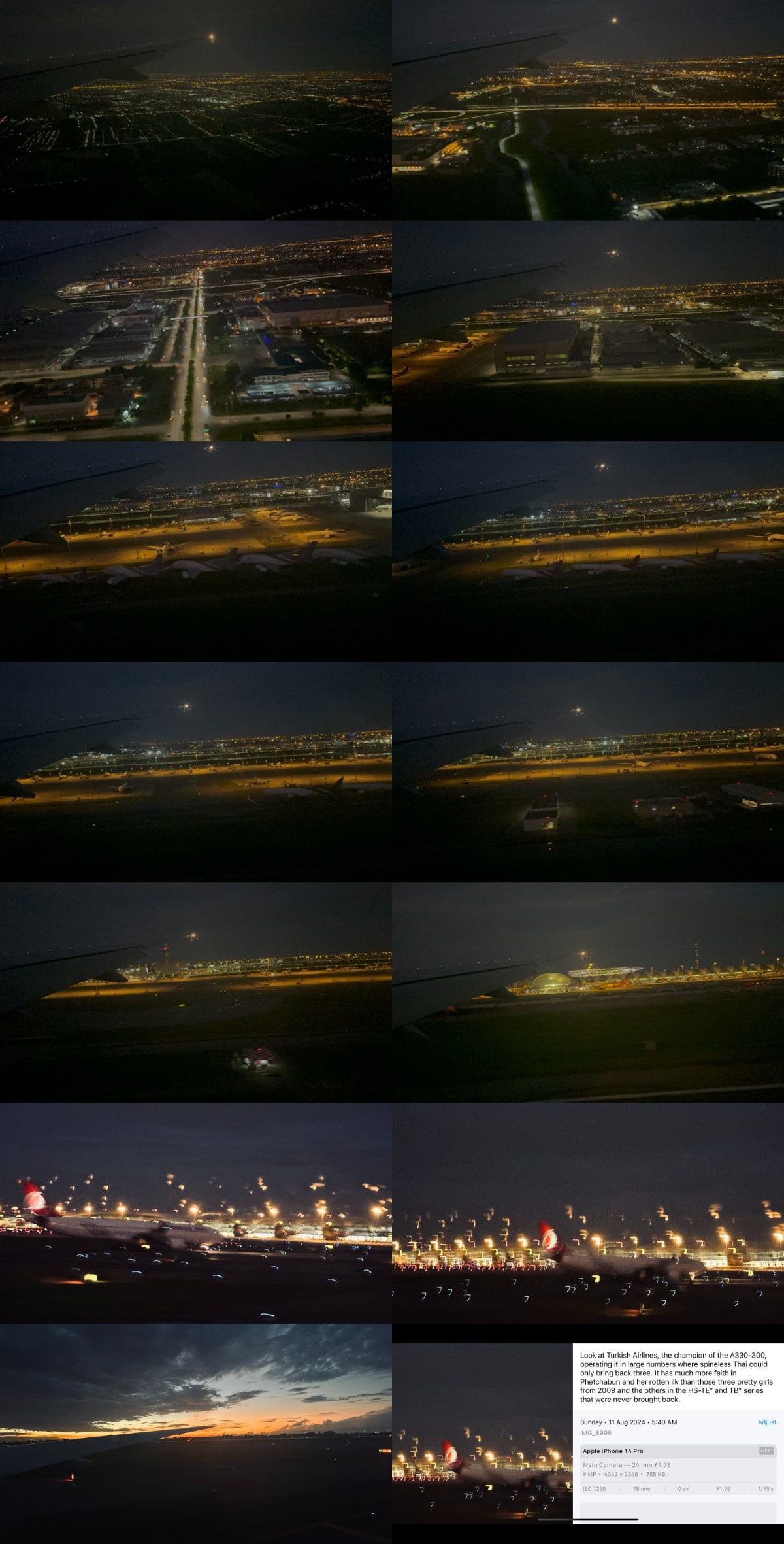
Among the recent arrivals were JL33 from Haneda, AY141 from Helsinki and — curiously — SU654 from Khabarovsk in the far east of Siberia.

As you see above, today was definitely a field day for TG 777-200ERs flying from India, as they had captured TG332 from Delhi, TG338 from Chennai, TG318 from Mumbai and this flight, TG326 from Bengaluru. Only Hyderabad (TG330) escaped with its guaranteed 787-8 — something that TG was once very consistent about (the 787-8 to HYD), but even that was swapped to the 777-200ER in October 2024.
Phetchabun issued me a final taunt as I escaped from her clutches, hopefully never to step on board such an all-around horrible old plane again!
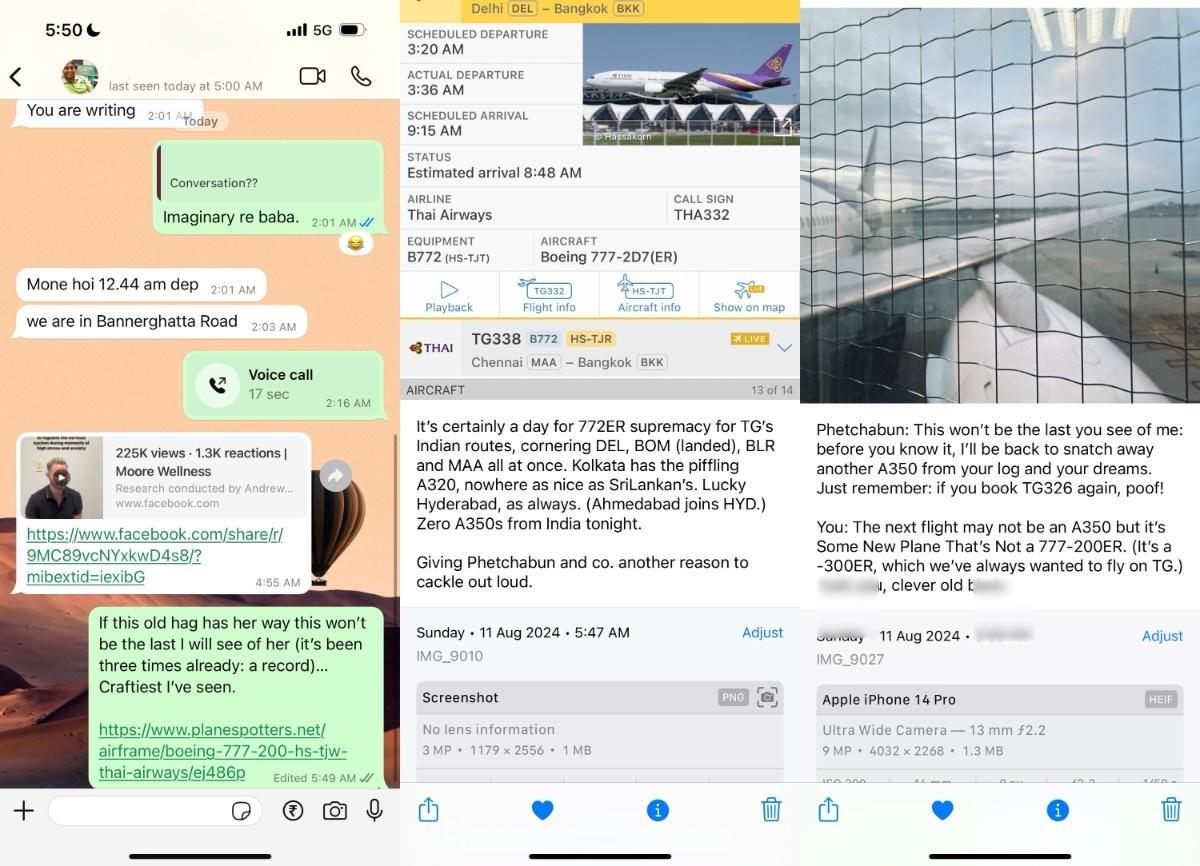
I rushed forward with bag and baggage, and hurried to step out without so much as a word to the sawaddee-khaa-ing stewardesses. Emancipation couldn’t have come sooner enough. But even better, adding to the sweetness of relief, was the fact that…
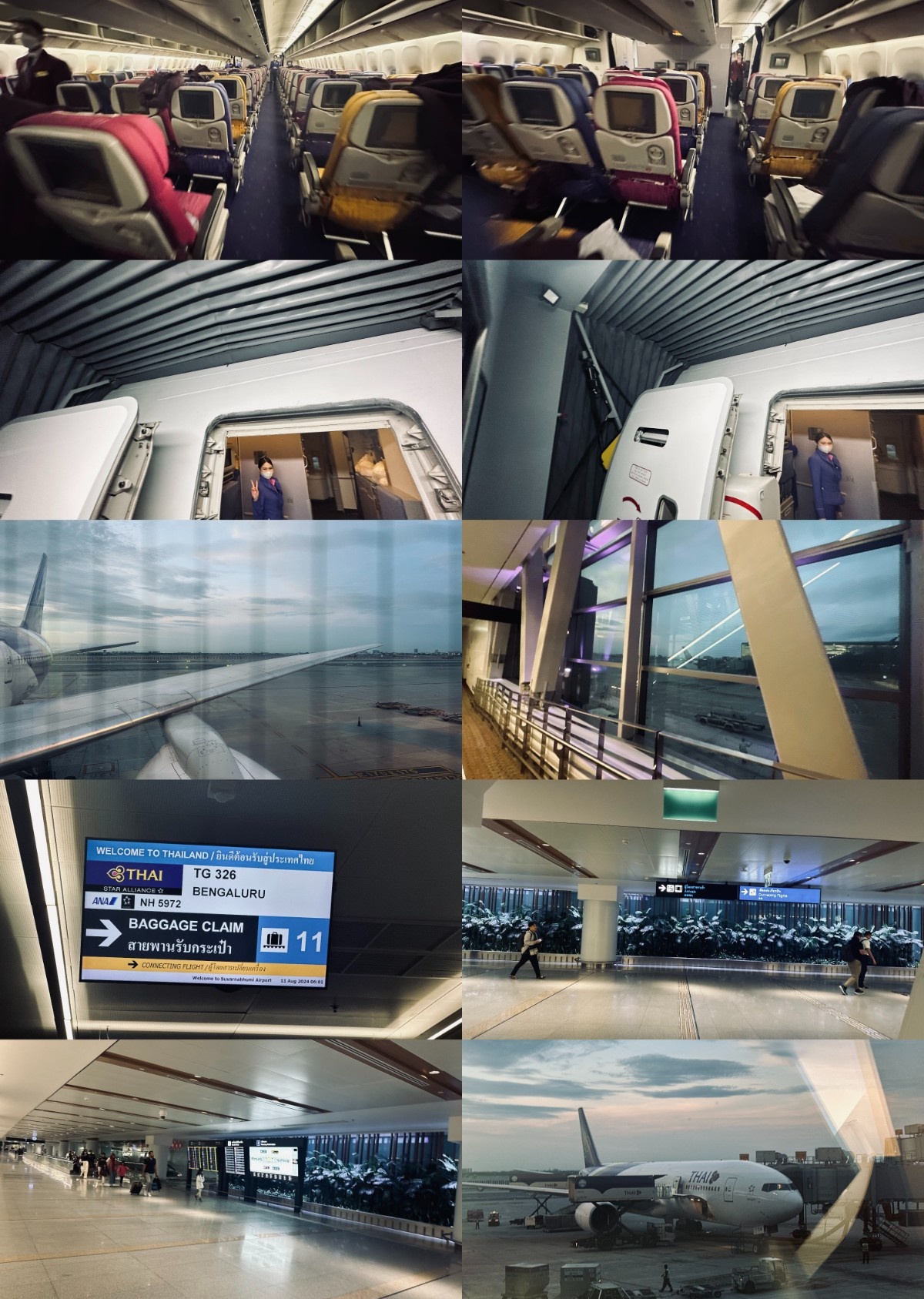
…it’s the new satellite terminal, YAY! (But not for long…)
Fortunately, I’d arrived at the fresh new SAT-1 satellite terminal, which was also the case when departing BKK on the same aircraft four days before.
Of course, there was a certain irony to this that wasn’t lost on me: the high similarity of this name to Sat.1, one of Germany’s biggest TV channels. Their breakfast show is called Frühstücksfernsehen (oh, the Germans with their long-winded words!), and I pounced on the opportunity to incorporate this into my caption below — combining it with the Scandinavians arriving from CPH and OSL on 11-hour TG flights.
I needed to get to the god-awful main terminal, where my connecting flight to Singapore would depart from, and for this I went a level down to the automated people mover (APM): the same thing that’s called a Skytrain at Changi. (Later in November, I had much better luck, as both the arriving and the connecting flight were served by the same plane at the same gate — none of this main-terminal nonsense!)
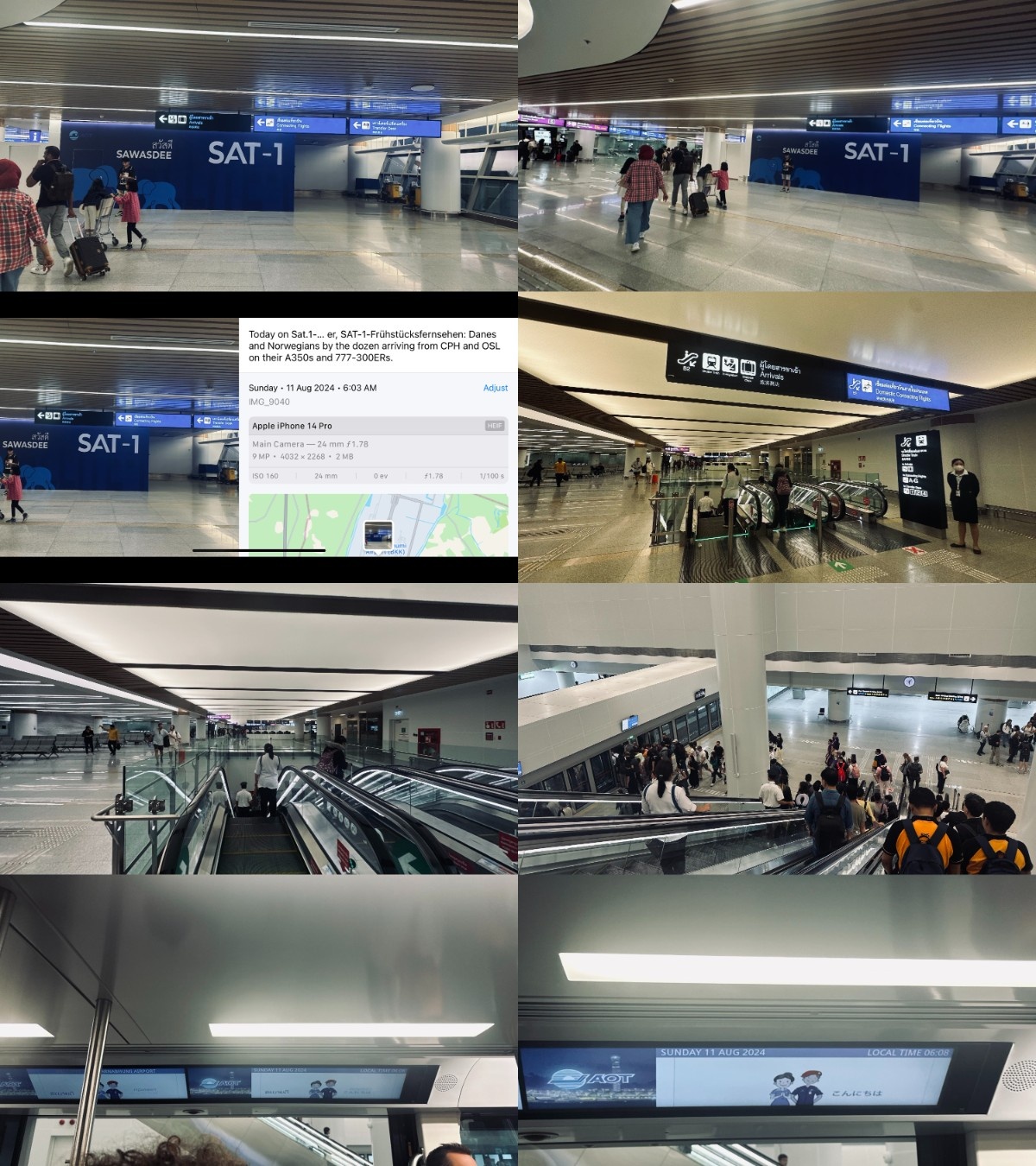
A number of TG9xx flights to/from Europe were airborne, with the Scandinavian ones — TG951 from Copenhagen, TG955 from Oslo and TG961 from Stockholm — all having landed very recently. And, indeeed, using the Look Up feature on that SAT-1 text (all-uppercase with a hyphen) did return results for the German channel and its breakfast show!
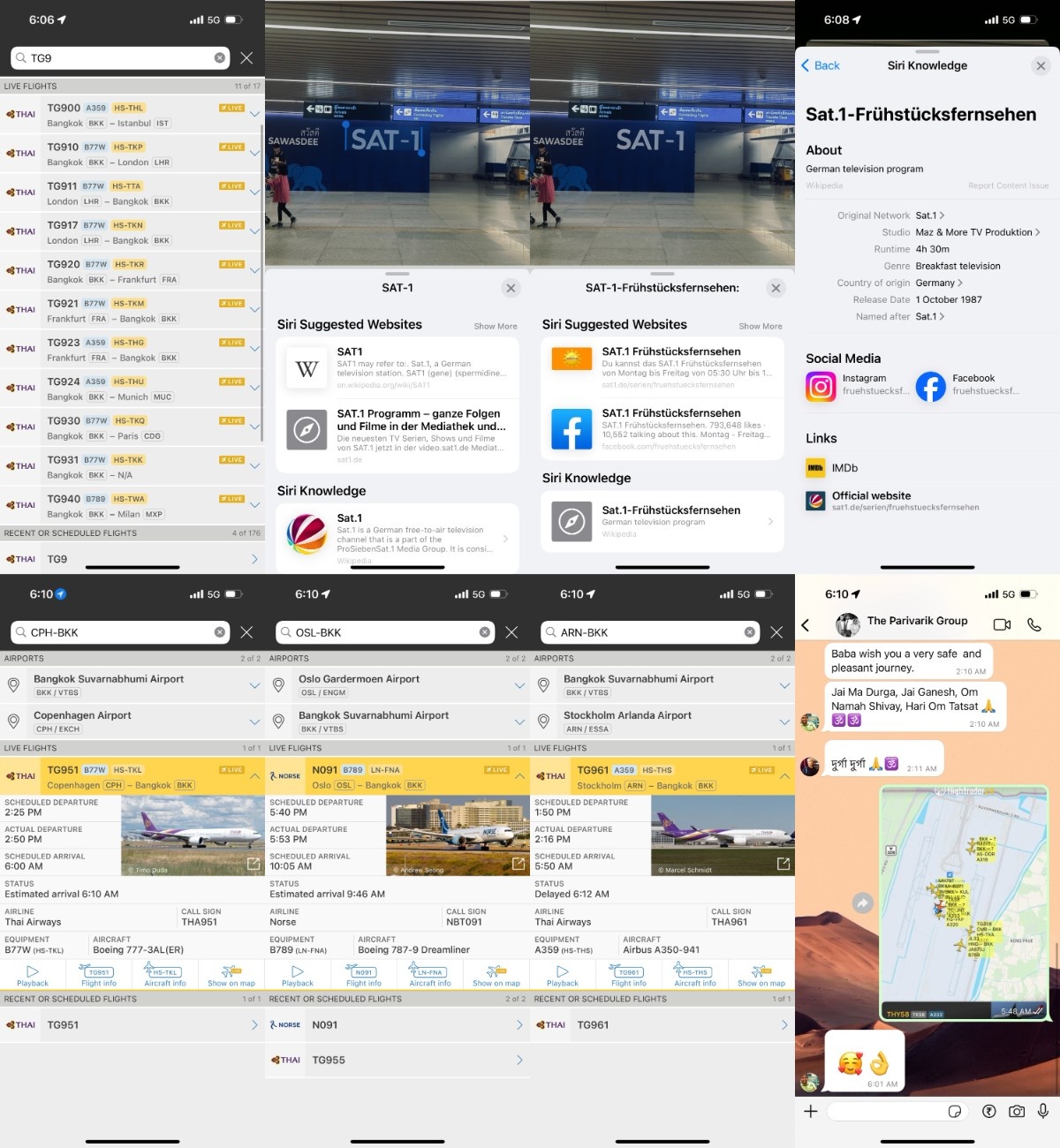
Once in the dreary grey main terminal that was as bad as (if not worse than) Phetchabun herself, I dragged myself as fast as I could to the transfer counters, steering clear of the hordes of passengers arriving from not only Scandinavia but, indeed, all parts of Asia.
And then the security screening awaited, It never is a joy at BKK, but at least at the transfer security check I didn’t have to contend with the thousands of people departing BKK and shoehorned into the tiny security area above the departure check-in counters.
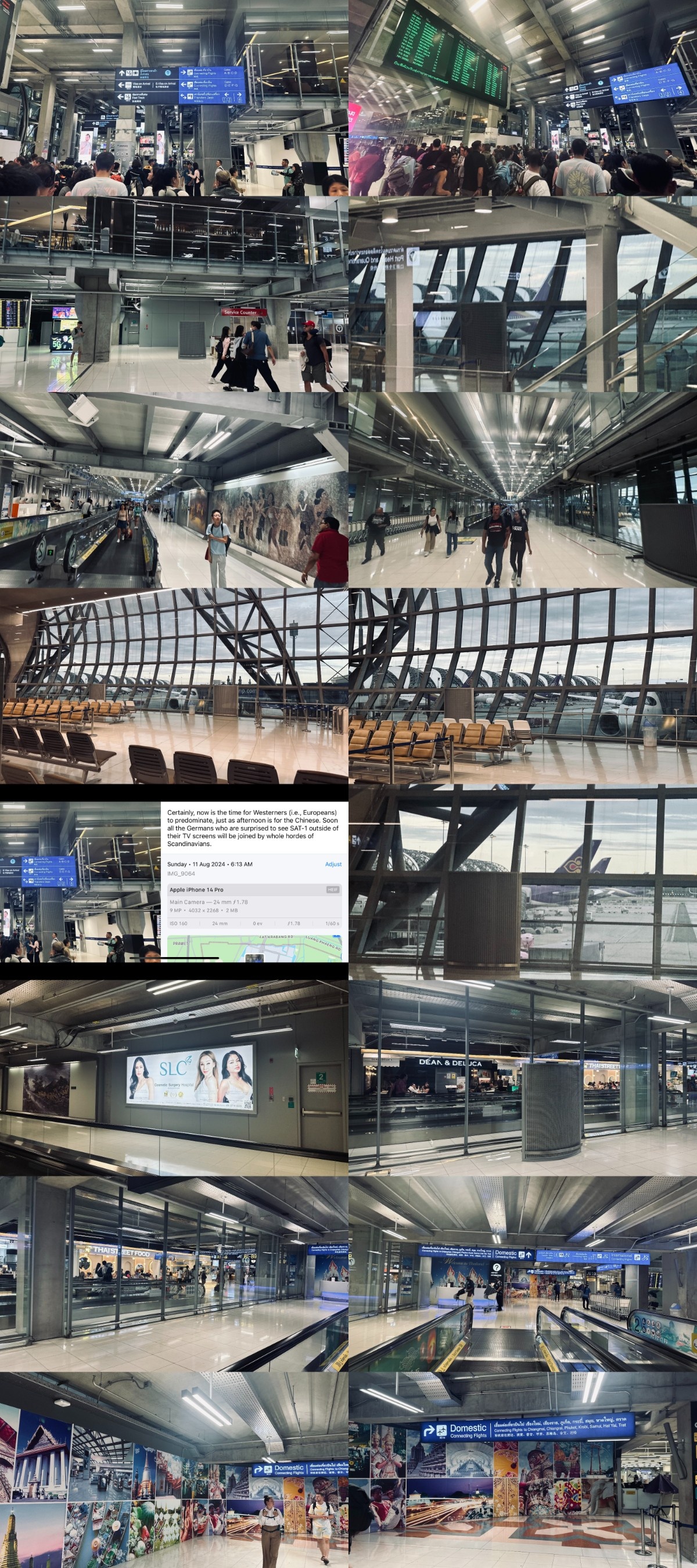
One interesting thing that I observed in the long list of airline names, codes and logos was the name ‘Tata SIA Airlines’! This was the official registered name of Vistara, the Indian full-service airline that was launched by the Tata Group in 2015 and discontinued on 11 November 2024 after being merged into Air India. It was a nice toast to this short-lived but excellent airline while it still existed!
Then, bypassing one of several Coral Lounges and a Thai Airways Royal Orchid Lounge, I went straight to the departure gate for my flight to find out what registration my 777-300ER (yes, -300ER, not -200ER) would be. Fortunately I wouldn’t have to spend too much time wandering the top floor of this most ugly but still essential airport. (Suvarnabhumi does, however, look beautiful from the outside — but only the outside…)
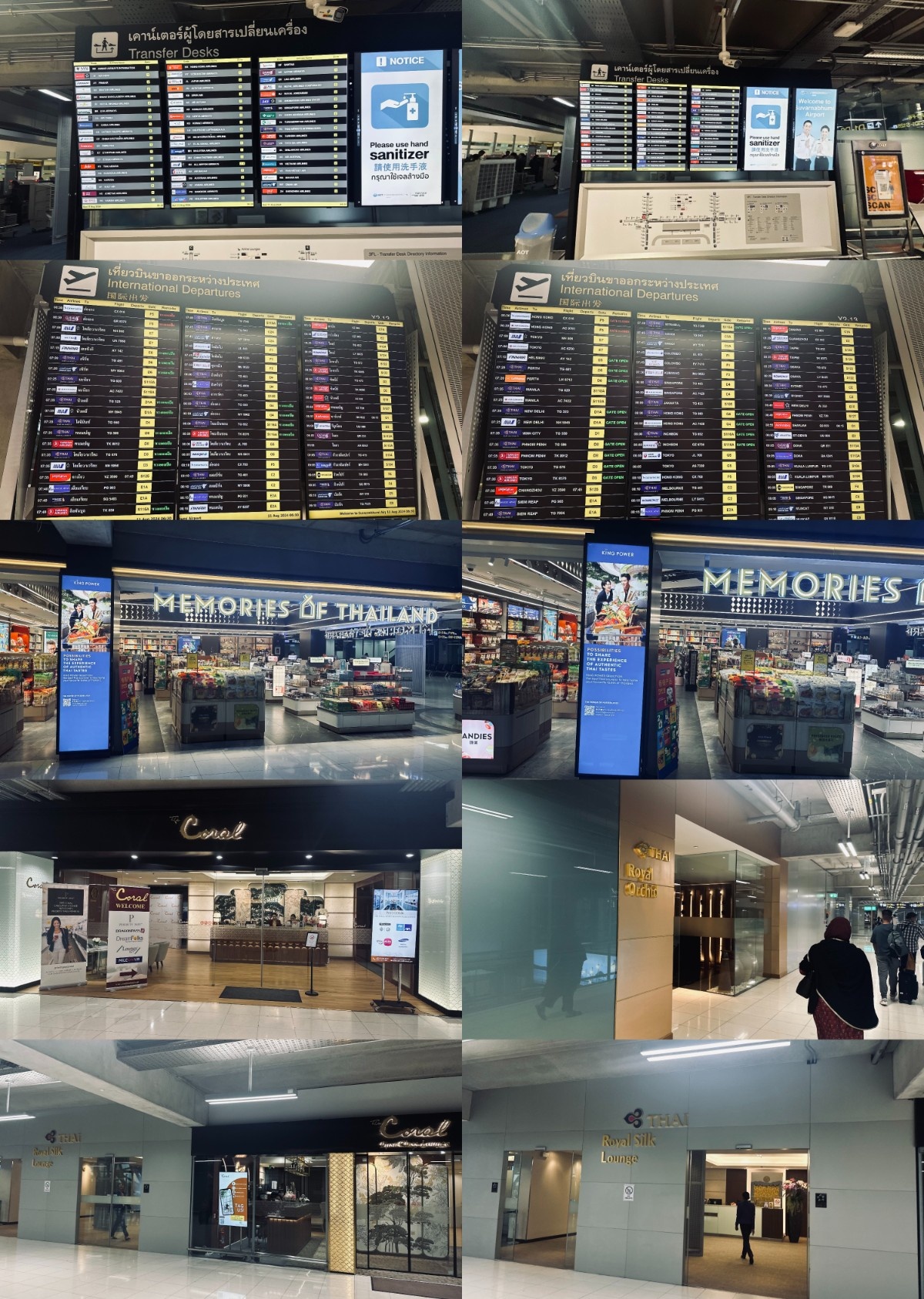
I neared the D gates and saw HS-THF, the first A350 — and Thai Airways aircraft — that I’d ever flown (back in June 2022), parked there. Ah, how I was pining to fly the TG A350 again after being shafted by Phetchabun and Co. — but no, the next aircraft would be the somewhat older 777-300ER.
Indeed there were a pair of them parked at Gates D3 and D4, with the latter hosting TG403 to Singapore, and from the nosewheel letters I figured out that my plane would be HS-TKU, named Acharasobhit. (I don’t know what that even means, because a quick Google search for that name throws only results about the aircraft itself, not some small Thai city or town as one would expect!)
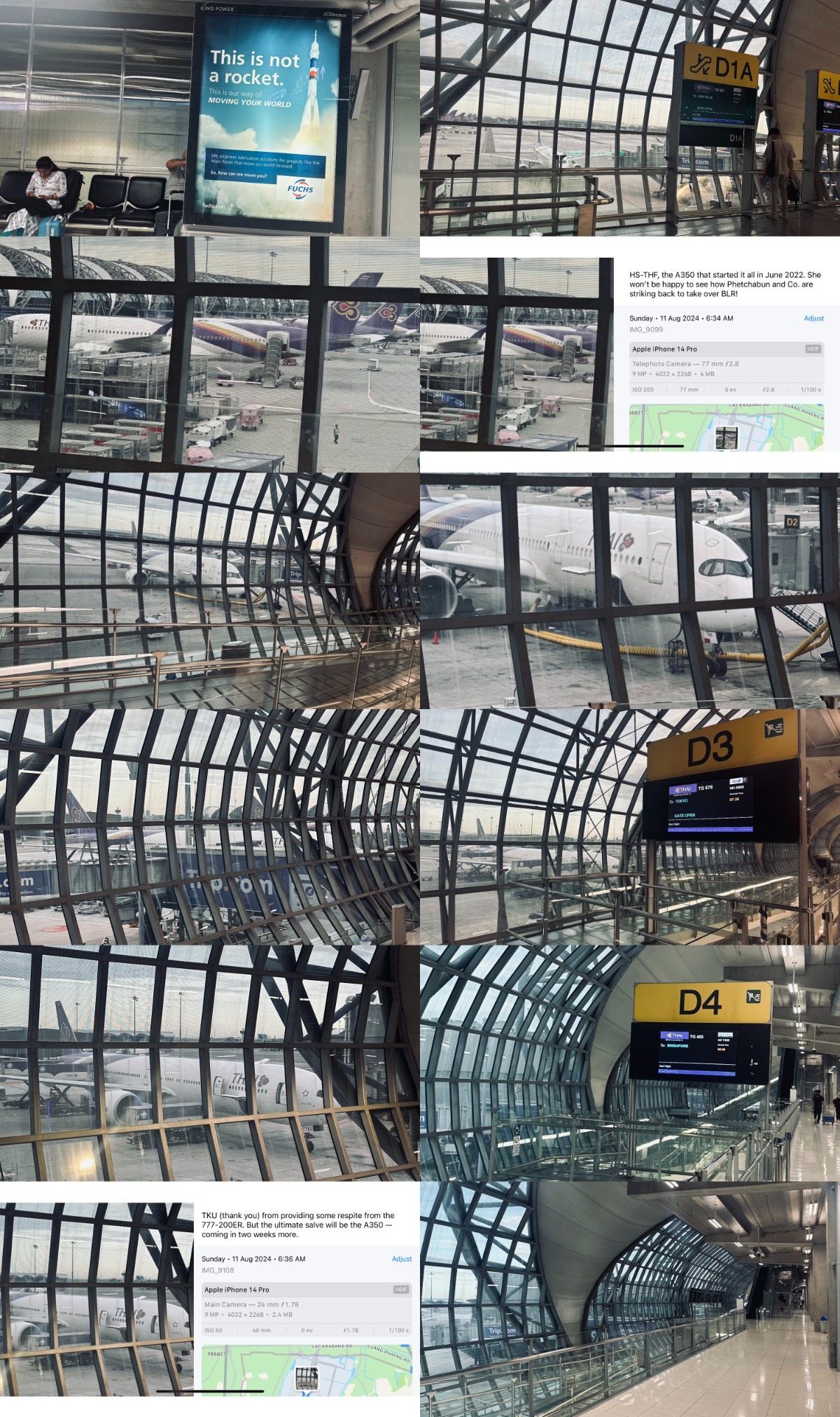
Some more assorted Flightradar24 spottings as I headed back to the central retail concourse. Among them was SQ506, an early-morning flight to BLR that is only scheduled on a few random days of the year — I happened to fly this in February 2025 at the early crack of dawn! A much more exotic arrival was Air Austral’s 777-300ER from the island of Réunion near Madagascar.
There was also an arrival from Ahmedabad* in western India, a route that’s almost always operated by the A320, but this time around it had given way to a 787-8, HS-TQD. This particular aircraft won’t last much longer at TG, as it and sister-ship HS-TQC are headed to Star Alliance partner LOT Polish Airlines some time in 2025–26, leaving four 787-8s (HS-TQA/TQB/TQE/TQF) in the TG fleet: I’ve yet to fly any of them.
*For the record, Ahmedabad is home to THE most prestigious IIM (management institute) in the country, ahead of even Bangalore — but I’ve picked the latter to study in after numerous rounds of deliberations and discussions.
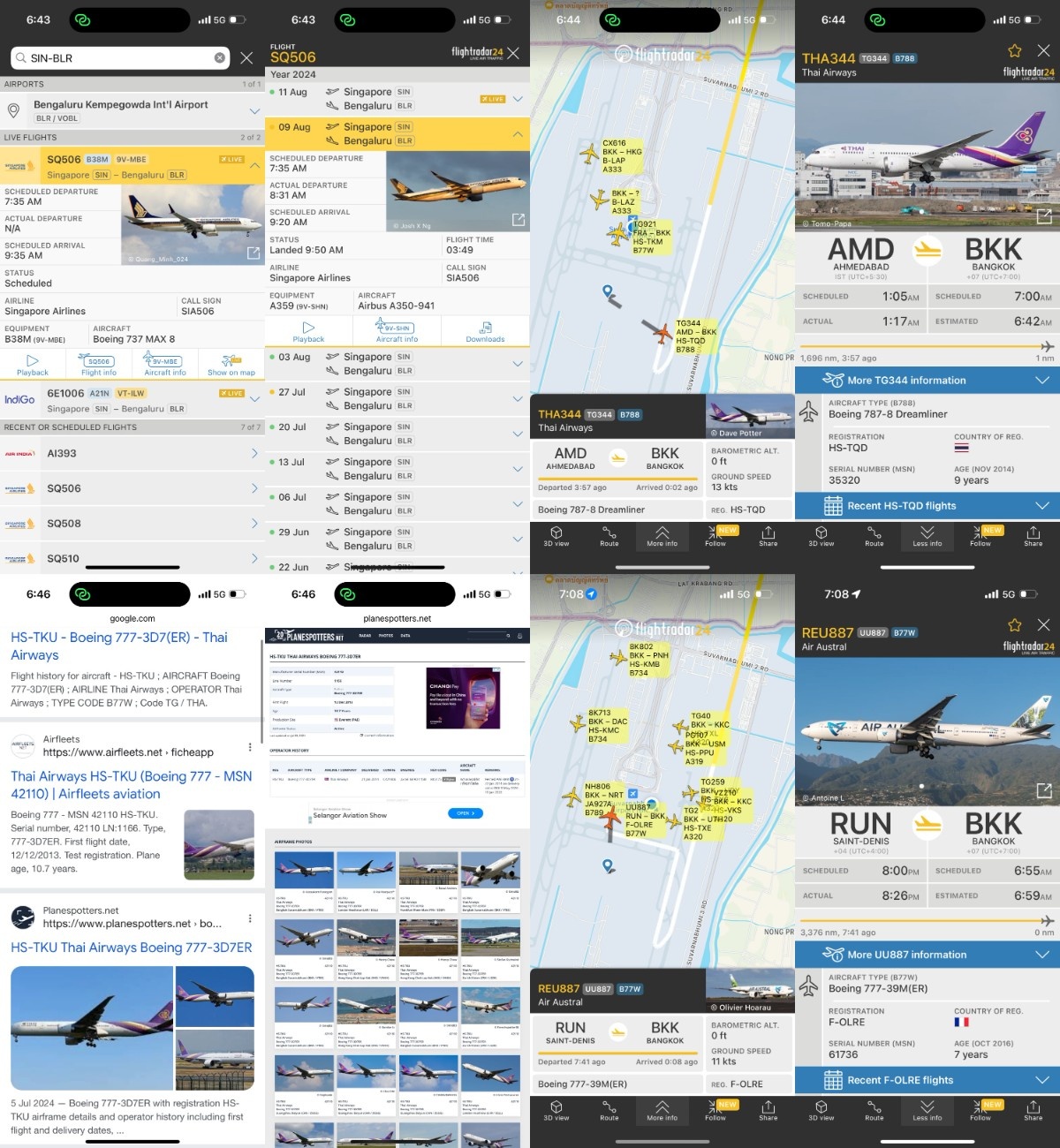
Luxury brands do not hide a bad-looking airport
With only half an hour to go for TG403 to board, I thought of grabbing a quick souvenir from one of the innumerable King Power duty-free stores. As with my first trip through this airport in June 2022, I went once again to the store with the cute little cloth elephants — which could be unzipped to reveal a large tote bag in them — and bought the pink variant this time.
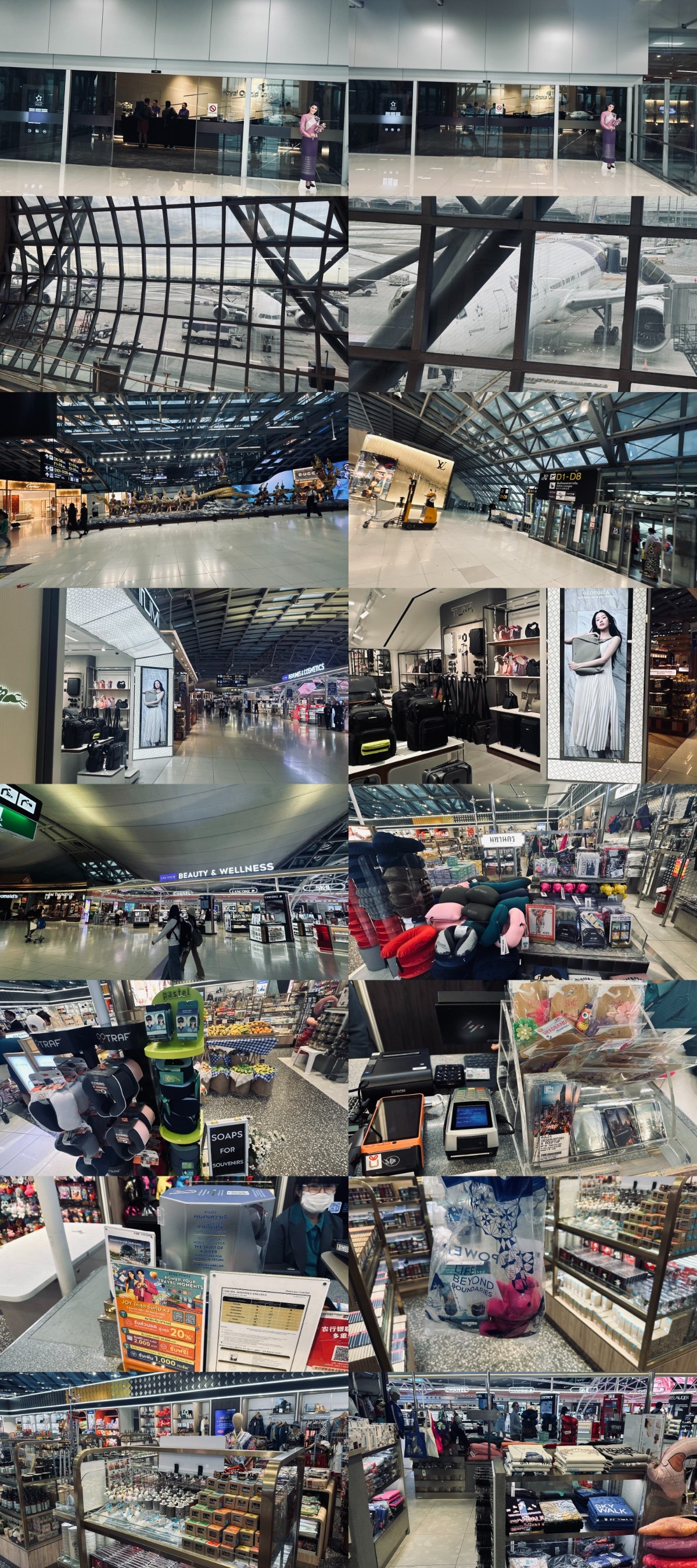
One of my numerous gripes about BKK, aside from the awful ambience and bad English, is the expensive food that’s less a means to satiate hunger and more an outright cash grab. Still, having not checked out Camden Food Co. (one of those grab-and-go delis) before, I went for a Mentos candy stick plus a pulpy orange juice, which came up to a sum of over THB 175 (US$5) combined. At least I wouldn’t have to spend longer here than absolutely necessary…
There were plenty of passengers, Indians in particular, headed on the 9-hour trek to Sydney on TG475. Fortunately the flights I’ve taken are almost all within four hours, and the longest was seven-and-a-half (the Emirates A380 just a few weeks before) — a record that I hope isn’t broken for long!
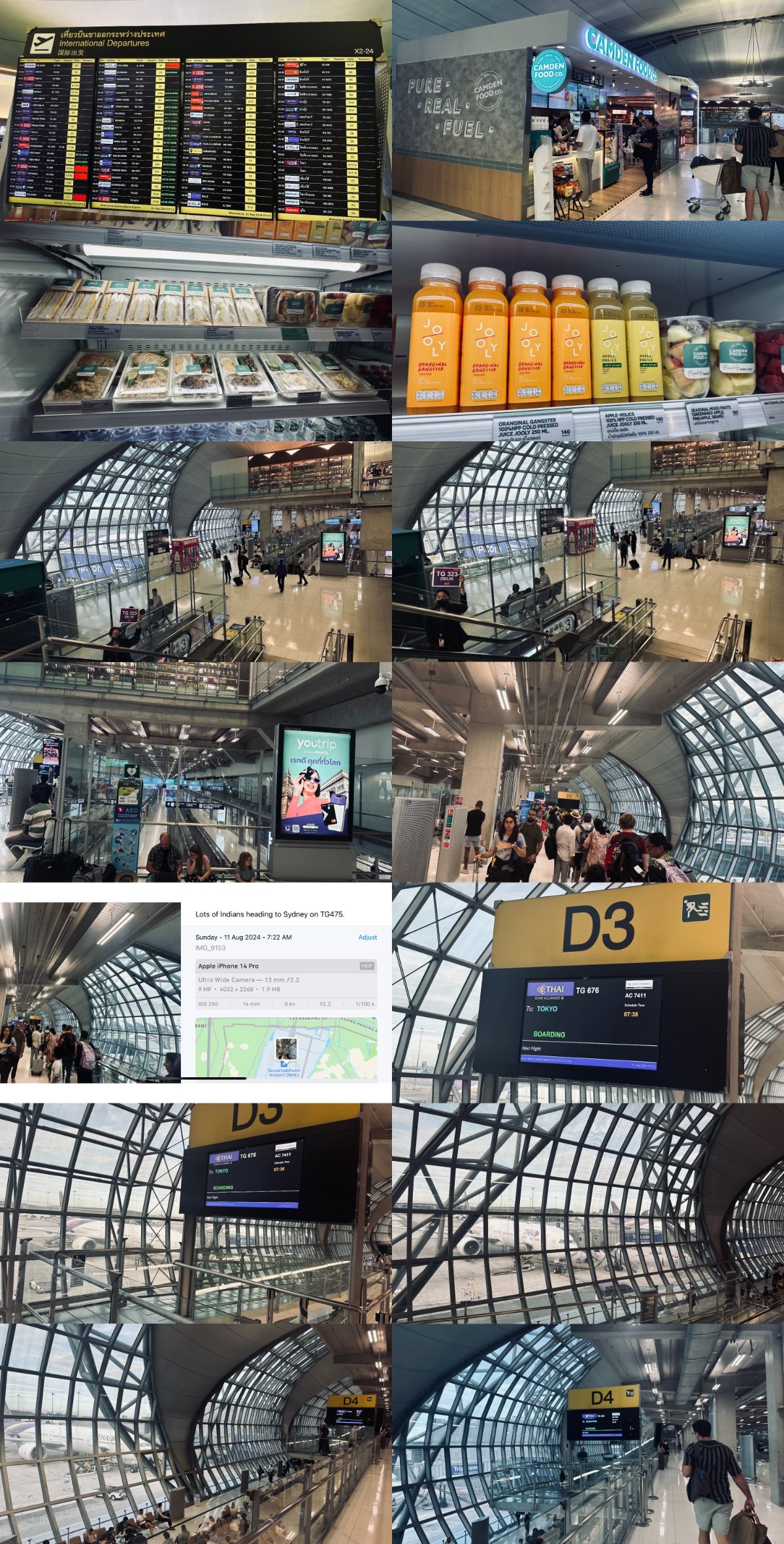

It wouldn’t be long before boarding was called, and I busied myself reading articles on TG’s fleet expansion plans. I must say, TG has done a fine job trying to revitalise its fleet, which for decades suffered from being a hodgepodge, piecemeal mishmash of A330s, A340s, A350s, A380s, 747s, 777s — both ER and non-ER — 787s and (until 2018) old 737-400s.
It may not reach the calibre of SQ, but Thai Airways — and also to an extent Malaysia Airlines with its new A330neos — is trending in a much better direction than Garuda Indonesia or Philippine Airlines, which continue to be beset by a lack of proper strategy.
At long last, for the first time since December 2022, I’d be boarding a TG aircraft that wasn’t a 777-200ER!
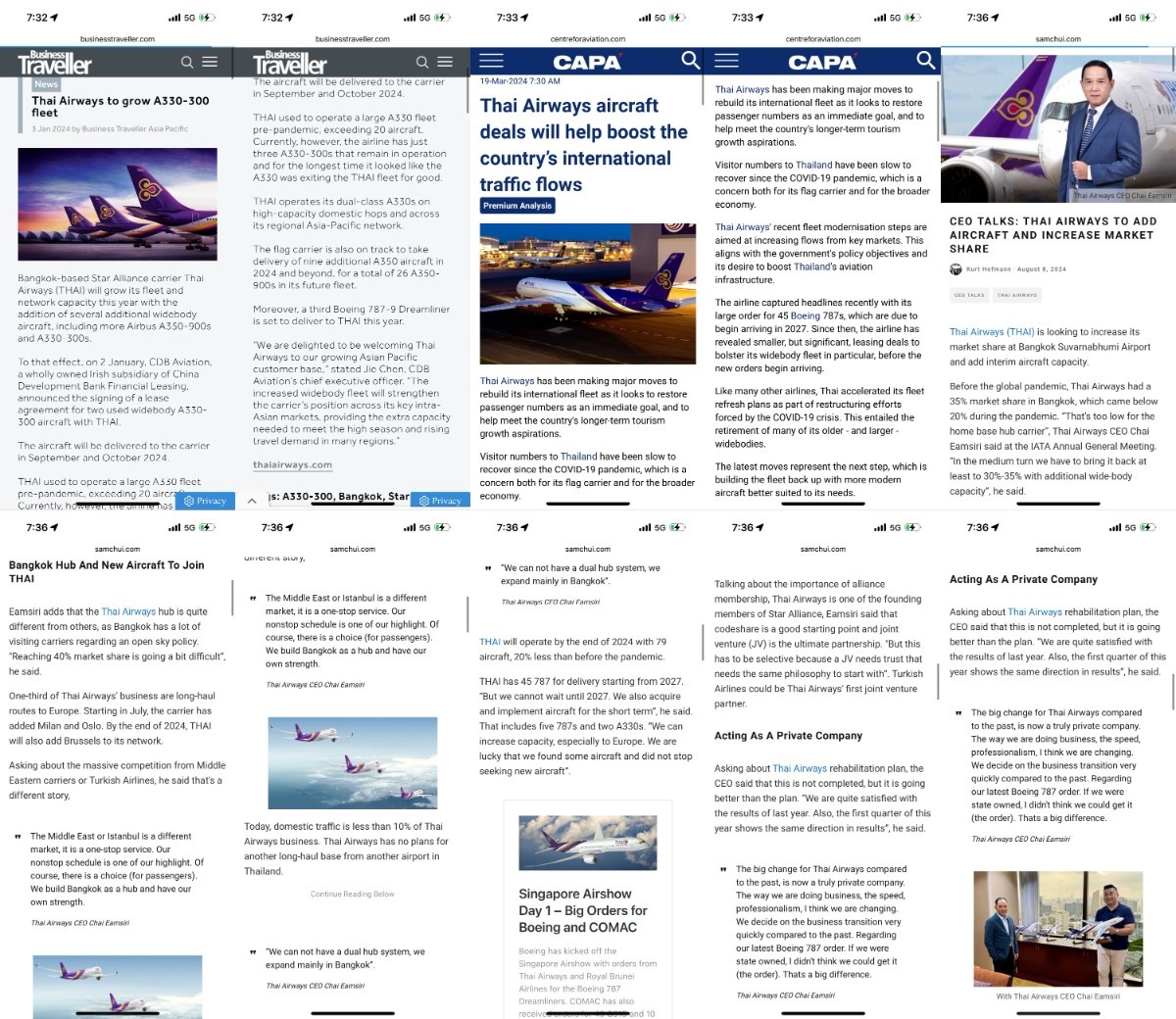
Part 2: A 777 with widescreen displays? At TG?! I’d never flown before…
Thai Airways International TG403 | Sunday, 11 August 2024 | Bangkok Suvarnabhumi (BKK) to Singapore Changi (SIN).
Aircraft: HS-TKU, Boeing 777-300ER, named Acharasobhit
Age: 9 years 8 months at the time (built: 12 December 2013, delivered: 21 January 2014)
Seat: 71K (starboard side, window)
Boarding: 7:30am Indochina Time (ICT), UTC +7 (8:30am SGT, UTC +8)
Departure: 8:28am ICT (9:28am SGT)
Arrival: 11:16am SGT (10:16am ICT)
Duration: 1 hour 48 minutes
Notes:
• First flight on the Thai Airways 777-300ER (as against the -200ER) and second flight on an aircraft other than the A350 or 777-200ER, the first being in December 2022 on the 787-9 with rainbow mood lighting.
• Fourth flight overall on the 777-300ER: in spite of its overall popularity, I don’t fly this majestic beast all that often. The previous ones were Emirates to and from Dubai in June 2022 and KLM to Denpasar — the one with the SkyTeam livery — in June 2023. Later in 2024, in November, I’d also fly Qatar Airways’ non-Qsuite 777-300ER on the fifth-freedom hop from Phnom Penh to Ho Chi Minh City.
A 777 with big, airy cabins and 16:9 displays? YES PLEASE!
The sensation I was feeling more than any other was an immense sense of relief. Relief that I’d finally managed to get, if not the A350 I’d so badly desired, at least something that was not a dilapidated old -200ER — to be precise, the more modern and mighty version of the 777.
The Business cabin might not have been the most cutting-edge, but it was definitely tastefully designed with all manner of wood-panelled elements — something that’s usual for TG.
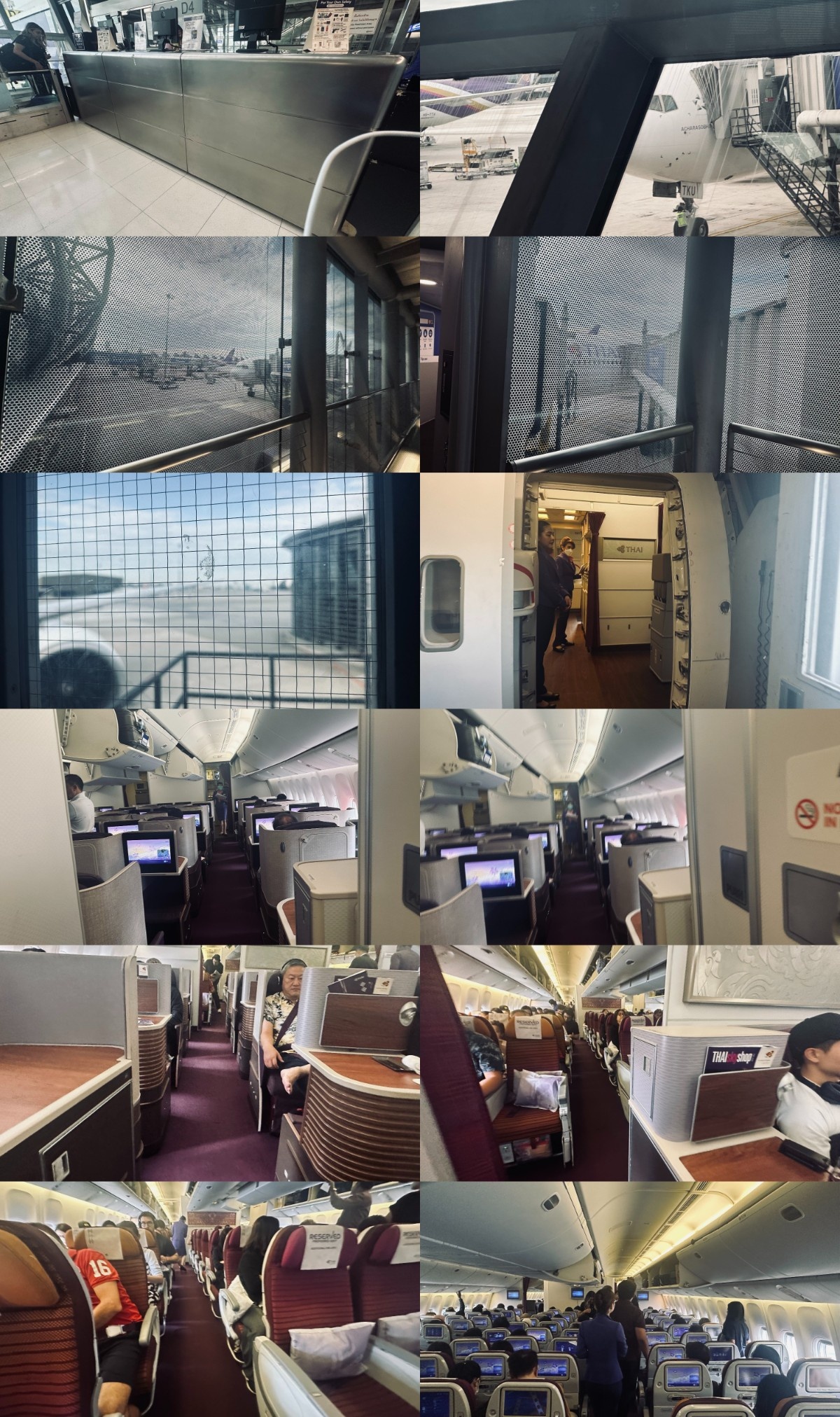
I reached my seat, 71K, at the far back — with only two seats in the left and right sections due to the plane’s curvature. In general, it was a spacious ride, thanks to the older and wider 3-3-3 configuration as opposed to the 3-4-3 that’s standard on 777s nowadays — and which TG will no doubt adopt with its upcoming order of 777s. The 16:9 screens with their chunky white bezels, so representative of the early 2010s, were a delight to behold… even if their resolution wasn’t the best.
During boarding, a video promoting TG’s so-called ‘Taste of THAI Tales’ collaboration with leading Thai chefs was screened for all passengers. I did appreciate the depth of exploring the various regions of Thailand and the rich culinary culture of the country, plus a generous sprinkling of history, civilisation and trade. But for all the culinary — and cultural — knowledge that the chef displayed, she unfortunately spoke with very broken English: something that’s unfortunately much worse for Thailand than other Southeast Asian countries.
At least the video wasn’t screened while the plane was taking off — which was exactly what happened with my A350 ‘revenge trip’ two weeks later…
Bit by bit, Thailand — and the ugly Suvarnabhumi airport in particular — has steadily been losing its allure for me, despite it being such a fascinating place for global tourists otherwise. I’d much rather revisit Vietnam, Indonesia or Cambodia than spend any more time than I need to in this English-challenged kingdom.
After this, of course, the rainforest-themed safety video was played, and interestingly it was criticised as ’not Thai enough’ when it was released in May 2018 — thanks in large part to showing mostly South American flora and fauna! (You really should read the comments on that Bangkok Post article…) Clearly others find the video dazzlingly attractive; as for me, I’ve seen better, more imaginative videos.
Admittedly there’s too much glare and too little display brightness in the below pictures of the culinary and safety videos, aside from the chunky white bezels and seat contours taking up most of the frame of view. But I’ll still gladly take this ANY DAY over the awful -200ER. Good riddance!
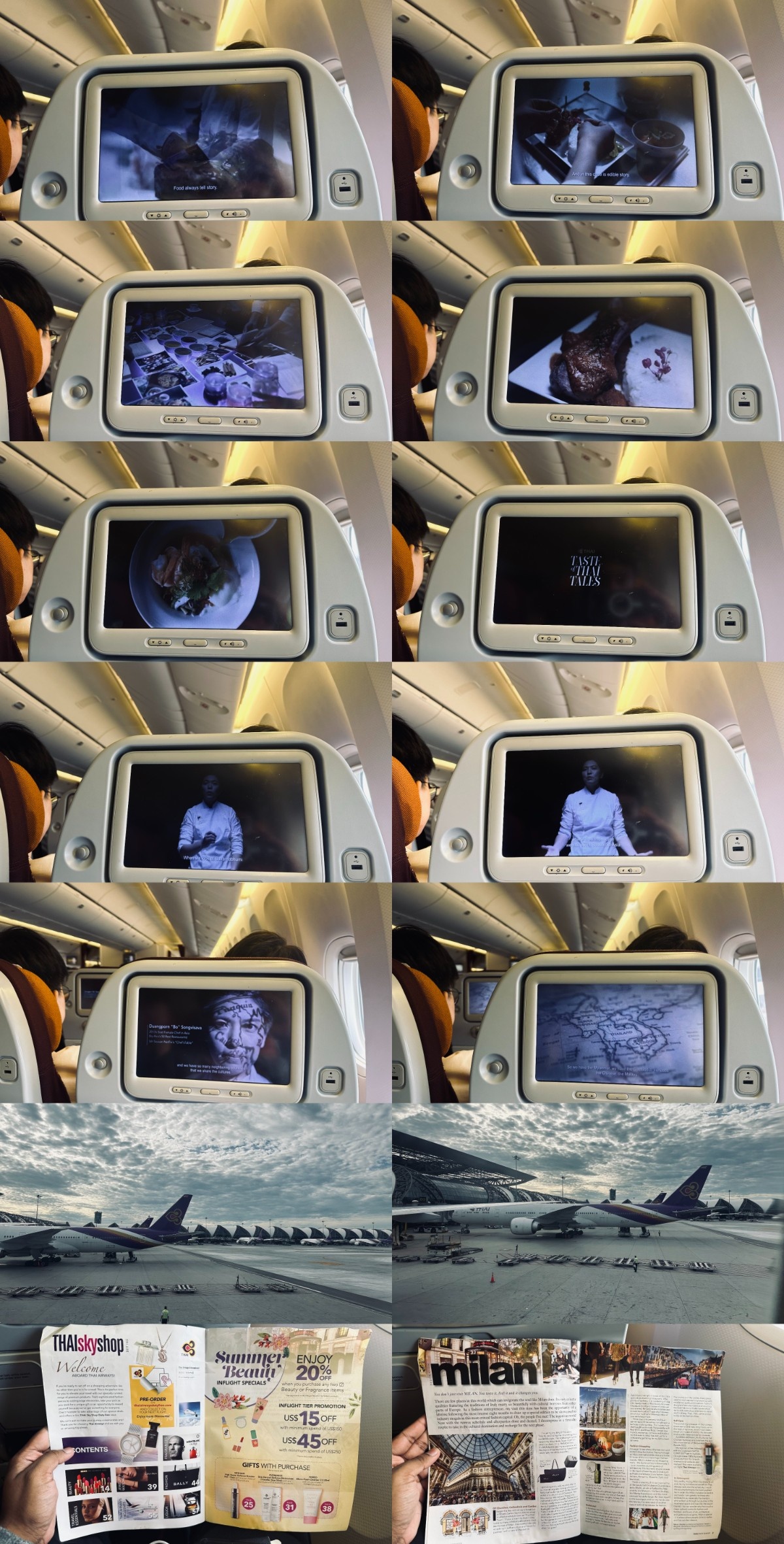
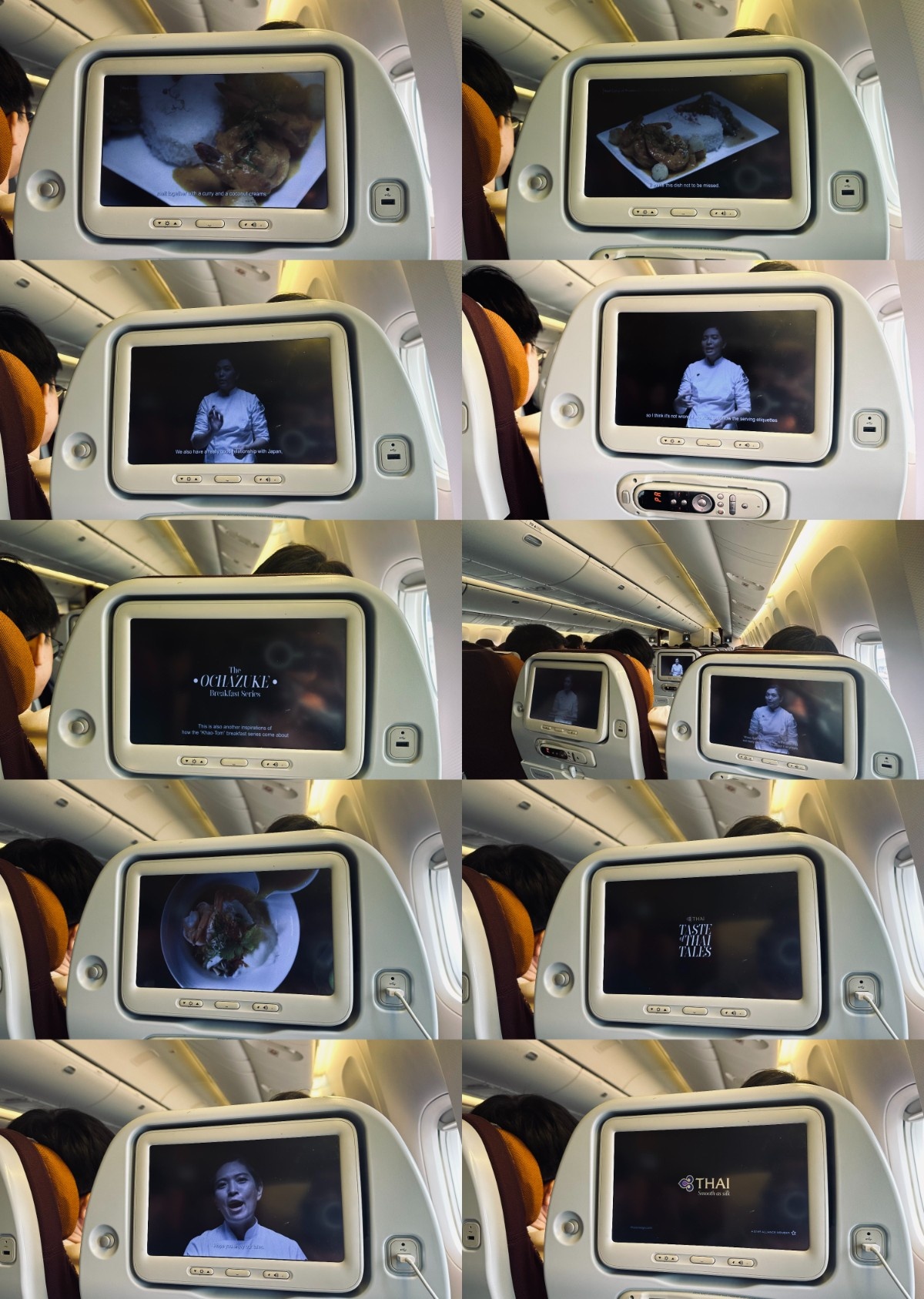
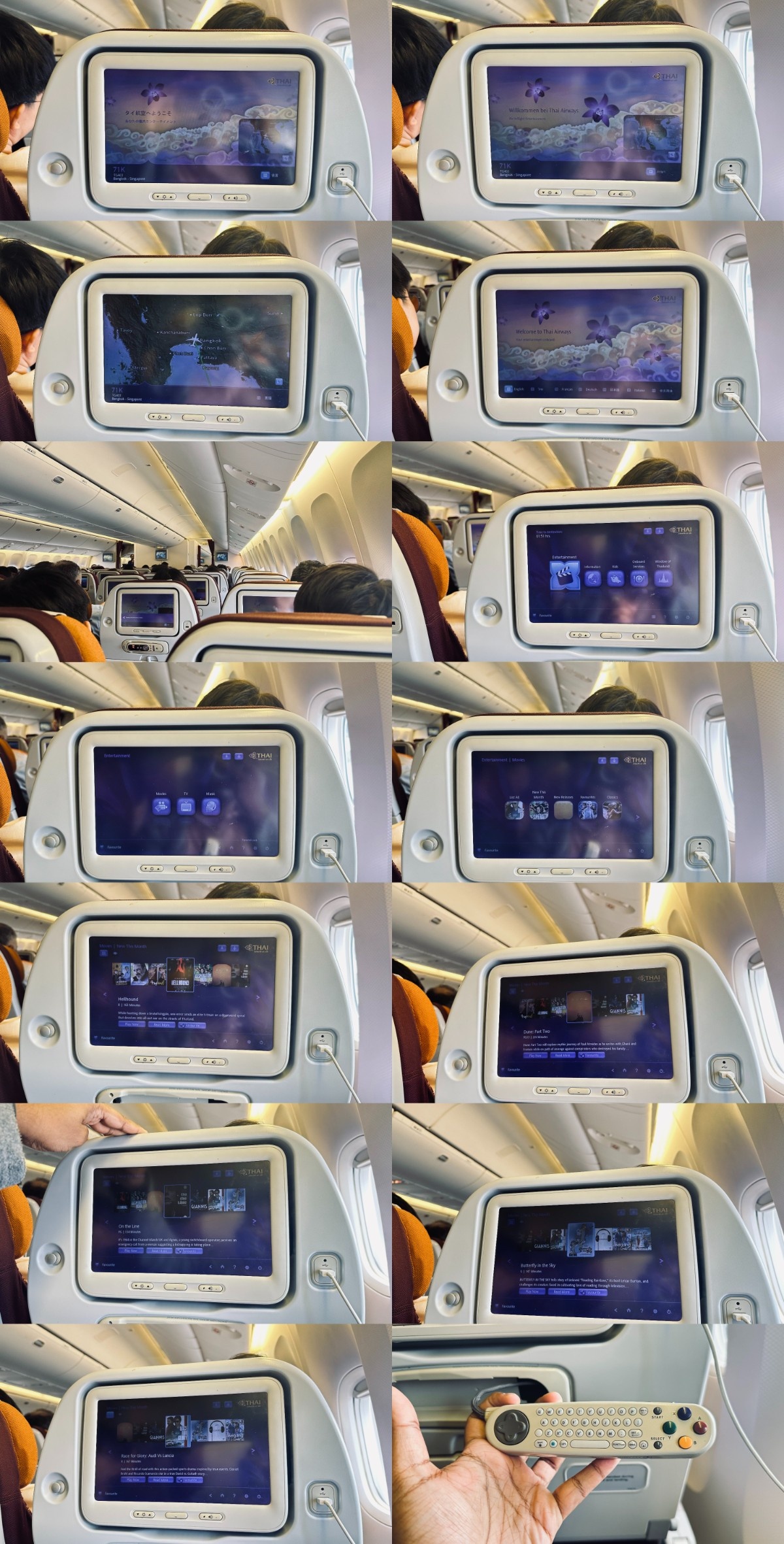
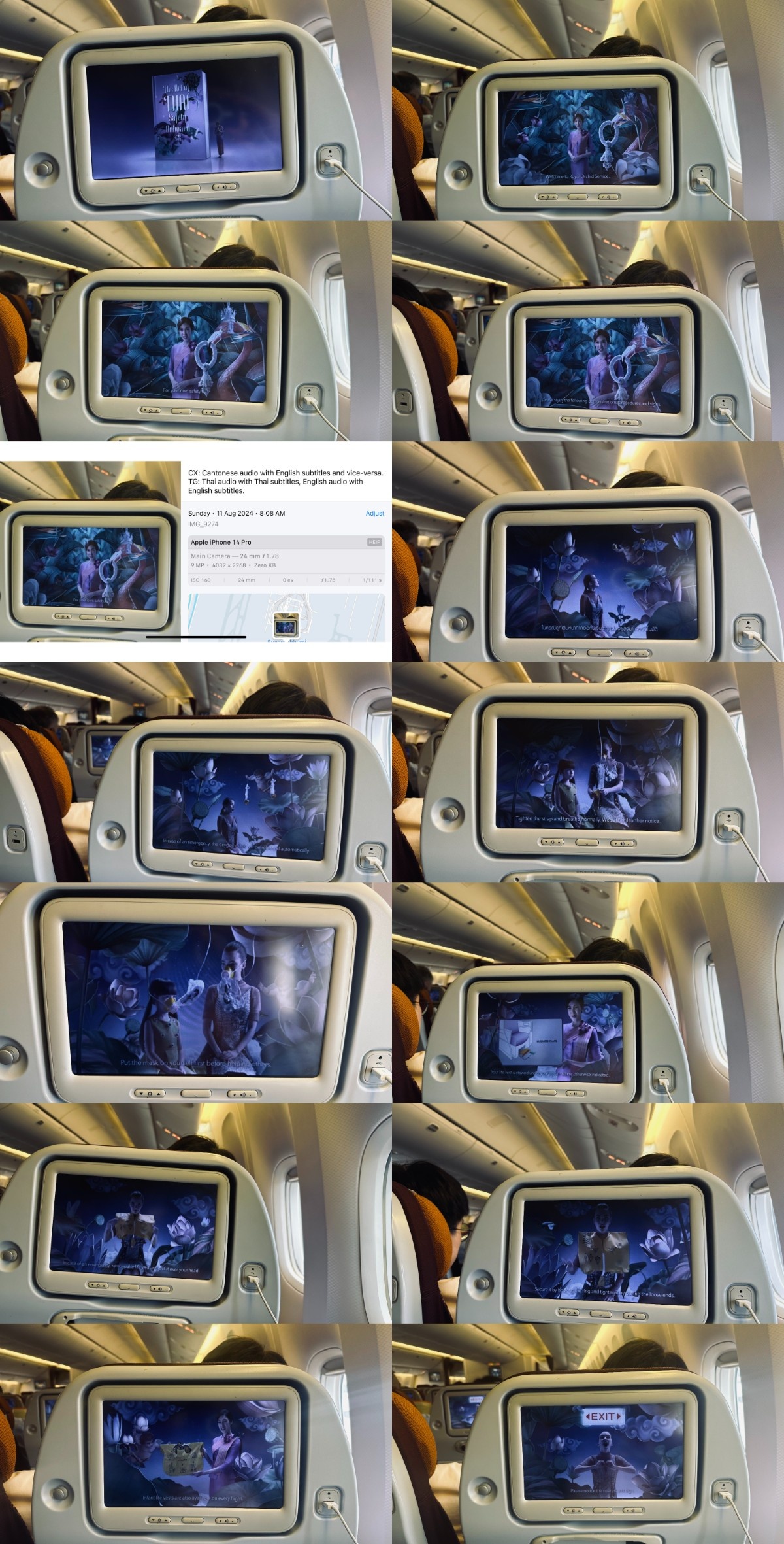
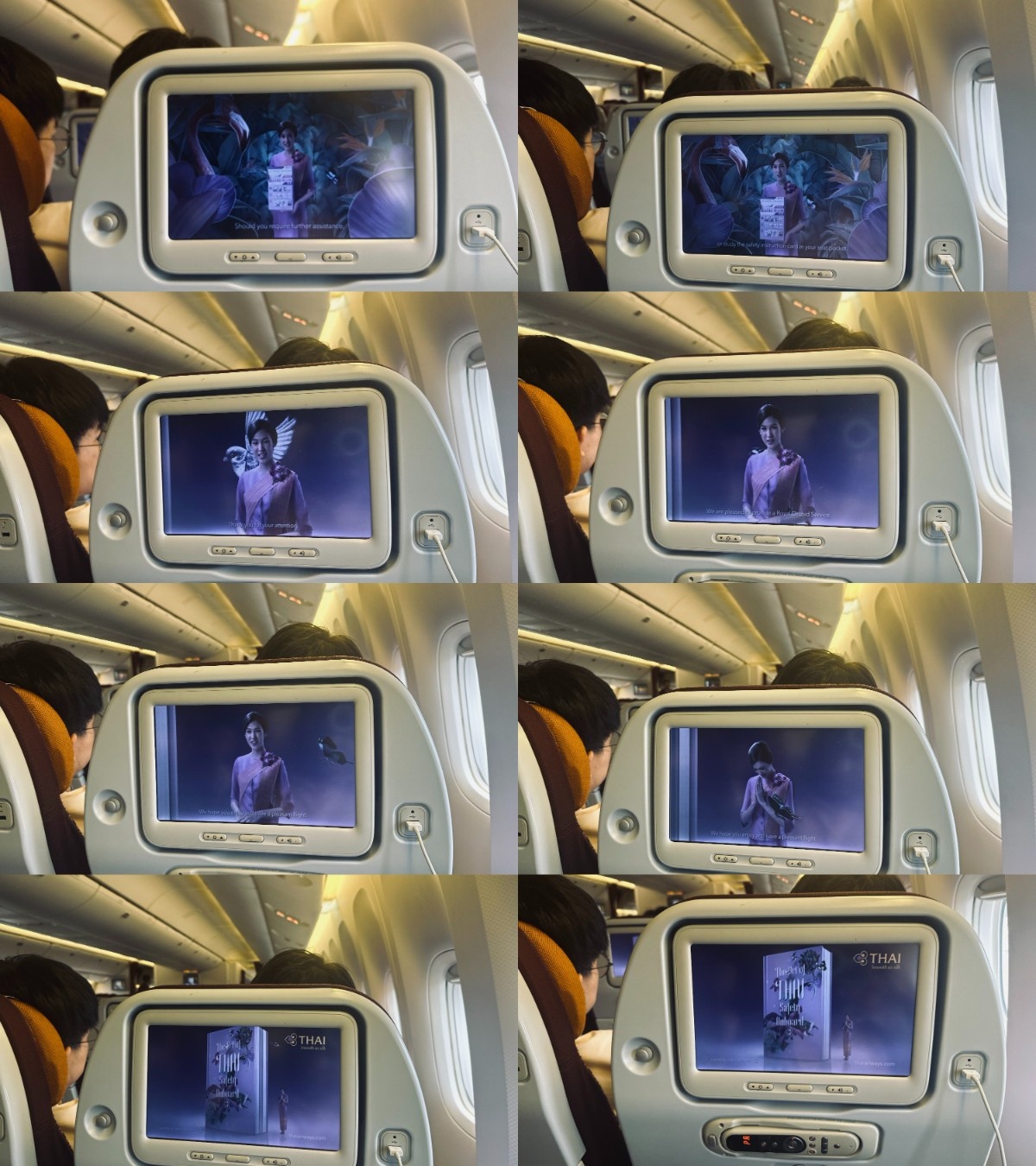
Before very long we showed up on the map, just as the early-morning SQ706 started pulling into the gate, operated by A350 9V-SHG. No longer having to suffer the gloomy interiors of Suvarnabhumi’s main terminal, I instead revelled in the marvellous exterior shots of the building and all the planes.
An ANA 787, an Air India A320neo, a pair of Qatar 777s (including one in the Oneworld colours), a Cathay A330-300 — which I flew on the BKK–SIN fifth-freedom in March 2025, just before it was discontinued — plus more 787s from Etihad, Scoot and Oman Air… BKK is heaven outside, hell inside!
The one thing I couldn’t catch was the Air Austral 777 (wrongly written below as a 787-9), and only because I had to turn off my phone for a bit to recover some storage.
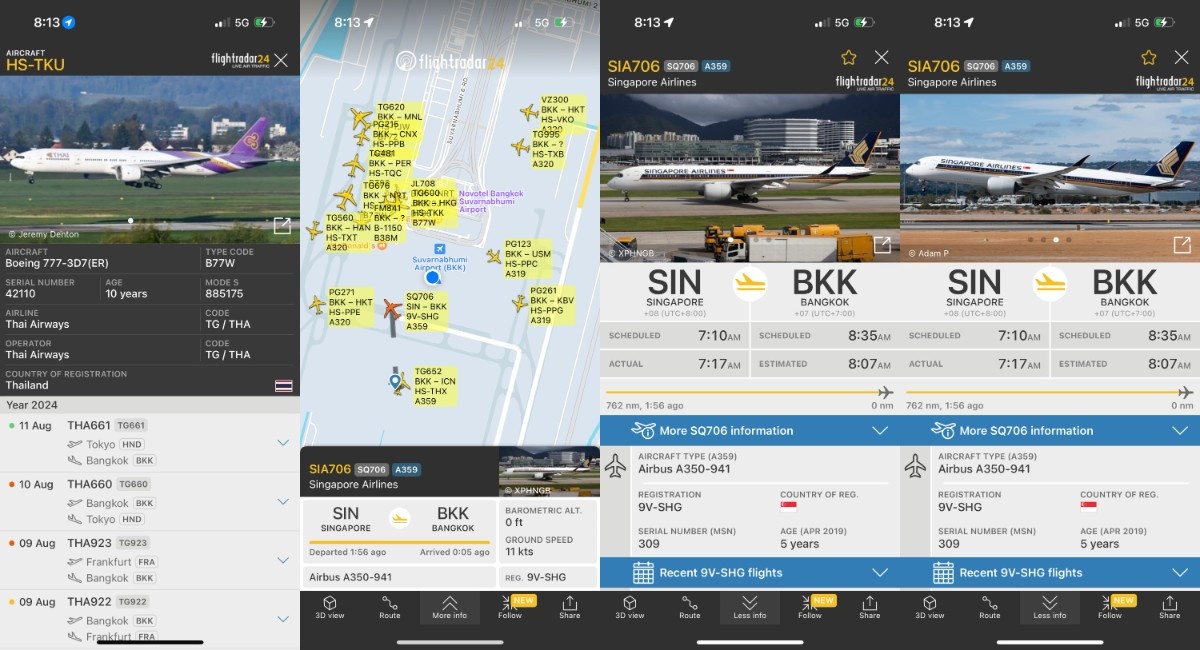
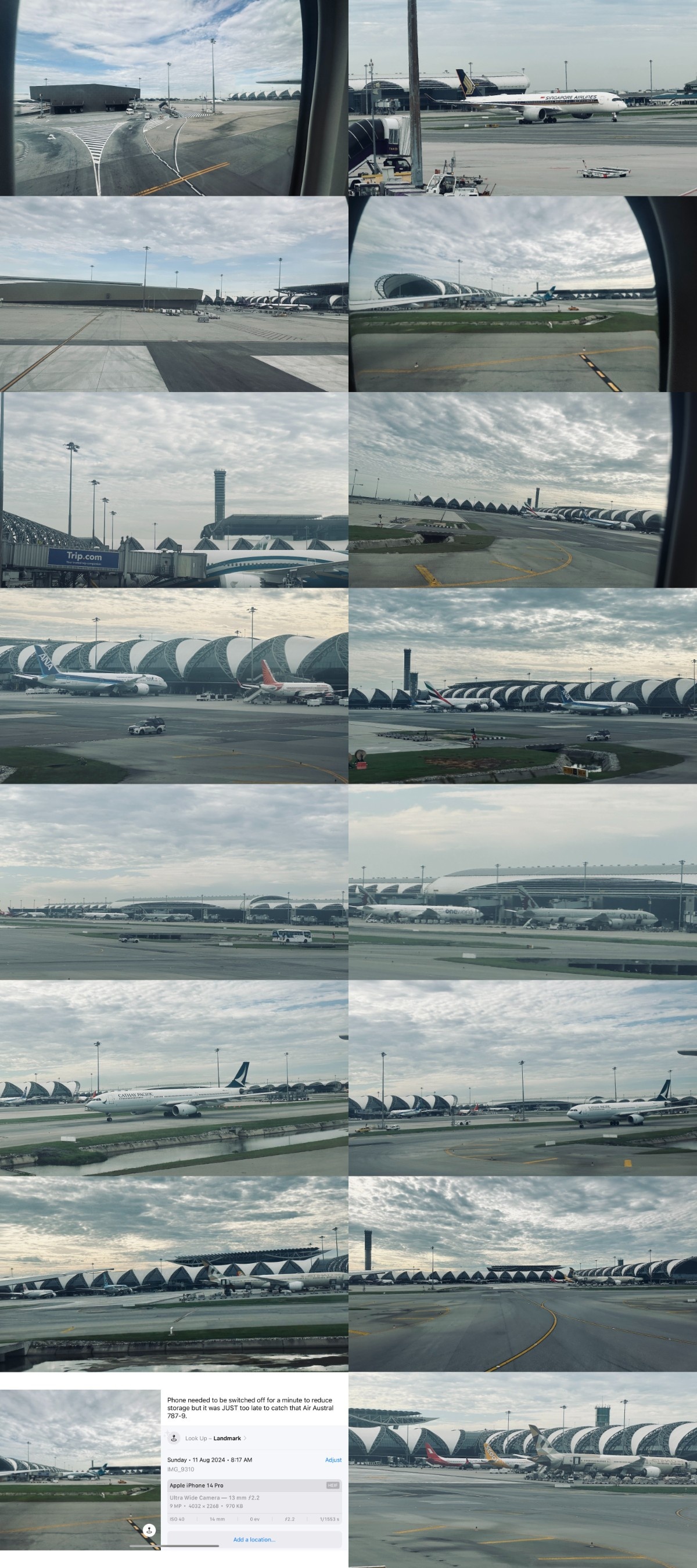
Another special 787 now drew close, and in fact I’d seen this same exact plane some days before at HKG. This was JA823J, a JAL 787-8 painted in the Expo 2025 Osaka special colours, and this pretty white bird with red-and-blue-and-green decorations was tantalisingly close — almost to the touch!
Acharasobhit headed past the cargo section, including a China Airlines cargo 777, before finally rushing to the runway.
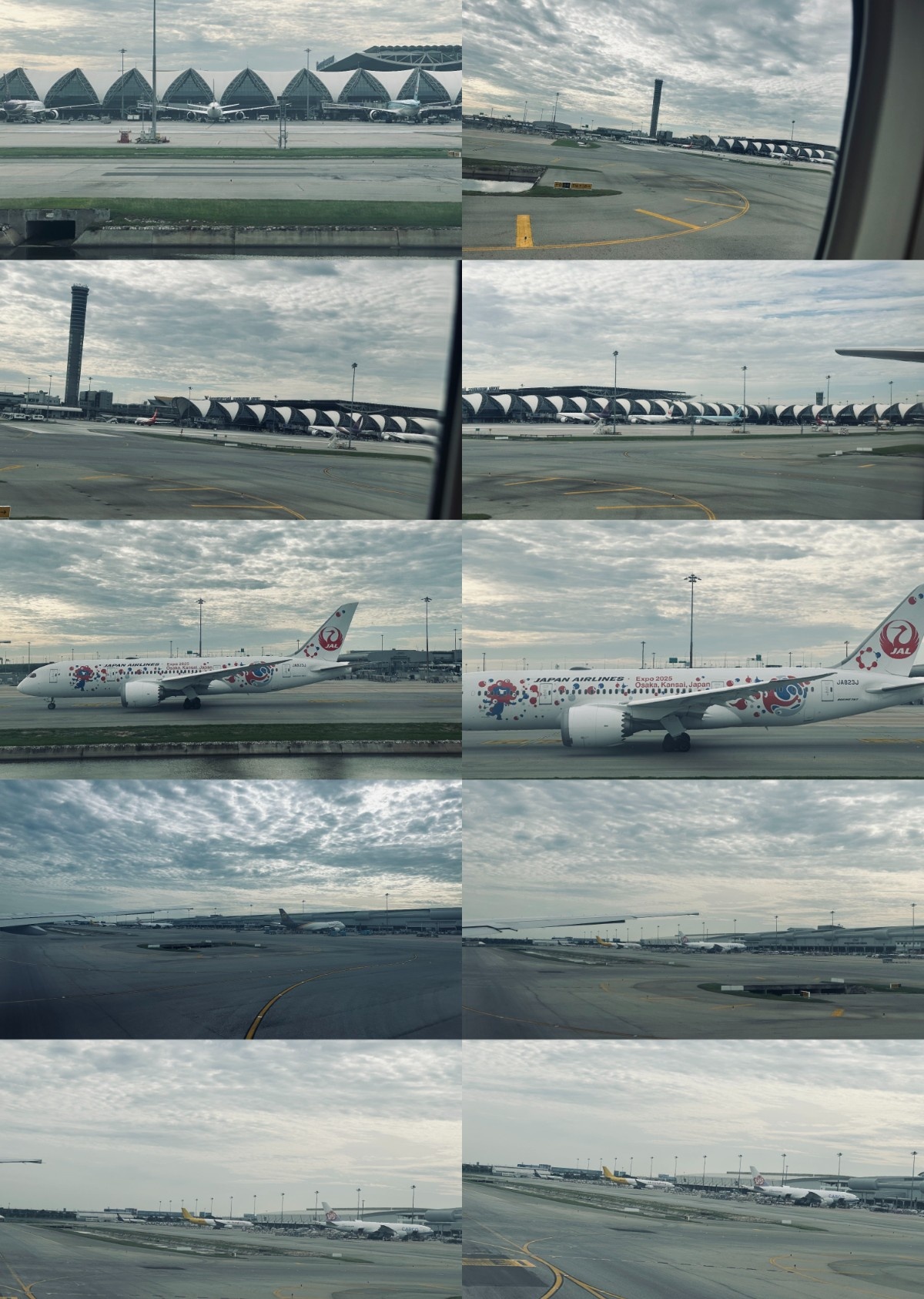
There were plenty more interesting early-morning arrivals: the ME3 (EK, QR, QY) plus Air Arabia from Sharah, not to mention that exotic Air Austral 777-300ER from Réunion Island. As above, I couldn’t spot the Air Austral plane this time, but I did get the opportunity to do so two weeks after — and it was quite a beauty!
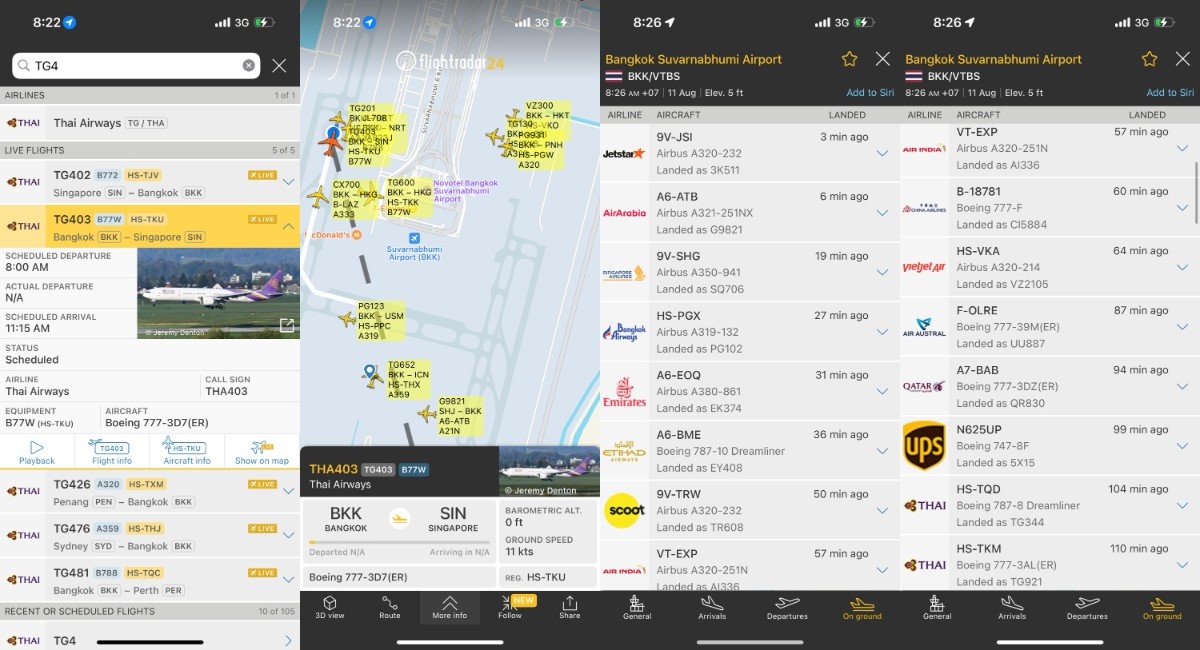
And then, all of a sudden, my favourite non-wingletted aircraft in the world — yes, the 777-300ER narrowly trumps the 787 in that regard — finally took off into the morning skies over the Thai capital, before heading down south over the crystal-blue Andaman Sea coast.
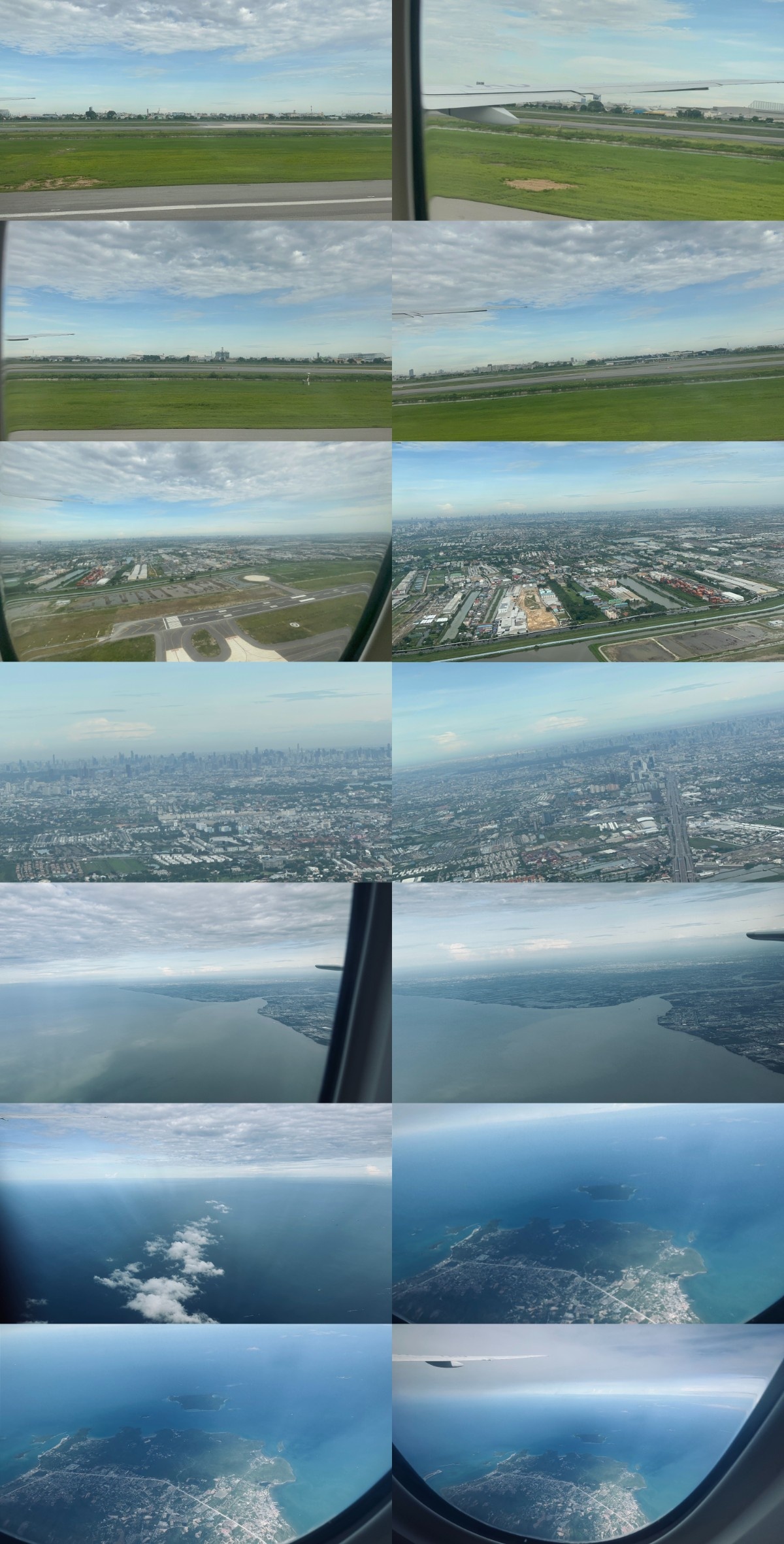
Something old, something new: Windows into Thai culture inside, oceans outside
I quickly turned to the IFE, well familiar with the violet-skinned interface from my previous A350 flights. There was of course no tail camera on this 777, neither was the picture quality that great, but anything beats its pathetic predecessor.
Even so, you don’t really need a tail camera or seatback IFE — all the more so with TG’s very limited selection (case in point: only 3 Indian movies) — when you have those absolutely gorgeous ultramarine ocean and island views.
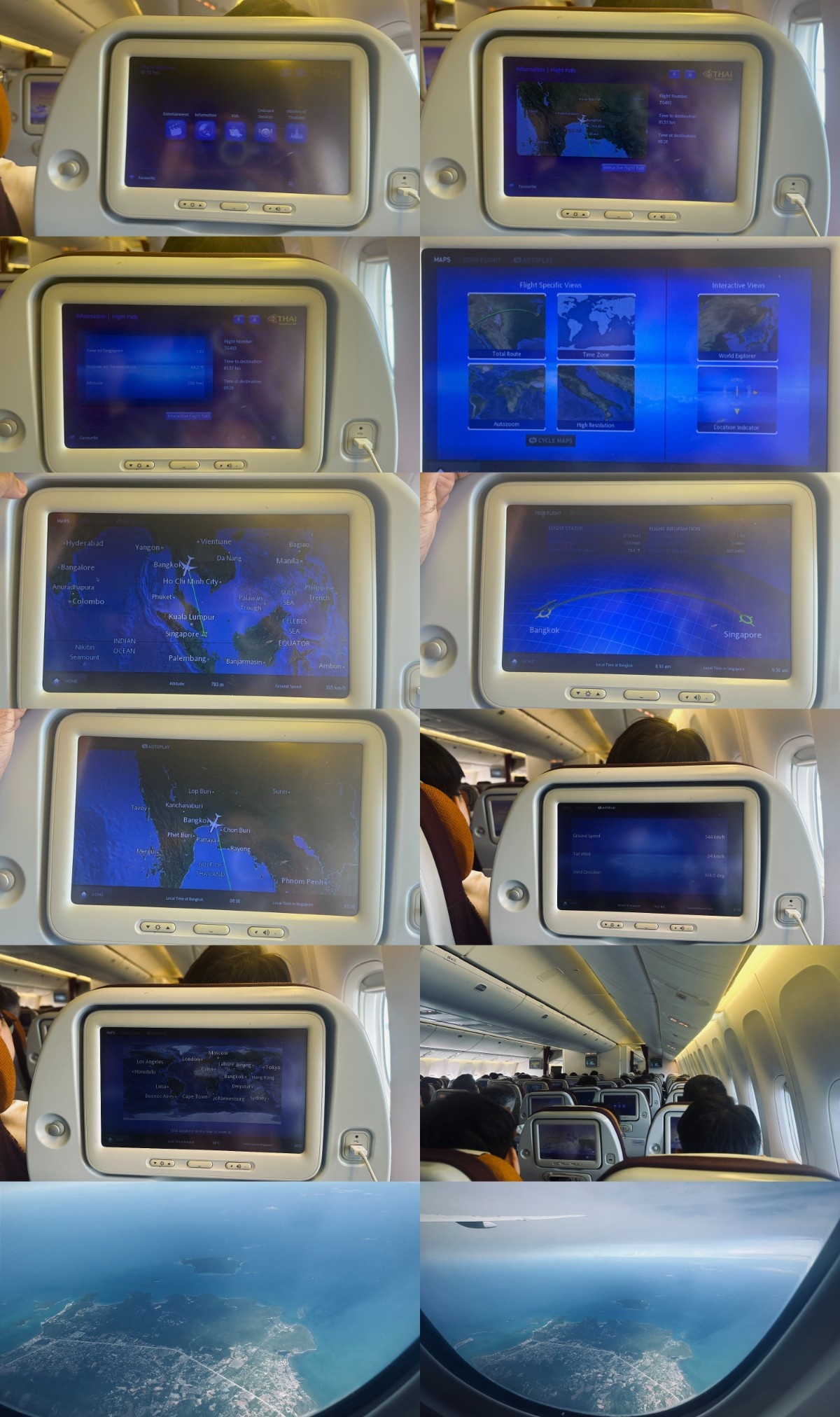
For some reason I’d decided to pre-select the HNML (Hindu Meal) online as part of the check-in process’s ‘special dietary requirements’ screen, as I was tired of the same old omelettes and sausages being served for breakfast. Big mistake!
The South Indian breakfast served — vada (lentil doughnuts), pongal (rice cooked in milk) and sambar (lentil-based curry) — left much to be desired. Neither did the big, dry piece of paratha (Indian bread) help matters much, and the only saving grace was the dessert, which I believe was gajar ka halwa (carrot pudding) and TG’s typical cut fruits.
So much so that I looked longingly at other passengers making their breakfast selections, and swore not to order a Hindu breakfast on a non-Indian airline. (As a counterexample of how it can be done right, look at my previous Air India A350 review in Premium Economy, where similar South Indian dishes retained their flavour.) Even so, that was the only disappointment on this sector.

The meal done, I now turned to an old favourite of mine from my first-ever TG A350 flight in 2022: the Window of Thailand section with its exhaustive overviews of Thai culture, festivals and cuisine — including recipes from start to finish. (Full resolutions for image 1, image 2, image 3, image 4.)
That said, the content hadn’t been updated for a decade, which was also the age of this plane… but then again, some things don’t need to be updated. If it ain’t broke, don’t fix it! (And the same philosophy goes for the 777-300ER in general: not the most cutting-edge, but mighty and majestic all right.)
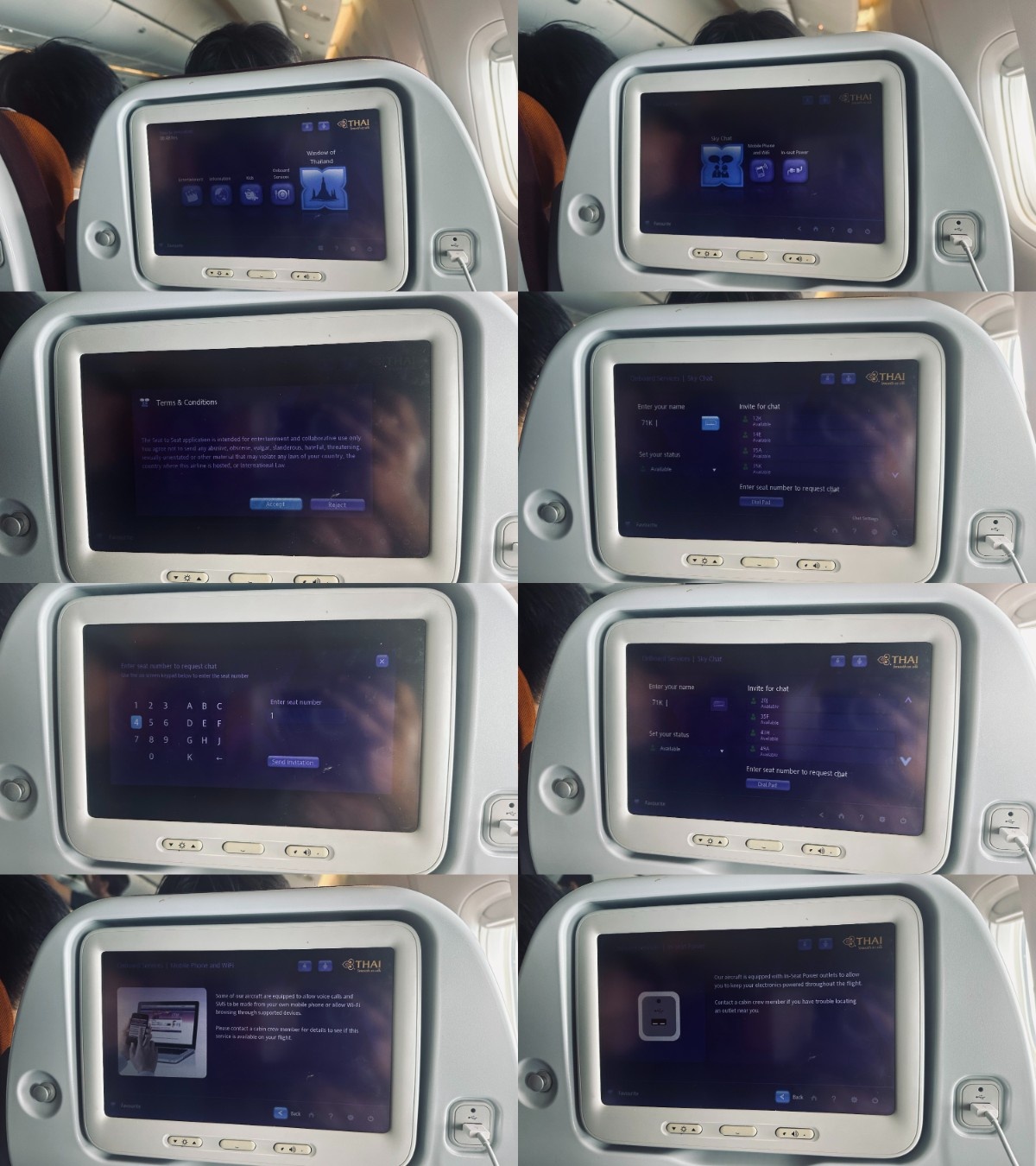
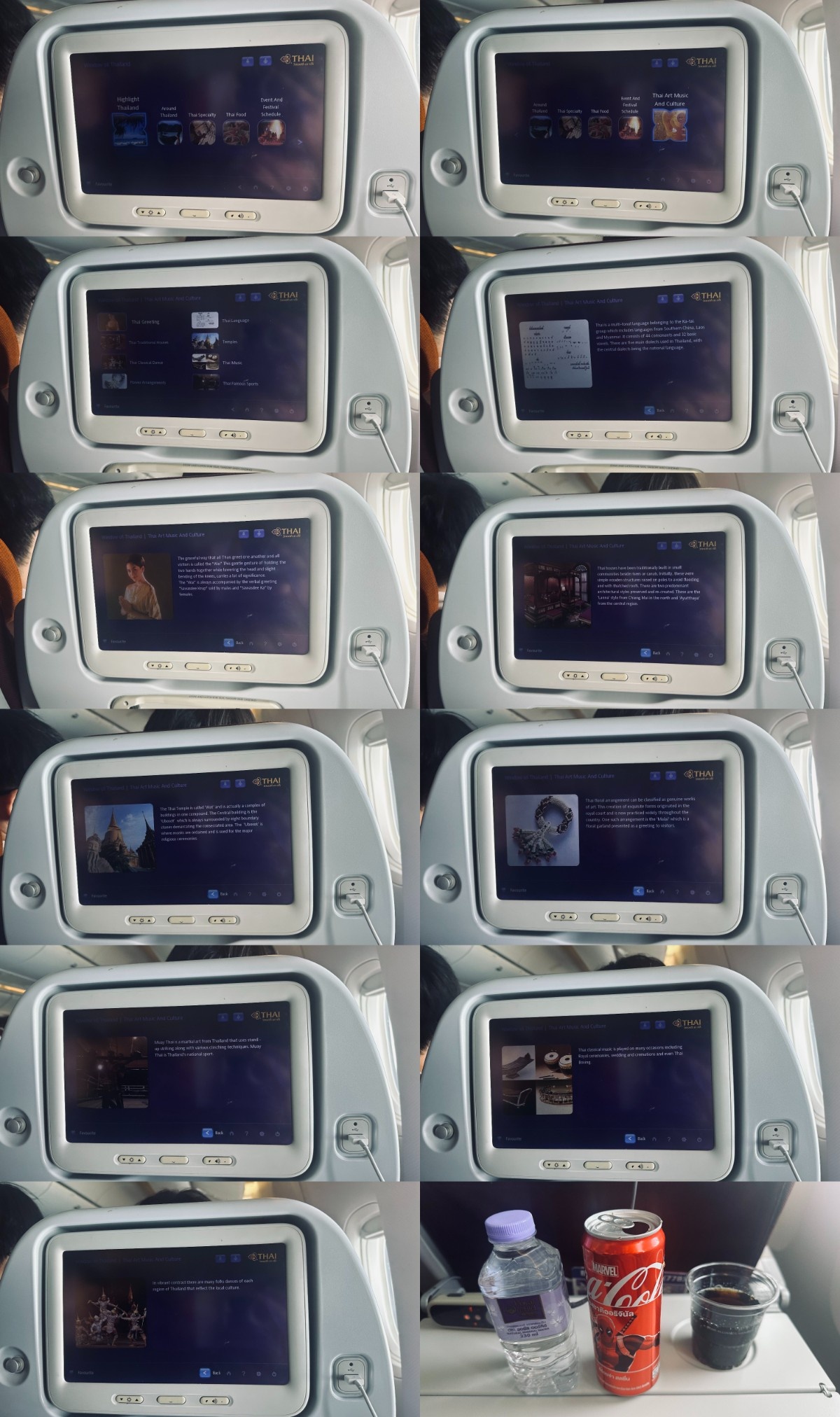
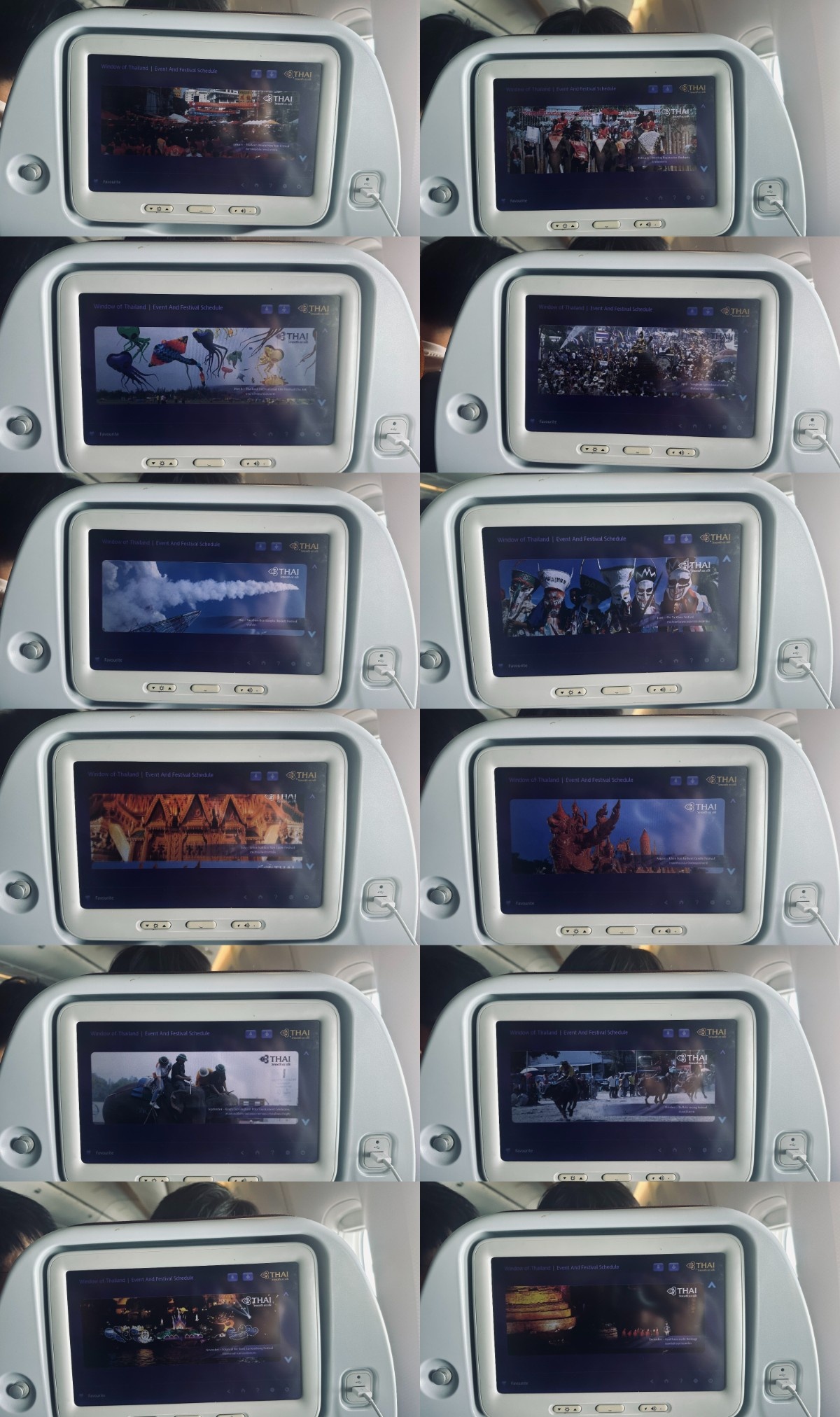
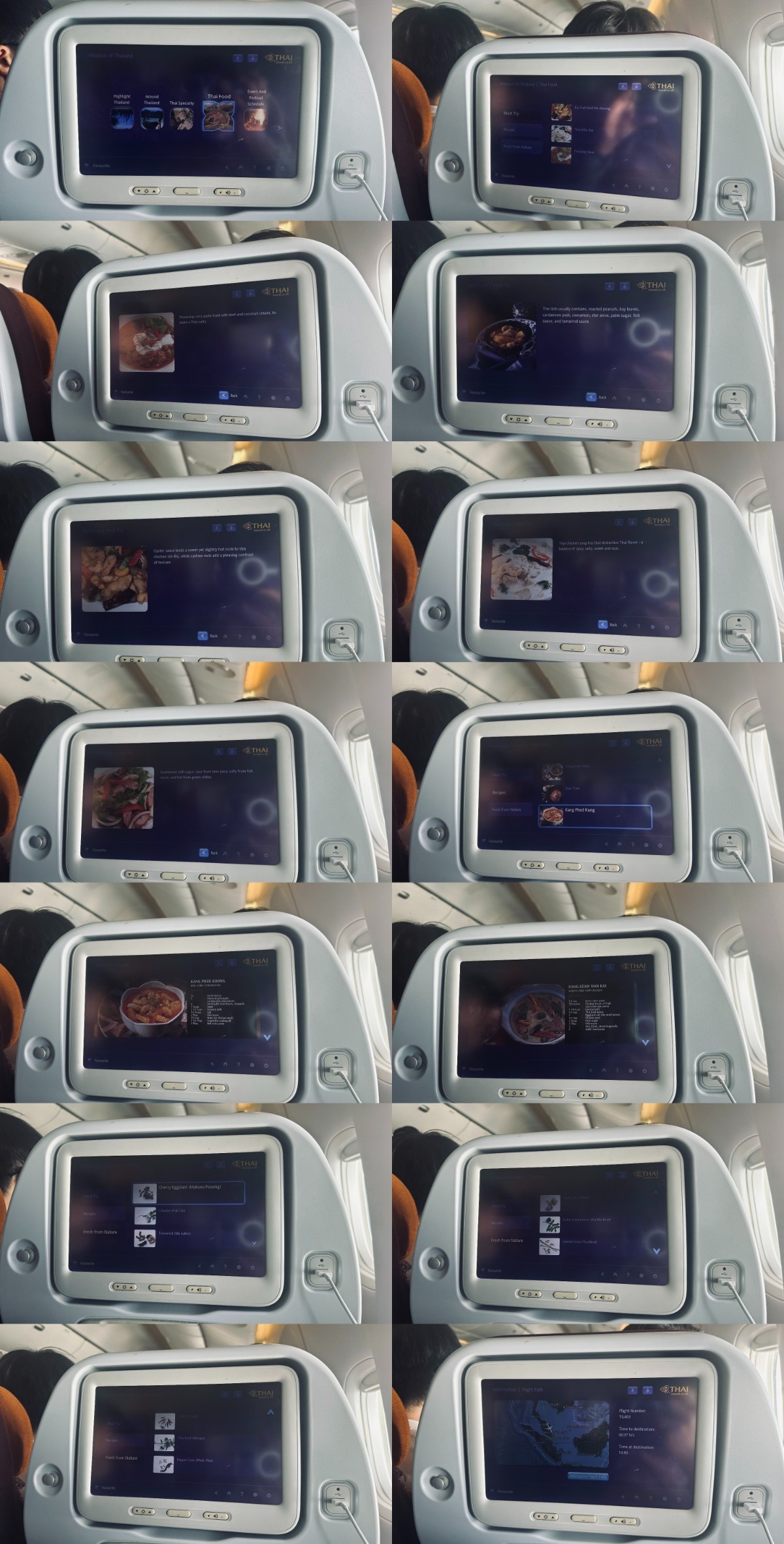
Just like that, the skyshow had completed 3/4ths of its two-hour runtime, and some ads were screened during the descent, including the oft-repeated Thailand Privilege luxury concierge services and Singha beer.
Honestly, I’ve seen these far too often, as a bunch of Thailand-related ads — Thai Airways’ A320 regional business-class product, Thailand Privilege, Muay Thai — are screened over and over on a big display outside my office building-cum-mall in Novena in central Singapore. This was put up by Plan B, a Thai advertising company, which you’ll also find all over Bangkok… and beyond a point it gets on one’s nerves.
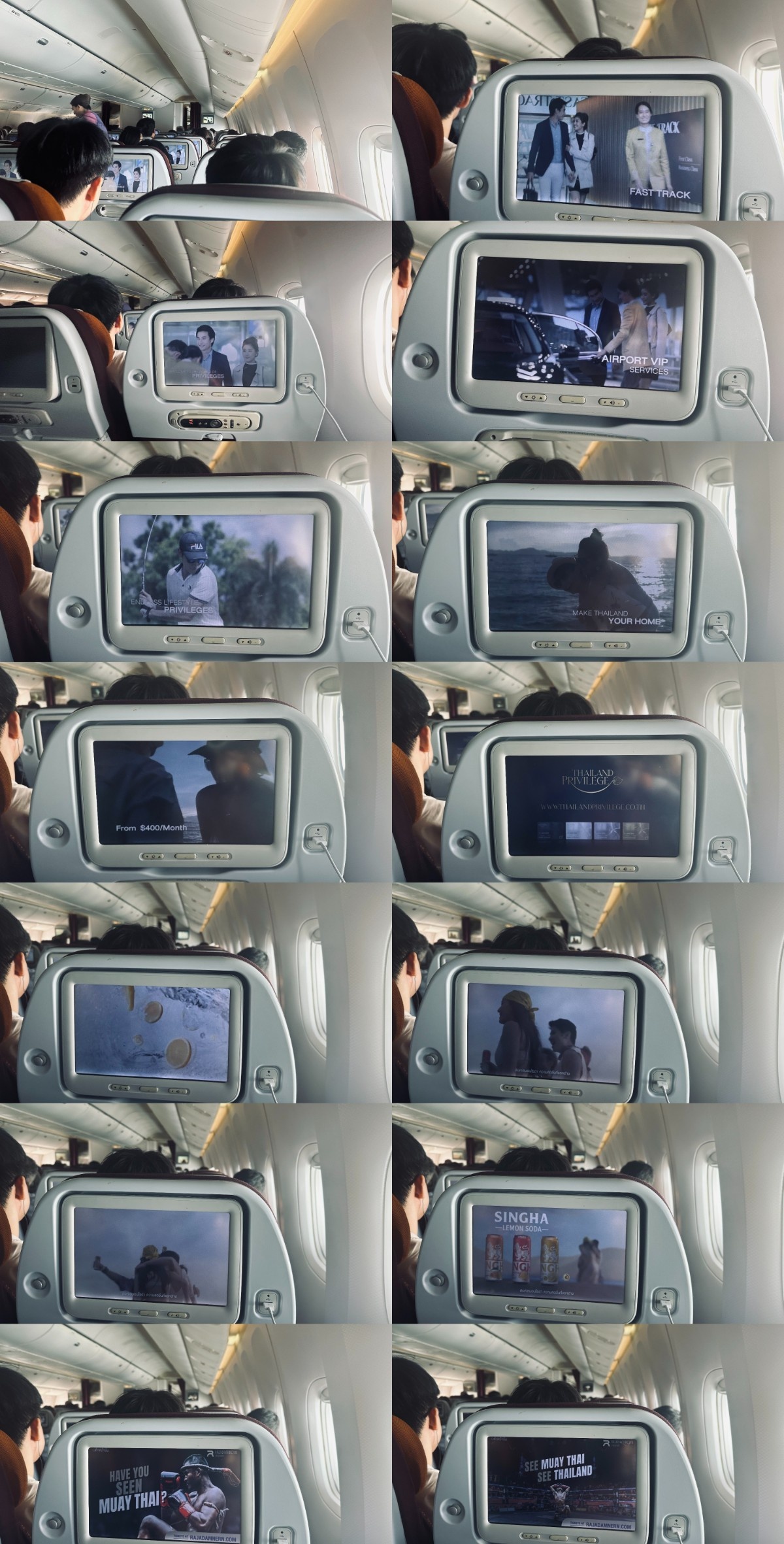
Well, at last I could add to my journal entry from the previous day by scribbling ‘Phetchabun the Possessive Stalker’ with a large pink highlighter over it!
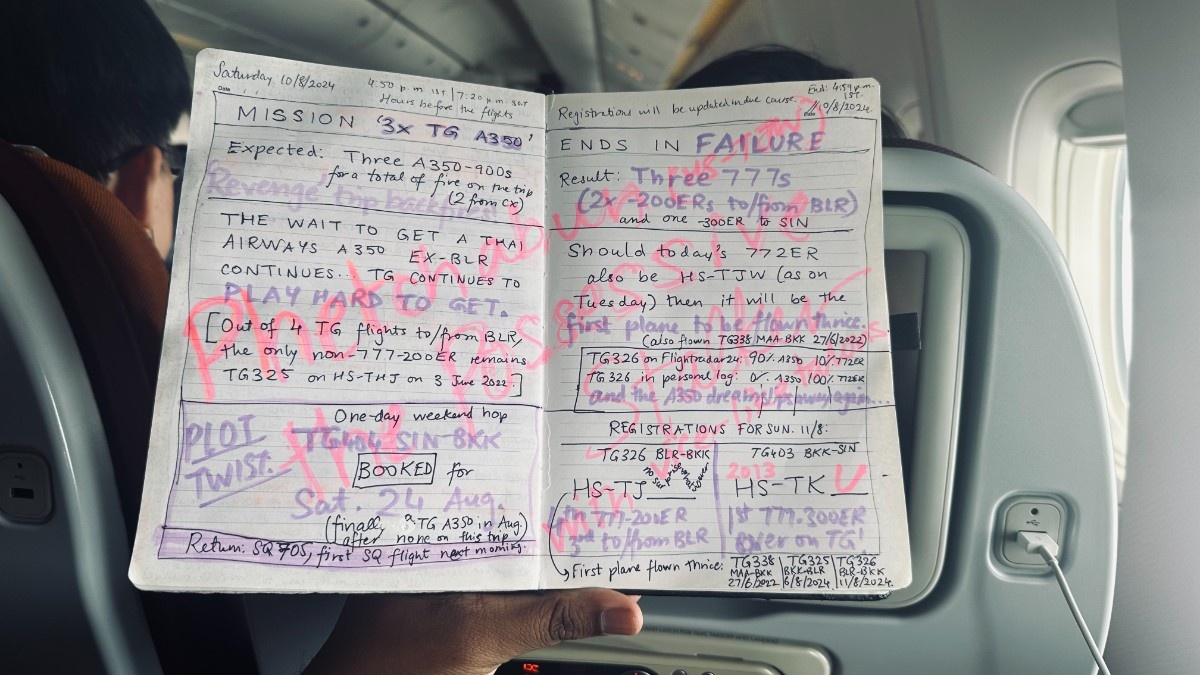
Changi’s humdrum Terminal One(world) again
Some 100 minutes into the flight (11:05 SGT) we finally commenced descent into Singapore Changi Airport. There’s never a dull moment when landing at Changi, between the peaceful waters, the ships in the sea and the verdant green of the Singaporean and southern Malaysian countryside. If only there were the all-important tail camera to complete the package…
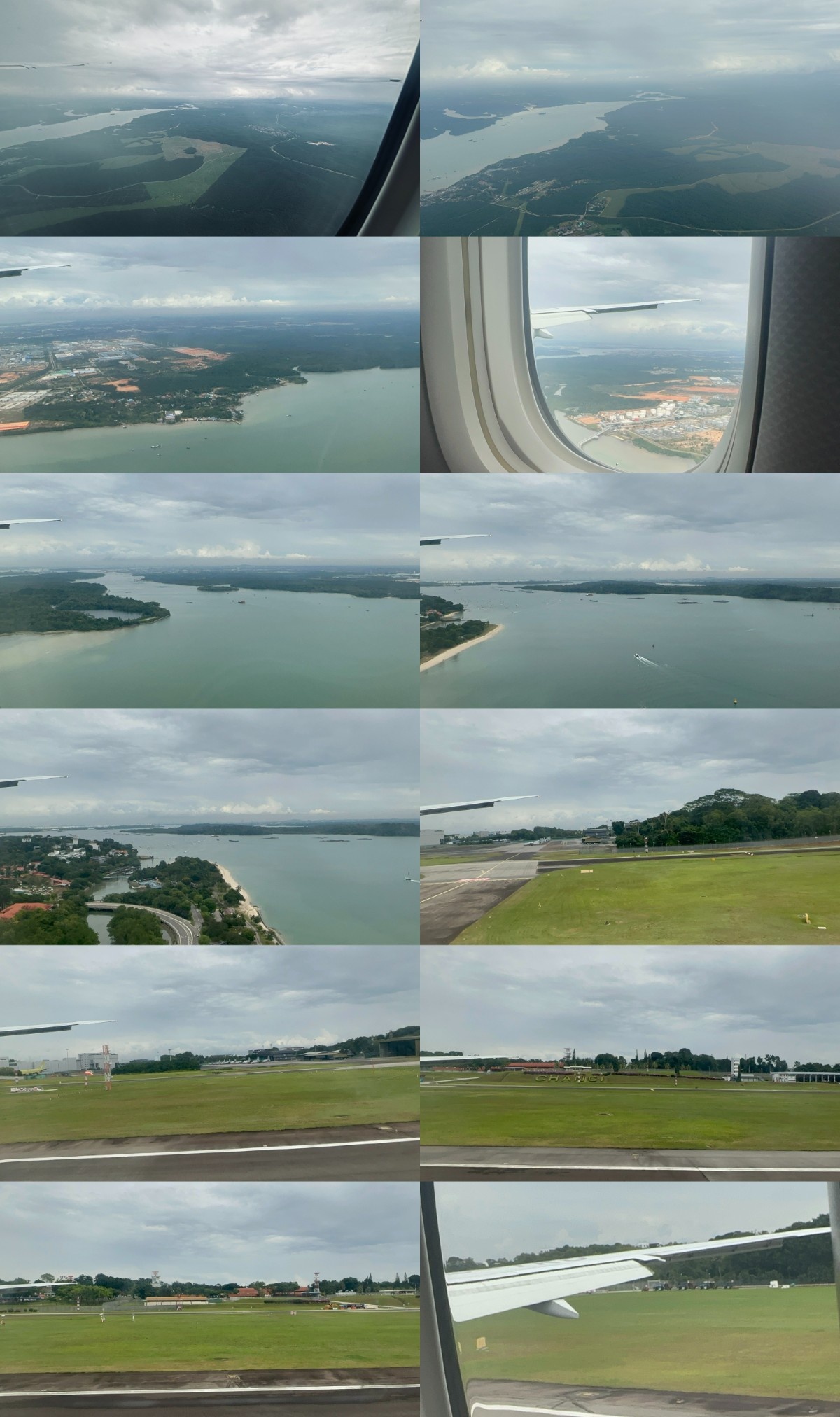
Finally, at a quarter past 11, the 777-300ER’s wheels kissed the ground at Changi, with a pair of Garuda aircraft in view: an A330-900 as GA828 from Jakarta — PK-GHE, the same one I’d flown two months before to Jakarta — parked at the gate, and a 737-800 (PK-GFG as GA854 from Surabaya) taxiing behind.
Sadly, since February 2025, Garuda Indonesia has completely stopped flying widebodies to Changi, and all services are only on 737-800s. Admittedly this was very likely a result of its new partnership with Singapore Airlines, whereby it was able to boost Jakarta–Singapore frequencies from 4x to 6x daily — but at the expense of all the A330s and 777s. In general, GA is doing much worse than money-bleeding regional rivals TG and MH, with zero product development and fleet orders whatsoever.
At least partnering with SQ, the biggest airline to Indonesia by capacity — in spite of being a direct and much more successful rival from a different alliance! — seems to be doing it some good.
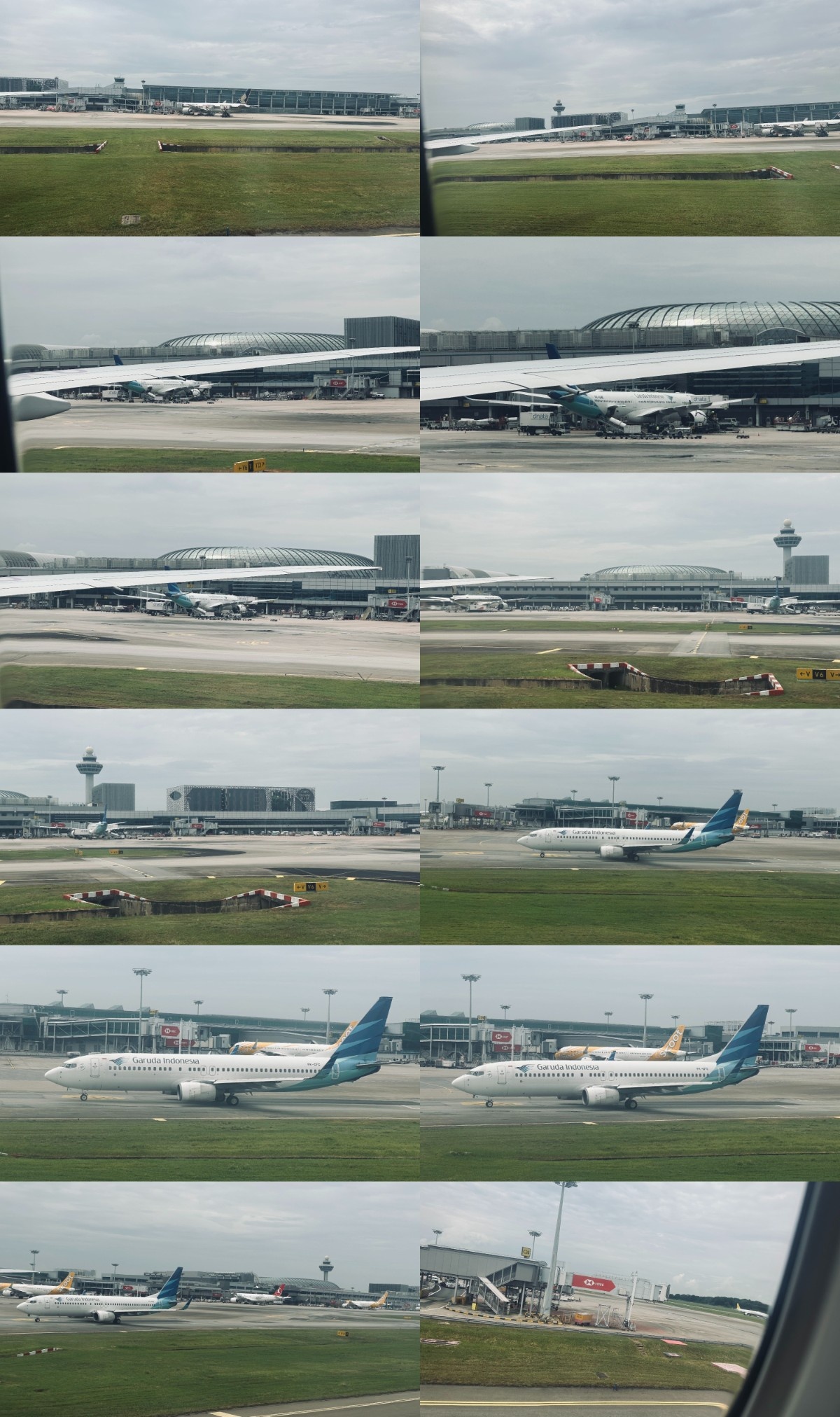
These were some of the aircraft on the ground at the time, including some Mainland Chinese 737-800s — China Eastern, Shenzhen, Hainan — plus a Turkish A350 and a Cambodia Airways A320, the latter of which I’d later spot at the terminal.
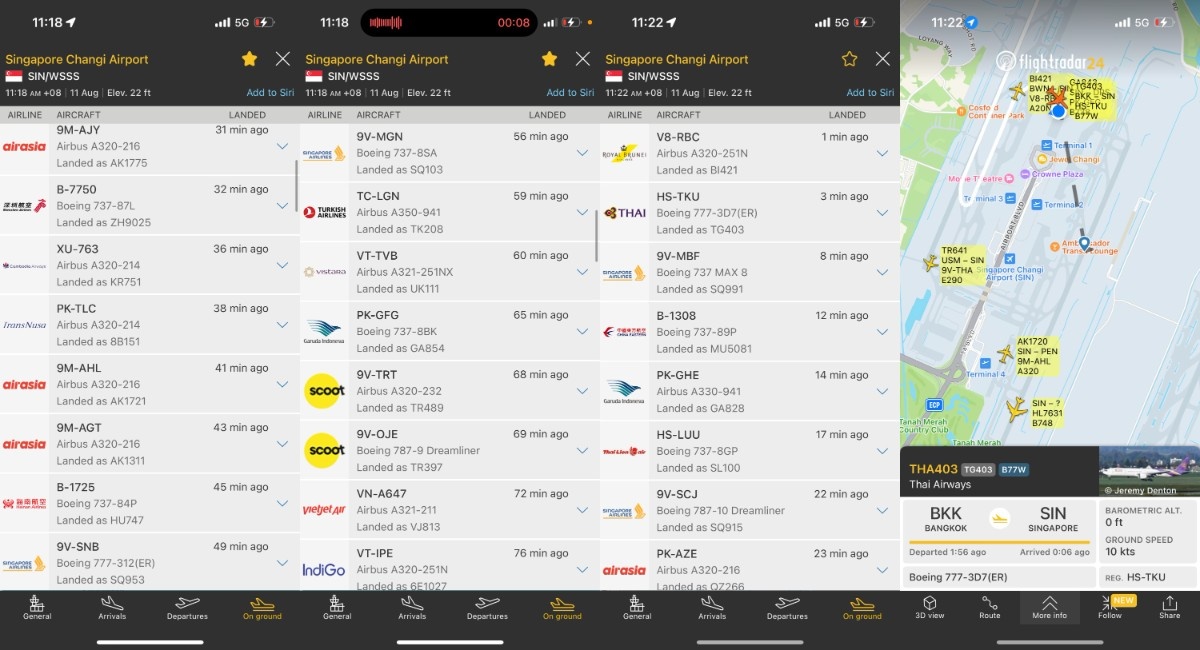
I had a look at the intricate mural placed on the rear bulkhead, then made my way out of the 777-300ER and thanked the cabin crew. While not the most modern A350 with all its creature comforts (and tail camera!), this was still infinitely better than the previous aircraft.
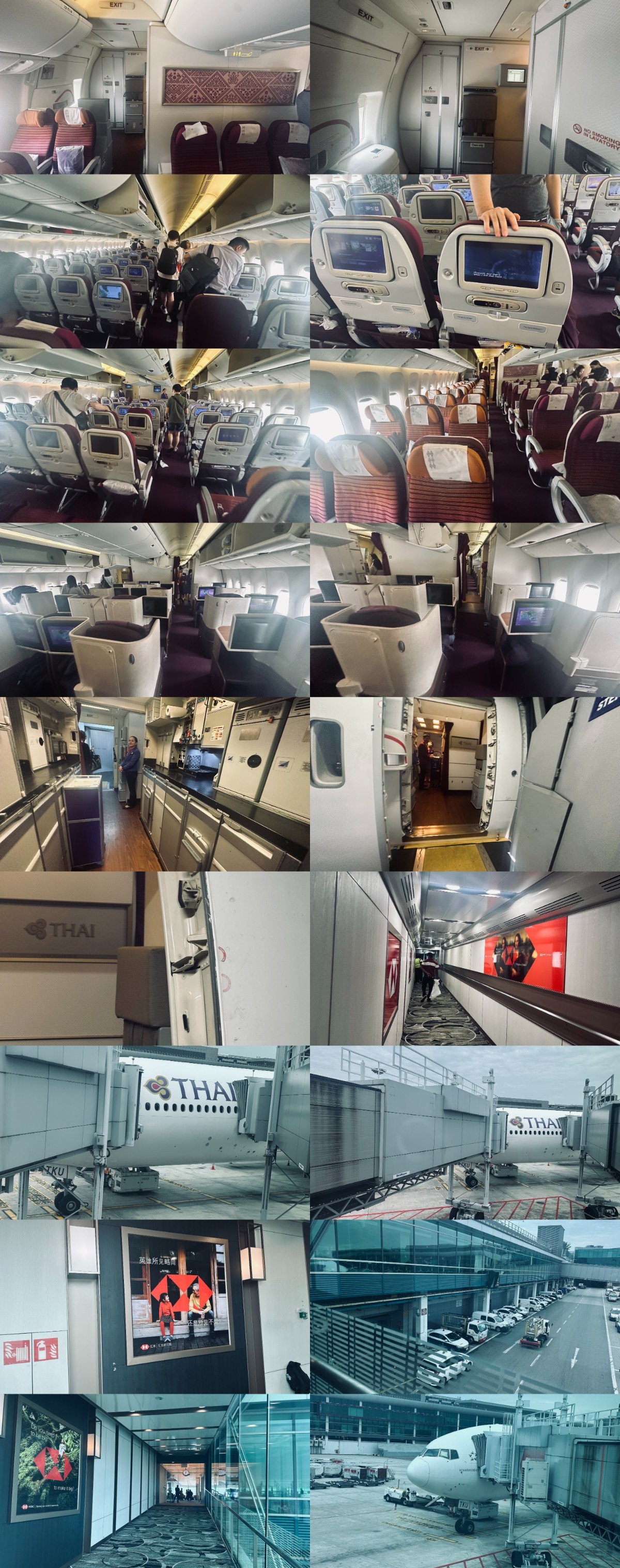
I’m so accustomed to flying TG from Changi Terminal 1 that it will take some getting used to the fact that Thai Airways moved its Changi operations from Terminal 2 — where most other Star Alliance members belong — in February 2025. I nickname this place ‘Terminal One(world)’ for a reason, and besides the SkyTeam pair of Air France and KLM — which partner with Qantas from Oneworld and use its outstanding lounges — are here as well.
Turkish Airlines is the only major global Star Alliance member still at T1, alongside the Mainland Chinese duo of Air China and Shenzhen Airlines. Meanwhile Terminal 3 — aside from hosting SQ’s Indian and non-Asian operations — is where the Northeast Asian pair of Asiana Airlines* and EVA Air operate, with all the others at T2.
As such, almost all Star passengers in premium cabins (or with Gold status) enjoy access to the SQ lounges in T2 and T3… but for those flying Turkish or Air China, it’s much more arduous.
*Asiana will soon cease to exist after the integration with the now-rebranded Korean Air is completed, which is why I’m flying it to Tokyo — on the A350 to Incheon and the A380 to Narita — in May 2025!
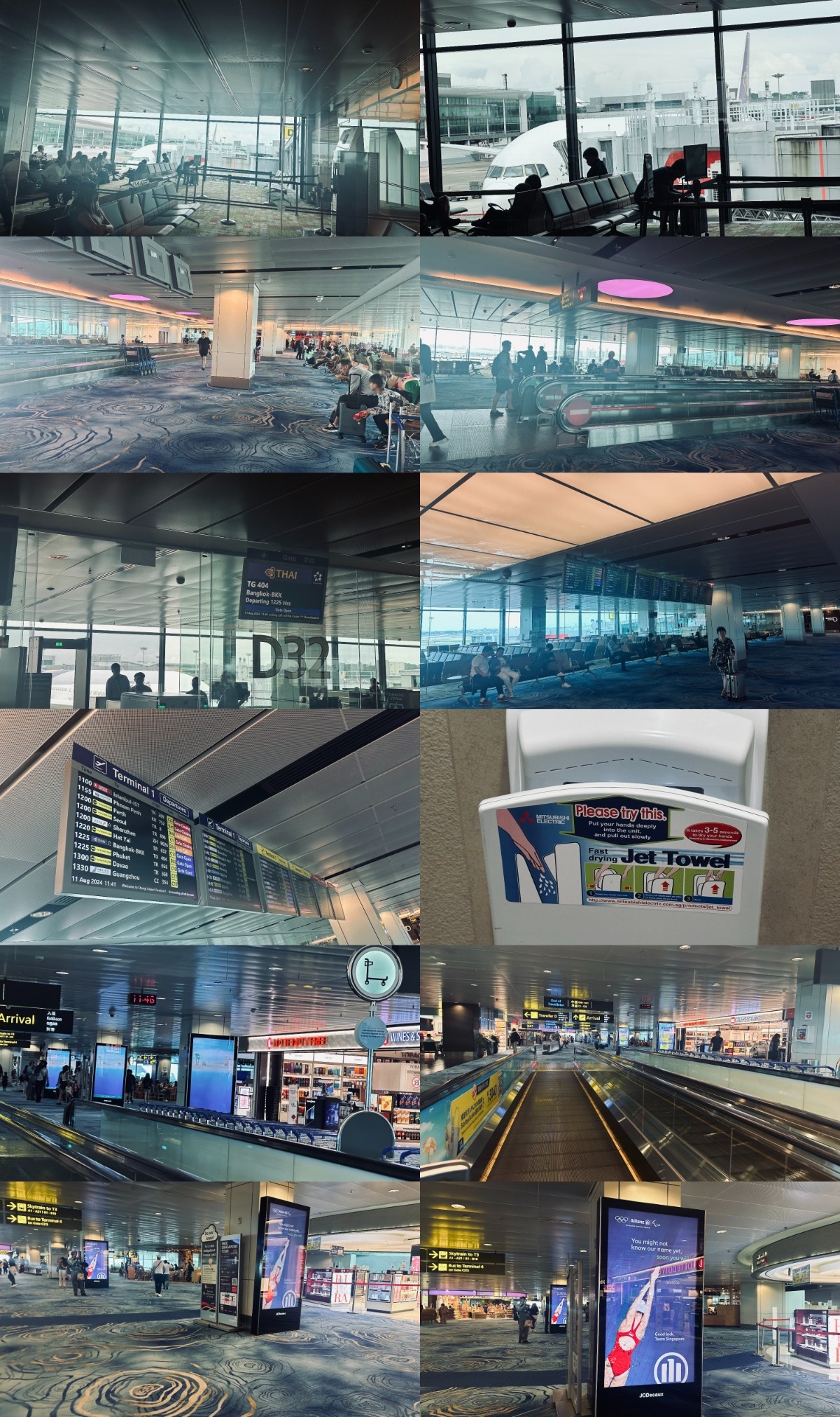
After hitting the toilet — hence the very random picture of a hand dryer with Please try this. above — and moving around T2 for a bit, I spotted a rare visitor: Cambodia Airways’ sharkletted A320, XU-763.
Little did I know that I would myself visit that country in three months’ time, and even fly Qatar Airways on the fifth-freedom route from Phnom Penh to Ho Chi Minh City — though not without a lot of drama!
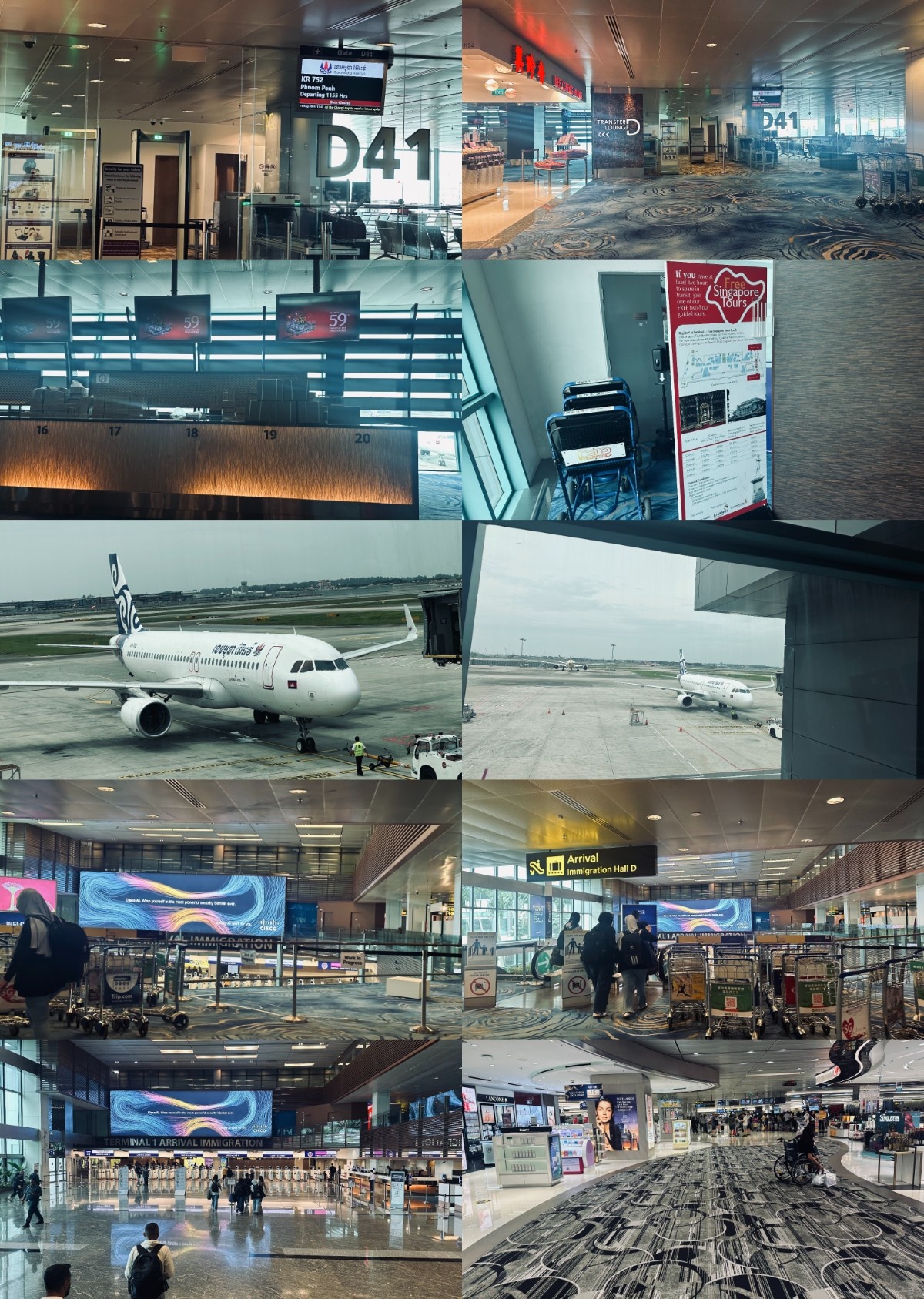
At length, I proceeded to Immigration and onward to the luggage belts, where there was a healthy crowd assembled. It often is the case where all the other bags from a flight have been collected and mine is standing forlornly in a corner, but this wasn’t one of those times. Quite to the contrary — the passengers (of whom many were Western) were all huddled around the carousel, waiting for their luggage to turn up!
Once I collected mine, I went out past the entrance to the Jewel Changi megamall, which draws in millions of tourists in its own right.
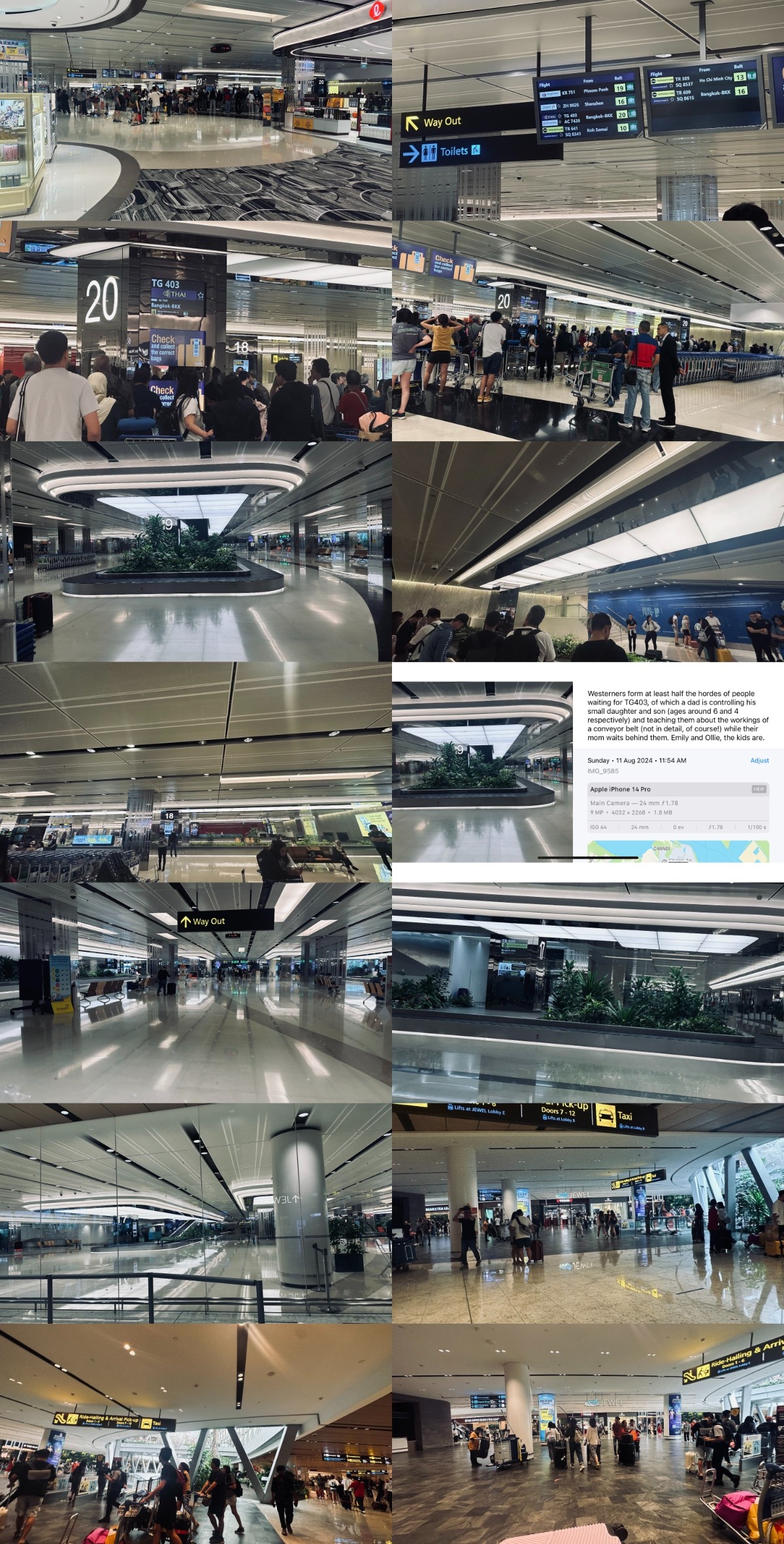
Going down a couple of levels, I bundled myself into the Toyota Noah minivan with its sliding doors — fairly common in Singapore alongside its twin the Voxy (not to mention the Alphard/Vellfire as well) — and set out on the zippy, mere 15-minute journey home. What a far cry this was compared to the stressful 2-hour ride some 12 hours before amid the infamous traffic snarls of Bengaluru!
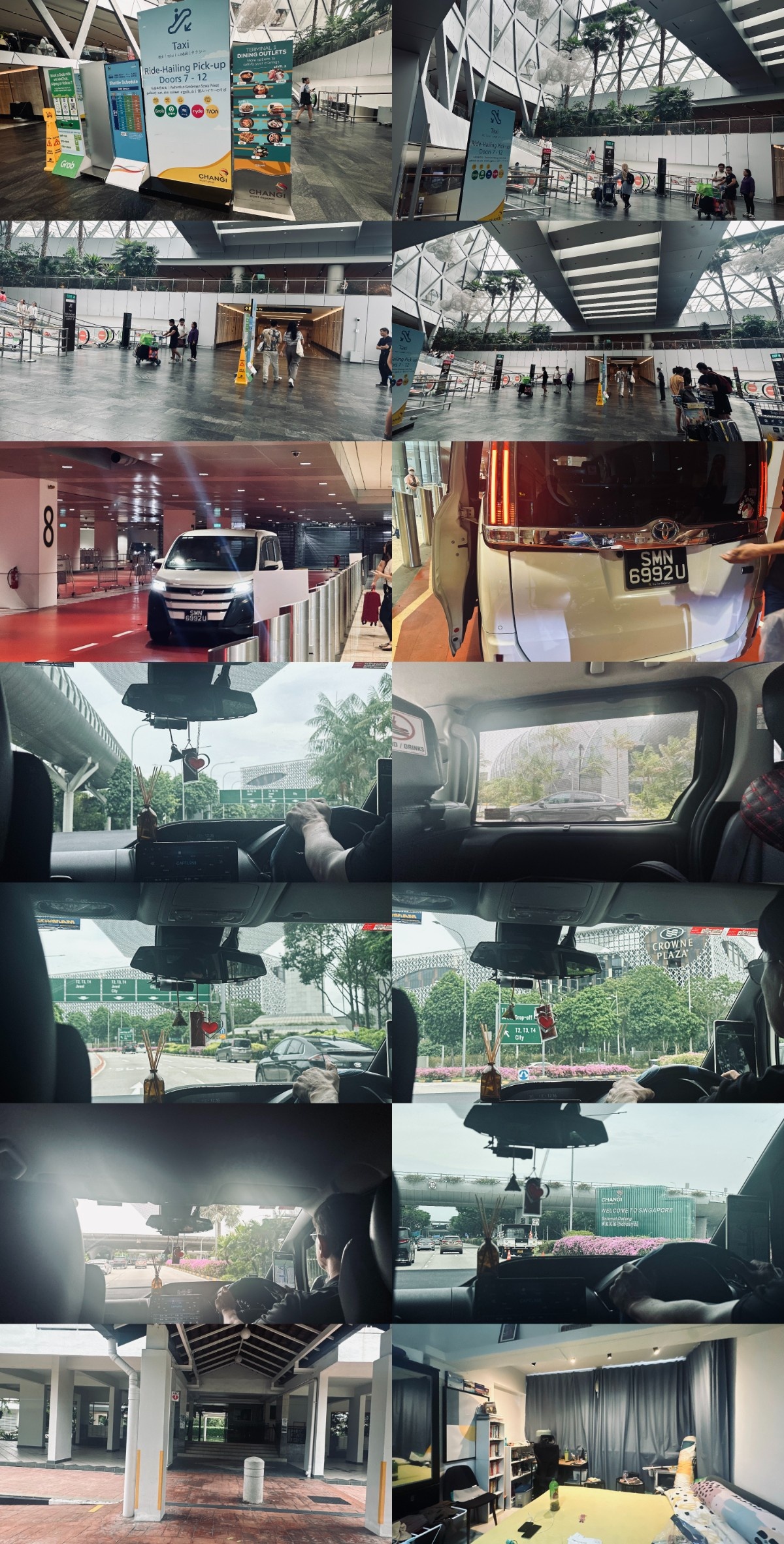
I wasn’t quite done yet: when my parents texted that such flights are a big struggle — erokom flight khubi koshter in Bengali below — I countered by saying that IndiGo is by far the worst of all when it comes to timing. The largest Indian airline has a penchant for landing between 2 and 5 in the morning on many of its Southeast Asian routes, which are no less than a torture.
Then I drifted off into a deep sleep for a few hours. Later that night I received a survey link from Thai Airways asking for feedback about the passenger experience — and, my word, I ripped the first flight to shreds in my reply. There’s a LOT to read below, such was my frustration on receiving that 777-200ER yet again (hopefully for the last time)… and at the end came another survey for the Star Alliance, but there I was much kinder by comparison!

